Motorola Solutions 92FT4915 Mobile 2-Way Radio User Manual Installation Manual 1 of 2
Motorola Solutions, Inc. Mobile 2-Way Radio Installation Manual 1 of 2
Contents
- 1. Ex8a RF Safety Guide
- 2. Ex8b User Manual
- 3. Installation Manual 1 of 2
- 4. Installation Manual 2of 2
Installation Manual 1 of 2
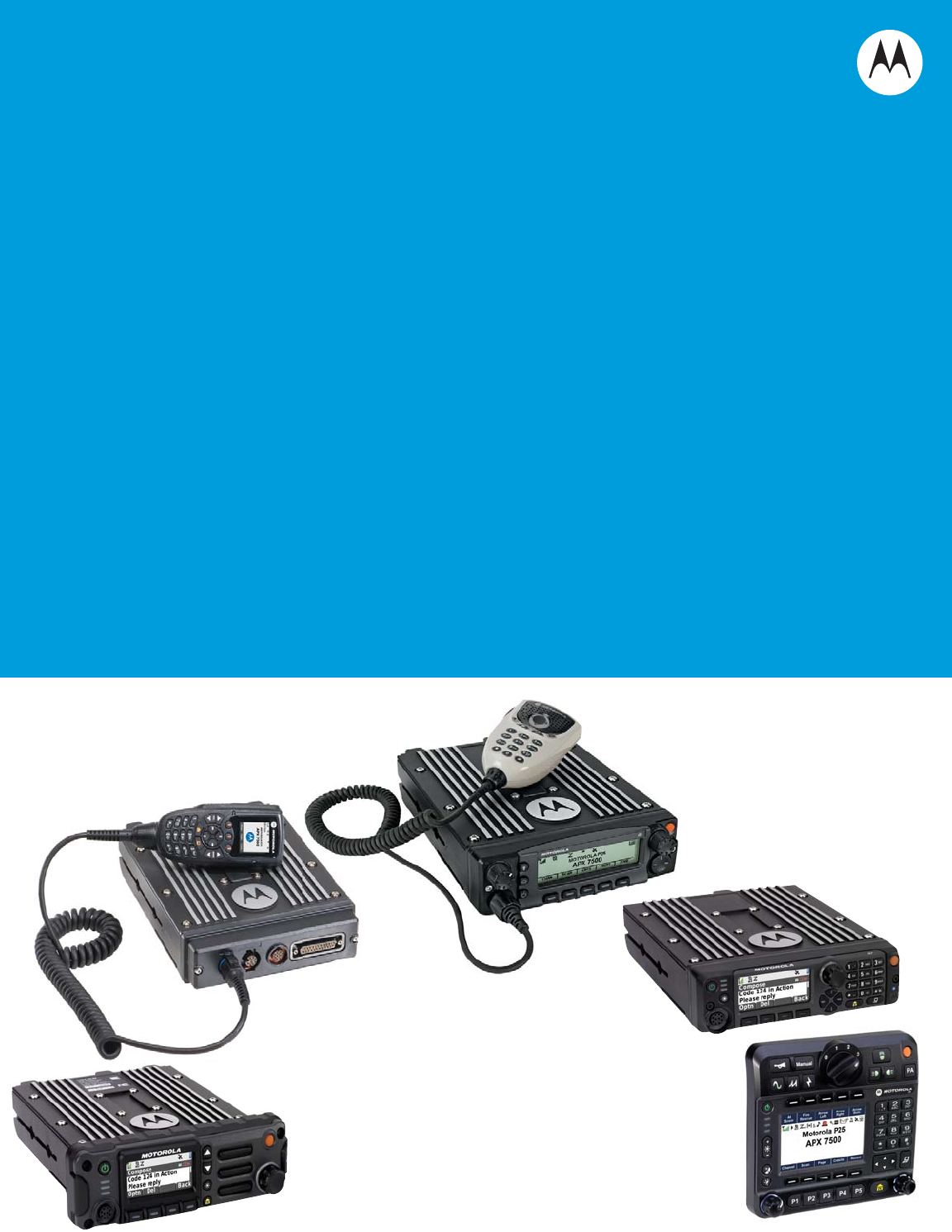
APX™ TWO-WAY RADIOS
APX MOBILES
O2, O3, O5, O7 & O9
CONTROL HEAD
INSTALLATION MANUAL

0

i
Foreword
This manual covers the O2, O3, O5, O7 and O9 models of the ASTRO® APX™ mobile radios. It includes all the information
necessary to install mid power and high power radios, and configure radio installation inside vehicles.
For details on radio operation or component-level troubleshooting, refer to the applicable manuals available separately. A
list of related publications is provided in the section “Related Publications,” on page vi.
RF Energy Exposure and Product Safety Guide for Mobile Two-way Radios
See “Installation Requirements for Compliance with Radio Frequency (RF) Energy Exposure Safety Standards,” on page ii.
Manual Revisions
Changes which occur after this manual is printed are described in PMRs (Publication Manual Revisions). These PMRs
provide complete replacement pages for all added, changed, and deleted items.
To obtain PMRs, go to https://businessonline.motorola.com.
Parts Ordering
See Appendix A: Replacement Parts Ordering for information on how to obtain replacement parts. For part numbers, refer
to the ASTRO APX Mobile Radio Basic Service Manual (Motorola publication part number 6875964M01).
Computer Software Copyrights
The Motorola products described in this manual may include copyrighted Motorola computer programs stored in
semiconductor memories or other media. Laws in the United States and other countries preserve for Motorola certain
exclusive rights for copyrighted computer programs, including, but not limited to, the exclusive right to copy or reproduce in
any form the copyrighted computer program. Accordingly, any copyrighted Motorola computer programs contained in the
Motorola products described in this manual may not be copied, reproduced, modified, reverse-engineered, or distributed in
any manner without the express written permission of Motorola. Furthermore, the purchase of Motorola products shall not
be deemed to grant either directly or by implication, estoppel, or otherwise, any license under the copyrights, patents or
patent applications of Motorola, except for the normal non-exclusive license to use that arises by operation of law in the
sale of a product.
Document Copyrights
No duplication or distribution of this document or any portion thereof shall take place without the express written permission
of Motorola. No part of this manual may be reproduced, distributed, or transmitted in any form or by any means, electronic
or mechanical, for any purpose without the express written permission of Motorola.
Disclaimer
The information in this document is carefully examined, and is believed to be entirely reliable. However, no responsibility is
assumed for inaccuracies. Furthermore, Motorola reserves the right to make changes to any products herein to improve
readability, function, or design. Motorola does not assume any liability arising out of the applications or use of any product
or circuit described herein; nor does it cover any license under its patent rights nor the rights of others.
Trademarks
MOTOROLA, MOTO, MOTOROLA SOLUTIONS and the Stylized M logo are trademarks or registered trademarks of
Motorola Trademark Holdings, LLC and are used under license. All other trademarks are the property of their respective
owners.
© 2009 – 2012 by Motorola Solutions, Inc.
All rights reserved.

ii
Installation Requirements for Compliance with
Radio Frequency (RF) Energy Exposure Safety
Standards
ATTENTION!
This radio is intended for use in occupational/controlled conditions, where users have full knowledge
of their exposure and can exercise control over their exposure to meet FCC limits. This radio device is
NOT authorized for general population, consumer, or any other use.
To ensure compliance to RF Energy Safety Standards:
• Install only Motorola approved antennas and accessories
• Be sure that antenna installation is per “Antenna Installation,” on page 2-38 of this manual
• Be sure that Product Safety and RF Safety Booklet enclosed with this radio is available to the end user
upon completion of the installation of this radio
Before using this product, read the guide enclosed with your radio which contains important operating
instructions for safe usage and RF energy awareness and control for compliance with applicable standards
and regulations.
For a list of Motorola-approved antennas and other accessories, visit the following web site which lists
approved accessories for your radio model: http://www.motorolasolutions.com.

Table of Contents iii
6878215A01
Table of Contents
Foreword..........................................................................................................i
RF Energy Exposure and Product Safety Guide for Mobile Two-way Radios..............................................i
Manual Revisions .........................................................................................................................................i
Parts Ordering ..............................................................................................................................................i
Computer Software Copyrights ....................................................................................................................i
Document Copyrights ...................................................................................................................................i
Disclaimer.....................................................................................................................................................i
Trademarks ..................................................................................................................................................i
Installation Requirements for Compliance with
Radio Frequency (RF) Energy Exposure Safety Standards.......................ii
Mobile Radio Model Numbering Scheme..................................................xiii
Commercial Warranty ..................................................................................xv
Limited Warranty .......................................................................................................................................xv
MOTOROLA COMMUNICATION PRODUCTS...............................................................................xv
I. What This Warranty Covers And For How Long ....................................................................xv
II. General Provisions ................................................................................................................xv
III. State Law Rights ................................................................................................................. xvi
IV. How To Get Warranty Service ............................................................................................ xvi
V. What This Warranty Does Not Cover................................................................................... xvi
VI. Patent And Software Provisions ........................................................................................ xvii
VII. Governing Law.................................................................................................................. xvii
Chapter 1 Introduction ......................................................................... 1-1
1.1 Mobile Radio Description............................................................................................................... 1-1
1.1.1 Dimensions ....................................................................................................................... 1-1
1.2 Standard Configurations ................................................................................................................ 1-5
1.2.1 Dash Mount Configuration ................................................................................................ 1-5
1.2.2 Remote Mount Configuration............................................................................................ 1-7
1.2.3 Multi Control Head .......................................................................................................... 1-13
1.3 Motorcycle Configurations ........................................................................................................... 1-14
1.4 Base/Control Stations .................................................................................................................. 1-14
1.5 Tools Required for APX Mobile Installations ............................................................................... 1-14
Chapter 2 Standard Configurations.................................................... 2-1
2.1 Planning the Installation................................................................................................................. 2-1
2.1.3 Radio Operation Wiring for Dash and Remote Configurations ....................................... 2-14
2.1.3.1 Dash Mount: Power, Ignition, and Emergency Cable Installation.......................... 2-14
2.1.3.2 Remote Mount: Power, Ignition, and Emergency Cable Installation...................... 2-15
2.1.4 Ignition Sense Switch (Radio Wide Advance) ................................................................ 2-17
2.1.5 Siren/PA Configuration/Programming............................................................................. 2-18

iv Table of Contents
6878215A01
2.2 Radio Mounting ........................................................................................................................... 2-19
2.2.2 Remote Mount with Trunnion.......................................................................................... 2-23
2.2.2.1 100W Radios Only................................................................................................. 2-24
2.2.2.2 Remote Mount Control Head Installation............................................................... 2-24
2.2.2.3 Multiple Control Head Installation.......................................................................... 2-27
2.2.2.4 Cable Installation ................................................................................................... 2-29
2.2.2.5 Setting the Initial Control Head ID ......................................................................... 2-29
2.2.2.6 O3 Control Head and Remote Mount Cabling....................................................... 2-30
2.2.3 Locking Kit (Optional) .....................................................................................................2-32
2.2.3.1 All Radios Except 100W ........................................................................................ 2-32
2.2.3.2 100W Radios ......................................................................................................... 2-32
2.3 Power Cables (Transceiver and Control Head) ........................................................................... 2-33
2.3.1 Optional Locking Feature for High Power Chassis Power Cables.................................. 2-33
2.3.2 O2, O5, O7 or O9 Control Head Power Cables.............................................................. 2-36
2.3.3 Battery Selector Switch................................................................................................... 2-37
2.4 Antenna Installation ..................................................................................................................... 2-38
2.4.1 Selecting an Antenna Site/Location on a Metal Body Vehicle ........................................ 2-38
2.4.2 Mini-UHF Connection ..................................................................................................... 2-40
2.4.3 GPS Antenna Placement................................................................................................ 2-42
2.4.4 GPS Connection .............................................................................................................2-42
2.5 Speaker ....................................................................................................................................... 2-43
2.5.1 Internal Speaker Disassembly ........................................................................................ 2-44
2.6 Microphone Hang-Up Clip ........................................................................................................... 2-46
2.6.1 Standard or O3 Control Head Hang-Up Clip .................................................................. 2-46
2.7 RFID (Option) .............................................................................................................................. 2-46
2.7.1 RFID Reading ................................................................................................................. 2-48
2.7.2 Programming RFID (If Equipped) ................................................................................... 2-51
2.8 Completing the Installation .......................................................................................................... 2-52
Chapter 3 Universal Relay Controller Installation ............................. 3-1
3.1 Universal Relay Controller Mounting ............................................................................................. 3-1
3.2 O7/O9 Universal Relay Controller Cable Assembly ...................................................................... 3-3
3.2.1 Power Cable ..................................................................................................................... 3-3
3.2.2 Ground Cable ................................................................................................................... 3-3
3.2.3 Wires ................................................................................................................................ 3-4
3.2.4 O7/O9 to URC Cable........................................................................................................ 3-5
Chapter 4 Options and Accessories Installation ............................... 4-1
4.1 Dash-Mount Accessory Installation ............................................................................................... 4-1
4.1.1 Dash-Mount Emergency Pushbutton or Footswitch Installation ....................................... 4-1
4.1.2 Dash-Mount Horn and Lights (External Alarms) Relays ................................................... 4-2
4.2 Remote-Mount Accessory Installation ........................................................................................... 4-2
4.2.1 Emergency Pushbutton or Footswitch Installation............................................................ 4-3
4.2.2 Horn (External Alarm) Relay Installation........................................................................... 4-4
4.2.3 Lights (External Alarm) Relay Installation......................................................................... 4-4
4.2.4 Gunlock Installation .......................................................................................................... 4-4
4.2.5 Horn-Ring Transfer ........................................................................................................... 4-5
4.2.6 Record Audio Out Jack of Transmit and Receive Audio................................................... 4-5
4.2.7 Earphone Jack.................................................................................................................. 4-5
4.2.8 USB Data Cables.............................................................................................................. 4-6
4.2.9 RS232 Cables .................................................................................................................. 4-6

Table of Contents v
6878215A01
4.3 Vehicle Interface Port Overview .................................................................................................... 4-6
4.3.1 VIP Output Connections ................................................................................................... 4-7
4.3.2 VIP Input Connections ......................................................................................................4-8
4.4 Compatibility of Emergency when Attaching a Siren ..................................................................... 4-9
4.5 Accessory Connector Assembly Details (P2) (All Models Except 100W).................................... 4-10
4.5.1 Disassembly and Assembly ............................................................................................ 4-10
4.5.1.1 Disassembly .......................................................................................................... 4-10
4.5.1.2 Assembly ............................................................................................................... 4-11
4.5.2 Adapter Cable................................................................................................................. 4-12
4.6 Memory and Three-Day Secure Key Retention Option ............................................................... 4-12
Chapter 5 Motorcycle Radio Installation ............................................ 5-1
5.1 Motorcycle Radio Description ........................................................................................................ 5-1
5.1.1 Transceiver Enclosure ......................................................................................................5-1
5.1.2 Control/Display Unit .......................................................................................................... 5-1
5.1.3 Control Head Cable .......................................................................................................... 5-2
5.1.4 Microphone ....................................................................................................................... 5-2
5.1.5 Keypad Mic ....................................................................................................................... 5-2
5.1.6 External Speaker .............................................................................................................. 5-2
5.1.7 Headset Capability............................................................................................................ 5-2
5.1.8 Antenna ............................................................................................................................ 5-2
5.1.9 Ignition Sense (ACC) Wire................................................................................................ 5-2
5.2 Installation Overview...................................................................................................................... 5-3
5.2.1 General ............................................................................................................................. 5-3
5.2.2 Important Installation Hints ...............................................................................................5-4
5.2.3 Parts Identification ............................................................................................................ 5-5
5.2.4 Order of Installation .......................................................................................................... 5-5
5.3 Installing the Universal Mounting Plate.......................................................................................... 5-6
5.4 Installing the Speaker and Control Head ....................................................................................... 5-7
5.4.1 Handlebar Installation with Speaker and Control Head Mounted Together...................... 5-8
5.4.2 Fuel Tank Console Installation with Speaker and Control Head Mounted Together ........ 5-9
5.4.3 Handlebar Installation with Speaker and Control Head Mounted Separately ................. 5-11
5.4.4 Fuel Tank Console Installation with Speaker and Control Head Mounted Separately ... 5-12
5.5 Installing the Speaker .................................................................................................................. 5-14
5.6 Installing the Microphone Hang-Up Clip ...................................................................................... 5-14
5.6.1 Extension Bracket Mounting ........................................................................................... 5-14
5.6.2 Speaker/Control Head Bracket Side Mounting ............................................................... 5-14
5.6.3 Other Hang-Up Clip Mounting ........................................................................................ 5-15
5.7 Installing Antenna Base and Cables............................................................................................ 5-15
5.8 Installing the Antenna .................................................................................................................. 5-18
5.9 Cable Routing .............................................................................................................................. 5-18
5.10 Installing the Weather-Resistant Enclosure................................................................................. 5-21
5.11 Transceiver and Cabling Installation............................................................................................ 5-22
5.11.1 Installing Cabling in the Enclosure.................................................................................. 5-22
5.11.2 Installing the Transceiver................................................................................................5-23
5.12 Installing the Emergency Switch Option ......................................................................................5-25
5.13 Installing the External Alarm Relay Option ..................................................................................5-25
5.14 Installing the Headset Accessory................................................................................................. 5-25
5.15 Installing the O5 Control Head Sunshield....................................................................................5-26
5.16 Horn/Lights Wiring ....................................................................................................................... 5-28
5.17 Emergency Switch Wiring............................................................................................................ 5-28

vi Table of Contents
6878215A01
Chapter 6 Finishing the Installation.................................................... 6-1
6.1 Cable Connection .......................................................................................................................... 6-1
6.1.1 O2 Control Head............................................................................................................... 6-1
6.1.2 O3 Control Head............................................................................................................... 6-1
6.1.3 O5 Control Head............................................................................................................... 6-1
6.1.4 O7 Control Head............................................................................................................... 6-2
6.1.5 O9 Control Head............................................................................................................... 6-2
6.2 Dust Cover Installation .................................................................................................................. 6-3
6.3 Miscellaneous Information ............................................................................................................. 6-4
Chapter 7 Best Practices: Installation & Troubleshooting ............... 7-1
7.1 Check Wiring of Ignition and Radio Ignition Sensing..................................................................... 7-1
7.2 Check Physical Installation of Radio Ground and Radio Accessory Wiring .................................. 7-2
7.3 Improve the Electrical Quality of the Power and Ignition Lines ..................................................... 7-2
7.4 Minimize the Effect of Poorly Grounded Antennas........................................................................ 7-3
7.5 Jump-Start the Vehicle .................................................................................................................. 7-3
7.6 Eliminate Noise/Howling from PA Speaker ................................................................................... 7-3
Appendix A Replacement Parts Ordering..............................................A-1
A.1 Basic Ordering Information............................................................................................................ A-1
A.2 Motorola Online ............................................................................................................................. A-1
A.3 Mail Orders .................................................................................................................................... A-1
A.5 Fax Orders..................................................................................................................................... A-2
A.6 Parts Identification ......................................................................................................................... A-2
A.7 Product Customer Service............................................................................................................. A-2
A.8 Asia Pacific Service Centers ......................................................................................................... A-2
Index.....................................................................................................Index-1
Glossary.........................................................................................Glossary-1
Related Publications
ASTRO APX Mobile Radio O2 Control Head User Guide..........................................................68012006035
ASTRO APX Mobile Radio O3 Control Head User Guide ..........................................................6875946M01
ASTRO APX Mobile Radio O5 Control Head User Guide ..........................................................6875947M01
ASTRO APX Mobile Radio O7 Control Head User Guide..........................................................68012006034
ASTRO APX Mobile Radio O9 Control Head User Guide .........................................................68007024014
ASTRO APX Mobile Radio Basic Service Manual .....................................................................6875964M01
ASTRO APX Mobile Radio Detailed Service Manual .................................................................6875963M01

List of Figures vii
6878215A01
List of Figures
Figure 1-1. Front View of APX 7500 Mid Power Dash Mount Transceiver and Trunnion ....................... 1-1
Figure 1-2. Side View of APX 7500 Mid Power Dash Mount Transceiver and Trunnion......................... 1-1
Figure 1-3. Front View of APX 2500/4500 Mid Power Dash Mount Transceiver and Trunnion .............. 1-1
Figure 1-4. Side View of APX 2500/4500 Mid Power Dash Mount Transceiver and Trunnion................ 1-1
Figure 1-5. Front View of APX 7500 High Power (100W) Transceiver and Trunnion ............................. 1-2
Figure 1-6. Side View of APX 7500 High Power (100W) Transceiver and Trunnion............................... 1-2
Figure 1-7. Front View of O2 Control Head Attached to APX 7500 Mid Power Dash Mount
Transceiver and Trunnion ..................................................................................................... 1-2
Figure 1-8. Side View of O2 Control Head Attached to APX7500 Mid Power Dash Mount Transceiver
and Trunnion ......................................................................................................................... 1-2
Figure 1-9. Front View of O7 Control Head Attached to APX 2500 Mid Power Dash Mount
Transceiver and Trunnion ..................................................................................................... 1-2
Figure 1-10. Side View of O7 Control Head Attached to APX 2500 Mid Power Dash Mount Transceiver
and Trunnion ......................................................................................................................... 1-2
Figure 1-11. Front View of O3 Control Head with Coiled Cable................................................................ 1-3
Figure 1-12. Side View of O3 Control Head with Coiled Cable ................................................................. 1-3
Figure 1-13. Front View of O2 Control Head with Remote Mount and Trunnion....................................... 1-3
Figure 1-14. Side View of O2 Control Head with Remote Mount and Trunnion........................................ 1-3
Figure 1-15. Front View of O5 Control Head with Remote Mount and Trunnion....................................... 1-3
Figure 1-16. Side View of O5 Control Head with Remote Mount and Trunnion........................................ 1-3
Figure 1-17. Front View of O7 Control Head with Remote Mount and Trunnion....................................... 1-4
Figure 1-18. Side View of O7 Control Head with Remote Mount and Trunnion........................................ 1-4
Figure 1-19. Front View of O9 Control Head with Trunnion ...................................................................... 1-4
Figure 1-20. Side View of O9 Control Head with Trunnion........................................................................ 1-4
Figure 1-21. Top View of O9 Universal Relay Controller with Trunnion
(URC is an orderable accessory.) ......................................................................................... 1-4
Figure 1-22. Side View of O9 Universal Relay Controller with Trunnion
(URC is an orderable accessory.) ......................................................................................... 1-4
Figure 1-23. Dash Mount Configuration for O2 Control Head ................................................................... 1-5
Figure 1-24. Dash Mount Configuration for O3 Control Head ................................................................... 1-5
Figure 1-25. Dash Mount Configuration for O5 Control Head (Only Applicable for
ASTRO 25 Subscribers APX 5500/APX 6500/APX 7500/APX 6500 Li Mobile) ................... 1-6
Figure 1-26. Dash Mount Configuration for O7 Control Head ................................................................... 1-6
Figure 1-27. Remote Mount Configuration with Mid Power Transceiver, Transceiver Interface Board,
CHIB Rear Assembly and O2 Control Head......................................................................... 1-7
Figure 1-28. Remote Mount Configuration with Mid Power Transceiver, Transceiver Interface Board
and O3 Control Head ............................................................................................................ 1-7
Figure 1-29. Remote Mount Configuration with Mid Power Transceiver, Transceiver Interface Board,
CHIB Rear Assembly and O5 Control Head......................................................................... 1-8
Figure 1-30. Remote Mount Configuration with Mid Power Transceiver, Transceiver Interface Board,
CHIB Rear Assembly and O7 Control Head......................................................................... 1-8
Figure 1-31. Remote Mount Configuration with Mid Power Transceiver, Transceiver Interface Board
and O9 Control Head ............................................................................................................ 1-8
Figure 1-32. Remote Mount Configuration with High Power (100W) Radio Transceiver and
O2 Control Head ................................................................................................................... 1-9
Figure 1-33. Remote Mount Configuration with High Power (100W) Radio Transceiver and
O3 Control Head ................................................................................................................... 1-9
Figure 1-34. Remote Mount Configuration with High Power (100W) Radio Transceiver and
O5 Control Head ................................................................................................................... 1-9

viii List of Figures
6878215A01
Figure 1-35. Remote Mount Configuration with High Power (100W) Radio Transceiver and
O7 Control Head.................................................................................................................1-10
Figure 1-36. Remote Mount Configuration with High Power (100W) Radio Transceiver and
O9 Control Head.................................................................................................................1-10
Figure 1-37. Remote Mount Configuration with Mid Power Radio Transceiver,
Universal Relay Controller and O7 Control Head (URC is optional.)...................................1-11
Figure 1-38. Remote Mount Configuration with Mid Power Radio Transceiver,
Universal Relay Controller and O9 Control Head (URC is optional.)...................................1-11
Figure 1-39. Remote Mount Configuration with High Power (100W) Radio Transceiver,
Universal Relay Controller and O7 Control Head (URC is optional.).................................. 1-12
Figure 1-40. Remote Mount Configuration with High Power (100W) Radio Transceiver,
Universal Relay Controller and O9 Control Head (URC is optional.).................................. 1-12
Figure 2-1. Dash Mount Radios Can Be Located in the Middle Console, on the
Transmission Hump, or Under the Dash (See Figure 2-2 for 100W Radio Install) ............... 2-2
Figure 2-2. Remote Mount Radio Control Heads Can Be Located in the Middle
Console, on the Transmission Hump, or Under the Dash .................................................... 2-2
Figure 2-3. Remote Mount of the Radio, O9 Control Head
and Universal Relay Controller (URC is optional.)................................................................ 2-2
Figure 2-4. Radio Installation (O2 Mid Power Dash Mount).................................................................... 2-3
Figure 2-5. Radio Installation (O3 Mid Power Dash Mount).................................................................... 2-3
Figure 2-6. Radio Installation (O5 Mid Power Dash Mount).................................................................... 2-4
Figure 2-7. Radio Installation (O7 Mid Power Dash Mount).................................................................... 2-4
Figure 2-8. Radio Installation (O2 Mid Power Remote Mount) ............................................................... 2-5
Figure 2-9. Radio Installation (O3 Mid Power Remote Mount) ............................................................... 2-6
Figure 2-10. Radio Installation (O5 Mid Power Remote Mount) ............................................................... 2-6
Figure 2-11. Radio Installation (O7 Mid Power Remote Mount) ............................................................... 2-7
Figure 2-12. Radio Installation (O2 High Power Remote Mount).............................................................. 2-7
Figure 2-13. Radio Installation (O3 High Power Remote Mount).............................................................. 2-8
Figure 2-14. Radio Installation (O5 High Power Remote Mount).............................................................. 2-8
Figure 2-15. Radio Installation (O7 High Power Remote Mount).............................................................. 2-9
Figure 2-16. Radio Installation of O9 Remote Mount with Transceiver (URC is optional.) ....................... 2-9
Figure 2-17. Radio Installation (O9 Remote Mount with Pinouts) ........................................................... 2-10
Figure 2-18. Remote Control Head Pinouts ............................................................................................ 2-10
Figure 2-19. Cabling Interconnect Diagram for Dash Mount (Cannot Be Used for 100W Radios) ..........2-11
Figure 2-20. Cabling Interconnect Diagram for Remote Mount .............................................................. 2-12
Figure 2-21. Cabling Interconnect Diagram for 09 Remote Mount (URC is optional.) ............................ 2-13
Figure 2-22. APX 7500/ APX6500/ APX5500/ APX6500Li Mid Power Trunnion Orientation
(Cannot Be Used for 100W Radios) ................................................................................... 2-19
Figure 2-23. APX 2500/APX4500 Mid Power Trunnion
Orientation (Cannot Be Used for 100W Radios)................................................................. 2-20
Figure 2-24. Trunnion Orientation for 100W Radios ............................................................................... 2-20
Figure 2-25. Transmission Hump Trunnion Mounting ............................................................................. 2-22
Figure 2-26. Below Dash Trunnion Mounting.......................................................................................... 2-22
Figure 2-27. 100W Radio Mounting into Quick Release Trunnion .......................................................... 2-24
Figure 2-28. O5 Control Head Installation Exploded View
(Also applicable for O2 and O7 Control Heads) ................................................................. 2-25
Figure 2-29. O9 Control Head Installation Exploded View...................................................................... 2-26
Figure 2-30. O5 Control Head Rear View (Also applicable for O2 and O7 Control Heads).................... 2-26
Figure 2-31. O9 Control Head Rear View ............................................................................................... 2-27
Figure 2-32. Multiple Control Heads Example Configurations ................................................................ 2-28
Figure 2-33. APX Mobile O5 Control Head Front View........................................................................... 2-29
Figure 2-34. Radio Display with Current Control Head ID ...................................................................... 2-29
Figure 2-35. APX Mobile O5 Control Head Front View – Mode Knob .................................................... 2-30
Figure 2-36. O3 Control Head................................................................................................................. 2-30

List of Figures ix
6878215A01
Figure 2-37. O3 Control Head Rear View ............................................................................................... 2-31
Figure 2-38. Hang-Up Clip Installation Exploded View ........................................................................... 2-31
Figure 2-39. Locking Kit (Optional) (Cannot Be Used for 100W Radios) ................................................ 2-32
Figure 2-40. Lock Supplied with 100W Quick Release Trunnion ............................................................ 2-32
Figure 2-41. Bracket Installation.............................................................................................................. 2-33
Figure 2-42. Bracket Installation.............................................................................................................. 2-34
Figure 2-43. Bracket Installation (Assembled State) ............................................................................... 2-34
Figure 2-44. Bracket Uninstallation ......................................................................................................... 2-35
Figure 2-45. Bracket Uninstallation ......................................................................................................... 2-35
Figure 2-46. HKN6188_ Power Cable with External Speaker Connector ............................................... 2-36
Figure 2-47. HKN6187_ Power Cable with External Speaker Connector, Record Audio Output Jack
(2.5 mm) and Earphone Jack (2.5 mm) .............................................................................. 2-36
Figure 2-48. Battery Selector Switch....................................................................................................... 2-37
Figure 2-49. Multiple Antennas Separation ............................................................................................. 2-39
Figure 2-50. Mini-UHF Connection (As Shown on Mid Power) ............................................................... 2-40
Figure 2-51. Mini-UHF Connection (100W Radios Only) ........................................................................ 2-40
Figure 2-52. Mini-UHF Connector Tool (As Shown on Mid Power) ......................................................... 2-41
Figure 2-53. Mini-UHF Connector Tool (100W Radios Only) .................................................................. 2-41
Figure 2-54. GPS Antenna Connector on the Back of the Mid Power Radio.......................................... 2-42
Figure 2-55. GPS Antenna Connector on the Front of the 100W Radio ................................................. 2-42
Figure 2-56. Speaker Mounting ............................................................................................................... 2-43
Figure 2-57. Removing the screws on the Control Head ........................................................................ 2-44
Figure 2-58. Removing the Control Head................................................................................................ 2-44
Figure 2-59. Disconnecting the Speaker Connector ............................................................................... 2-45
Figure 2-60. Reattaching the Control Head............................................................................................. 2-45
Figure 2-61. RFID Location on Mid Power Radio....................................................................................2-46
Figure 2-62. RFID Location on APX 2500/APX 4500 Mid Power Radio ................................................. 2-46
Figure 2-63. RFID Location on High Power Radio .................................................................................. 2-47
Figure 2-64. Read Angle for Mid Power Radio........................................................................................ 2-48
Figure 2-65. Tag Angle for Mid Power Radio .......................................................................................... 2-48
Figure 2-66. Read Angle for APX 2500/APX 4500 Mid Power Radio ..................................................... 2-49
Figure 2-67. Tag Angle for APX 2500/APX 4500 Mid Power Radio ........................................................ 2-49
Figure 2-68. Read Angle for High Power Radio...................................................................................... 2-49
Figure 2-69. Tag Angle for High Power Radio......................................................................................... 2-50
Figure 2-70. Examples of Reader and Tag Aligned (Reader Orientation)............................................... 2-50
Figure 2-71. Example of Reader and Tag Misaligned (Reader Orientation) ........................................... 2-50
Figure 3-1. Universal Relay Controller Orientation.................................................................................. 3-1
Figure 3-2. Universal Relay Controller Installation Exploded View ......................................................... 3-2
Figure 3-3. Power and Ground Cable Glands ......................................................................................... 3-3
Figure 3-4. Cable Gland Assembly with Gasket...................................................................................... 3-4
Figure 3-5. Wires Installation................................................................................................................... 3-4
Figure 3-6. Wire Installation with Black Stick........................................................................................... 3-5
Figure 3-7. O7/O9 to URC Cable Installation .......................................................................................... 3-5
Figure 4-1. Emergency Switch Wiring Diagram ......................................................................................4-1
Figure 4-2. Horn/Light Wiring Diagram.................................................................................................... 4-2
Figure 4-3. Emergency Jumper Removal in Remote Mount ................................................................... 4-3
Figure 4-4. Gunlock Switch Redundancy Diagram ................................................................................. 4-4
Figure 4-5. Siren/PA Horn-Ring Connections.......................................................................................... 4-5
Figure 4-6. Remote Control Head Pinouts .............................................................................................. 4-6
Figure 4-7. HKN6196_ VIP Connector Detail.......................................................................................... 4-6
Figure 4-8. Relay Coil.............................................................................................................................. 4-7
Figure 4-9. Field adjustment for Emergency Operation with Siren Accessory ........................................ 4-9
Figure 4-10. Location for Pin 8 .................................................................................................................. 4-9
Figure 4-11. Exploded View of Accessory Connector Assembly (HLN6863_)........................................ 4-11

xList of Figures
6878215A01
Figure 4-12. Rear Accessory Connector Audio Configuration ................................................................ 4-12
Figure 4-13. Rear Accessory Connector Data Configuration.................................................................. 4-12
Figure 5-1. Identification of a Motorcycle Radio by Using a Label .......................................................... 5-1
Figure 5-2. Universal Mounting Plate Installation (Part of Radio Enclosure Kit) ..................................... 5-6
Figure 5-3. Motorcycle Control Head Cabling (3075217A01) ................................................................. 5-7
Figure 5-4. Handlebar Installation with Speaker and Control Head Mounted Together .......................... 5-8
Figure 5-5. Fuel Tank Console Installation with Speaker and Control Head Mounted Together ........... 5-10
Figure 5-6. Handlebar Installation with Speaker and Control Head Mounted Separately ..................... 5-12
Figure 5-7. Fuel Tank Console Installation with Speaker and Control Head Mounted Separately........ 5-13
Figure 5-8. Location of Band 1 or Band 2 (Depending on the Antenna Port They Align to) ................. 5-15
Figure 5-9. Antenna Band Identification................................................................................................ 5-16
Figure 5-10. APX 2500/APX 4500 Antenna Band Identification ............................................................. 5-16
Figure 5-11. Routing the Coaxial Cable for GPS .................................................................................... 5-17
Figure 5-12. Routing the Coaxial Cable for Band 1 ................................................................................5-17
Figure 5-13. Routing the Coaxial Cable for Band 2 ................................................................................5-18
Figure 5-14. Cable Routing ..................................................................................................................... 5-19
Figure 5-15. Weather-Resistant Enclosure Installation........................................................................... 5-21
Figure 5-16. Installing Cables ................................................................................................................. 5-23
Figure 5-17. Installing the Transceiver.................................................................................................... 5-24
Figure 5-18. Motorcycle Wiring Harness Rework....................................................................................5-25
Figure 5-19. Remote Mount Trunnion with Sunshield............................................................................. 5-26
Figure 5-20. Position the Sunshield ........................................................................................................ 5-26
Figure 5-21. Slide the Control Head onto Trunnion ................................................................................5-27
Figure 5-22. Position Control Head as Desired....................................................................................... 5-27
Figure 5-23. Horn/Lights Wiring Diagram................................................................................................ 5-28
Figure 5-24. Emergency Switch Wiring Diagram .................................................................................... 5-28
Figure 6-1. Dust Cover Installation Locations ......................................................................................... 6-3

List of Tables xi
6878215A01
List of Tables
Table 2-1. Dash O2, O5 or O7 Radio Operations Dependent Upon A+ and Ignition Connections. 2-16
Table 2-2. Remote O2, O5, O7, or O9 Radio Operations Dependent Upon A+ and
Ignition Connections ...................................................................................................... 2-16
Table 2-3. Remote O2, O5, O7 or O9 Radio Operations Dependent Upon A+ and
Ignition Connections ...................................................................................................... 2-16
Table 2-4. Ignition Sense Switch Settings in CPS .......................................................................... 2-17
Table 2-5. Power Level Configurations........................................................................................... 2-18
Table 2-6. Mid Power Trunnion Kit.................................................................................................. 2-21
Table 2-7. Available CAN Cables.................................................................................................... 2-28
Table 2-8. Ignition Interface Cables ................................................................................................ 2-29
Table 2-9. Power Cables................................................................................................................. 2-33
Table 2-10. Model Number Chart in 12-Digit ASCII Format.............................................................. 2-51
Table 2-11. Serial Number with Radio Band/Tier/Power .................................................................. 2-51
Table 4-1. VIP Output Connections .................................................................................................. 4-7
Table 4-2. VIP Input Connections ..................................................................................................... 4-8
Table 5-1. Transceiver Installation Parts List .................................................................................. 5-24

xii List of Tables
6878215A01
Notes

6878215A01
Mobile Radio Model Numbering Scheme xiii
Mobile Radio Model Numbering Scheme
Position 1 - Type of Unit
M = Mobile
L = Table Top Station
Positions 2 & 3 - Model Series
Position 4 - Frequency Band
Less than 29.7MHz
29.7 to 35.99MHz
36 to 41MHz
42 to 50MHz
300 to 345MHz
66 to 80MHz
74 to 90MHz
Product Specific
VHF Range
136 to 162MHz
146 to 178MHz
174 to 210MHz
190 to 235MHz
330 to 370MHz
366 to 410MHz
403 to 437MHz
438 to 482MHz
470 to 620MHz
Product Specific
UHF Range
806 to 870MHz*
825 to 870MHz
896 to 941MHz
403-470MHz
1.0 to 1.6GHz
1.5 to 2.0GHz
Position 5 - Power Level
0 to 0.7 Watts
0.7 to 0.9 Watts
1.0 to 3.9 Watts
4.0 to 5.0 Watts
5.1 to 6.0 Watts
6.1 to 10 Watts
10.1 to 15 Watts
16 to 25 Watts
26 to 35 Watts
Position 6 - Physical Packages
RF Modem Operation
Receiver Only
Standard Control; No Display
Standard Control; With Display
Limited Keypad; No Display
Limited Keypad; With Display
Full Keypad; No Display
Full Keypad; With Display
Limited Controls; No Display
Limited Controls; Basic Display
Limited Controls; Limited Display
Rotary Controls; Standard Display
Enhanced Controls; Enhanced Display
Low Profile; No Display
Low Profile; Basic Display
Low Profile; Basic Display, Full Keypad
Tranceiver with Selectable Control Head
VDV Control Head
Control Head #2
Position 7 - Channel Spacing
0 =
1 = 5KHz
2 = 6.25KHz
3 = 10KHz
4 = 12.5KHz
5 = 15KHz
6 = 20/25KHz
7 = 30KHz
8 = 12.5/25KHz
9 = Variable/Programmable
Typical Model Number:
Position:
Position 8 - Primary Operation
Conventional/Simplex
Conventional/Duplex
Trunked Twin Type
Dual Mode Trunked
Dual Mode Trunked/Duplex
Trunked Type I
Trunked Type II
FDMA* Digital Dual Mode
TDMA** Digital Dual Mode
Single Sideband
Global Positioning Satellite Capable
Amplitude Companded Sideband (ACSB)
Digital Dispatch
Programmable
Digital Interconnect
Digital Multi-Service
9600 Capable
TDMA
* FDMA = Frequency Division Multiple Access
** TDMA = Time Division Multiple Access
Position 9 - Primary System Type
Conventional
Privacy Plus
Clear SMARTNET
Advanced Conventional Stat-Alert
Enhanced Privacy Plus
Nauganet 888 Series
Japan Specialized Mobile Radio (JSMR)
Multi-Channel Access (MCA)
CoveragePLUS
MPT1327* - Public
MPT1327* - Private
Radiocom
Tone Signalling
Binary Signalling
Phonenet
IDEN Basic
IDEN Advanced Feature
JSMR Digital
LTR Protocol
Single Sideband
Programmable
Secure Conventional
Secure SMARTNET
TETRA
SmartZone
* MPT = Ministry of Posts and Telecommunications
Position 10 - Feature Level
1 = Basic
2 = Limited Package
3 = Limited Plus
4 = Intermediate
5 = Standard Package
6 = Standard Plus
7 = Expanded Package
8 = Expanded Plus
9 = Full Feature/
Programmable
Position 11 - Version
Version Letter (Alpha) - Major Change
Position 12 -
Unique Model Variations
C = Cenelec
N = Standard Package
Positions 13 - 16
SP Model Suffix
1 23 4 5 6 7 8 9 10 11 1213 141516
M30 U R S 9 P W 1 A N S P 0 1
30 = APX 7500 24 = APX 2500
25 = APX 6500 22 = APX 4500
A
B
C
D
E
F
G
H
J
K
L
M
=
=
=
=
=
=
=
=
=
=
=
=
N
P
Q
R
S
T
U
V
W
X
Y
Z
=
=
=
=
=
=
=
=
=
=
=
=
A
B
C
D
E
F
G
H
J
=
=
=
=
=
=
=
=
=
36 to 60 Watts
61 to 110 Watts
Up to 125 Watts
1 to 25 Watts
25 to 40 Watts
25 to 45 Watts
10 to 35 Watts
10 to 50 Watts
25 to 110 Watts
K
L
M
N
P
Q
R
S
T
=
=
=
=
=
=
=
=
=
A
B
C
D
E
F
G
H
J
K
L
M
N
P
Q
R
S
T
U
V
W
=
=
=
=
=
=
=
=
=
=
=
=
=
=
=
=
=
=
=
=
=
A
B
C
D
E
F
G
H
J
K
L
M
N
P
Q
R
S
T
=
=
=
=
=
=
=
=
=
=
=
=
=
=
=
=
=
=
A
B
C
D
E
F
G
H
J
K
L
M
N
P
Q
R
S
T
U
V
W
X
Y
Z
2
=
=
=
=
=
=
=
=
=
=
=
=
=
=
=
=
=
=
=
=
=
=
=
=
=
MAEPF-27634-B
* For APX 7500 "K" in Position 4 represents
136-174MHz.
* For APX 7500 "Q" in Position 4 represents
380-470MHz.
* For APX 7500 "S" in Position 4 represent
470-520MHz.
* For APX 7500 "U" in Position 4 represent
762-870MHz.
Note: Values represented are not absolute,
and are given to indicate range only.
Note: Values represented are not absolute,
and are given to indicate range only.

6878215A01
Notes
xiv Mobile Radio Model Numbering Scheme

6878215A01
Commercial Warranty xv
Commercial Warranty
Limited Warranty
MOTOROLA COMMUNICATION PRODUCTS
I. What This Warranty Covers And For How Long
MOTOROLA SOLUTIONS INC. (“MOTOROLA”) warrants the MOTOROLA manufactured
Communication Products listed below (“Product”) against defects in material and workmanship
under normal use and service for a period of time from the date of purchase as scheduled below:
Motorola, at its option, will at no charge either repair the Product (with new or reconditioned parts),
replace it (with a new or reconditioned Product), or refund the purchase price of the Product during
the warranty period provided it is returned in accordance with the terms of this warranty. Replaced
parts or boards are warranted for the balance of the original applicable warranty period. All replaced
parts of Product shall become the property of MOTOROLA.
This express limited warranty is extended by MOTOROLA to the original end user purchaser only
and is not assignable or transferable to any other party. This is the complete warranty for the Product
manufactured by MOTOROLA. MOTOROLA assumes no obligations or liability for additions or
modifications to this warranty unless made in writing and signed by an officer of MOTOROLA.
Unless made in a separate agreement between MOTOROLA and the original end user purchaser,
MOTOROLA does not warrant the installation, maintenance or service of the Product.
MOTOROLA cannot be responsible in any way for any ancillary equipment not furnished by
MOTOROLA which is attached to or used in connection with the Product, or for operation of the
Product with any ancillary equipment, and all such equipment is expressly excluded from this
warranty. Because each system which may use the Product is unique, MOTOROLA disclaims
liability for range, coverage, or operation of the system as a whole under this warranty.
II. General Provisions
This warranty sets forth the full extent of MOTOROLA'S responsibilities regarding the Product.
Repair, replacement or refund of the purchase price, at MOTOROLA's option, is the exclusive
remedy. THIS WARRANTY IS GIVEN IN LIEU OF ALL OTHER EXPRESS WARRANTIES. IMPLIED
WARRANTIES, INCLUDING WITHOUT LIMITATION, IMPLIED WARRANTIES OF
MERCHANTABILITY AND FITNESS FOR A PARTICULAR PURPOSE, ARE LIMITED TO THE
DURATION OF THIS LIMITED WARRANTY. IN NO EVENT SHALL MOTOROLA BE LIABLE FOR
DAMAGES IN EXCESS OF THE PURCHASE PRICE OF THE PRODUCT, FOR ANY LOSS OF
USE, LOSS OF TIME, INCONVENIENCE, COMMERCIAL LOSS, LOST PROFITS OR SAVINGS
OR OTHER INCIDENTAL, SPECIAL OR CONSEQUENTIAL DAMAGES ARISING OUT OF THE
USE OR INABILITY TO USE SUCH PRODUCT, TO THE FULL EXTENT SUCH MAY BE
DISCLAIMED BY LAW.
ASTRO APX Mobile Radio One (1) Year
Product Accessories One (1) Year

6878215A01
xvi Commercial Warranty
III. State Law Rights
SOME STATES DO NOT ALLOW THE EXCLUSION OR LIMITATION OF INCIDENTAL OR
CONSEQUENTIAL DAMAGES OR LIMITATION ON HOW LONG AN IMPLIED WARRANTY
LASTS, SO THE ABOVE LIMITATION OR EXCLUSIONS MAY NOT APPLY.
This warranty gives specific legal rights, and there may be other rights which may vary from state to
state.
IV. How To Get Warranty Service
You must provide proof of purchase (bearing the date of purchase and Product item serial number)
in order to receive warranty service and, also, deliver or send the Product item, transportation and
insurance prepaid, to an authorized warranty service location. Warranty service will be provided by
Motorola through one of its authorized warranty service locations. If you first contact the company
which sold you the Product, it can facilitate your obtaining warranty service. You can also call
Motorola at 1-888-567-7347 US/Canada.
V. What This Warranty Does Not Cover
A. Defects or damage resulting from use of the Product in other than its normal and customary
manner.
B. Defects or damage from misuse, accident, water, or neglect.
C. Defects or damage from improper testing, operation, maintenance, installation, alteration,
modification, or adjustment.
D. Breakage or damage to antennas unless caused directly by defects in material workmanship.
E. A Product subjected to unauthorized Product modifications, disassemblies or repairs
(including, without limitation, the addition to the Product of non-Motorola supplied equipment)
which adversely affect performance of the Product or interfere with Motorola's normal
warranty inspection and testing of the Product to verify any warranty claim.
F. Product which has had the serial number removed or made illegible.
G. Rechargeable batteries if:
- any of the seals on the battery enclosure of cells are broken or show evidence of
tampering.
- the damage or defect is caused by charging or using the battery in equipment or service
other than the Product for which it is specified.
H. Freight costs to the repair depot.
I. A Product which, due to illegal or unauthorized alteration of the software/firmware in the
Product, does not function in accordance with MOTOROLA’s published specifications or the
FCC certification labeling in effect for the Product at the time the Product was initially
distributed from MOTOROLA.
J. Scratches or other cosmetic damage to Product surfaces that does not affect the operation of
the Product.
K. Normal and customary wear and tear.

6878215A01
Commercial Warranty xvii
VI. Patent And Software Provisions
MOTOROLA will defend, at its own expense, any suit brought against the end user purchaser to the
extent that it is based on a claim that the Product or parts infringe a United States patent, and
MOTOROLA will pay those costs and damages finally awarded against the end user purchaser in
any such suit which are attributable to any such claim, but such defense and payments are
conditioned on the following:
A. that MOTOROLA will be notified promptly in writing by such purchaser of any notice of such
claim;
B. that MOTOROLA will have sole control of the defense of such suit and all negotiations for its
settlement or compromise; and
C. should the Product or parts become, or in MOTOROLA's opinion be likely to become, the
subject of a claim of infringement of a United States patent, that such purchaser will permit
MOTOROLA, at its option and expense, either to procure for such purchaser the right to
continue using the Product or parts or to replace or modify the same so that it becomes
noninfringing or to grant such purchaser a credit for the Product or parts as depreciated and
accept its return. The depreciation will be an equal amount per year over the lifetime of the
Product or parts as established by MOTOROLA.
MOTOROLA will have no liability with respect to any claim of patent infringement which is based
upon the combination of the Product or parts furnished hereunder with software, apparatus or
devices not furnished by MOTOROLA, nor will MOTOROLA have any liability for the use of ancillary
equipment or software not furnished by MOTOROLA which is attached to or used in connection with
the Product. The foregoing states the entire liability of MOTOROLA with respect to infringement of
patents by the Product or any parts thereof.
Laws in the United States and other countries preserve for MOTOROLA certain exclusive rights for
copyrighted MOTOROLA software such as the exclusive rights to reproduce in copies and distribute
copies of such Motorola software. MOTOROLA software may be used in only the Product in which
the software was originally embodied and such software in such Product may not be replaced,
copied, distributed, modified in any way, or used to produce any derivative thereof. No other use
including, without limitation, alteration, modification, reproduction, distribution, or reverse
engineering of such MOTOROLA software or exercise of rights in such MOTOROLA software is
permitted. No license is granted by implication, estoppel or otherwise under MOTOROLA patent
rights or copyrights.
VII. Governing Law
This Warranty is governed by the laws of the State of Illinois, USA.

6878215A01
Notes
xviii Commercial Warranty
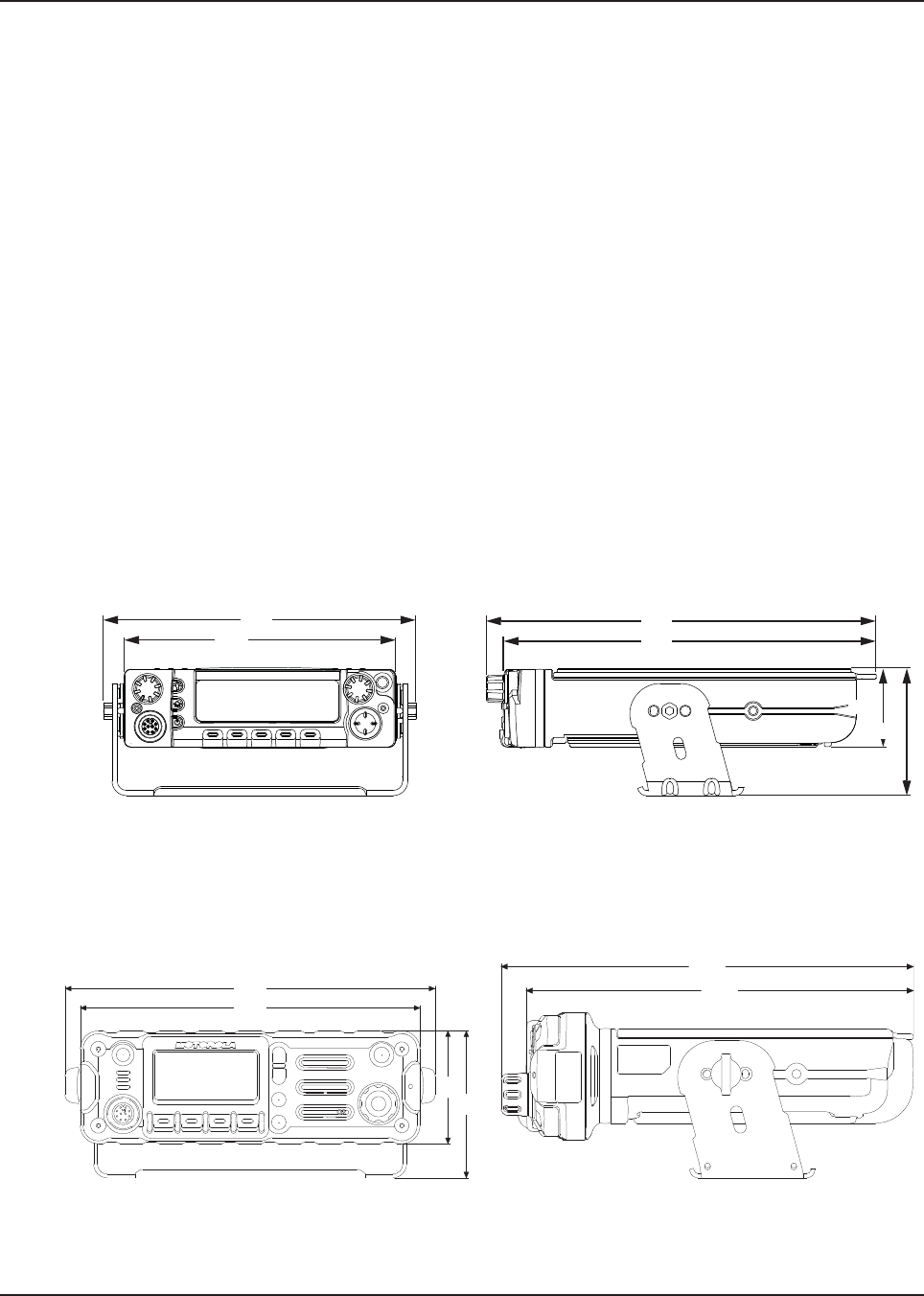
Chapter 1 Introduction
This manual covers the installation procedures for ASTRO APX mobile and motorcycle radios with
O2, O3, O5, O7 and O9 control heads, and accessories required to complete the radio system. The
radio system consists of a control head, radio, antenna, microphone, speaker, cabling, Universal
Relay Controller (URC), and accessories.
1.1 Mobile Radio Description
1.1.1 Dimensions
Figure 1-1, Figure 1-2, Figure 1-3 and Figure 1-4 show the basic dimensions of the dash mount
transceiver trunnion APX mobile radio. The transceiver portion of a remote mount APX mobile is
sized similarly.
When installing the radio, make sure to plan the installation carefully and leave additional room in the
rear of the radio for cabling and accessory connections; in the front of the radio for access, controls,
and cabling (if remote mount); and to the sides of the radio so that you may access and install the
trunnion screws/wing screws.
NOTE: The measurement unit used in Figure 1-1 to Figure 1-22 is millimeter.
NOTE: The rear accessory connector adds 0.75 in to the overall length. The remote mount length
is 244 mm.
Figure 1-1. Front View of APX 7500
Mid Power Dash Mount Transceiver and Trunnion Figure 1-2. Side View of APX 7500 Mid Power
Dash Mount Transceiver and Trunnion
Figure 1-3. Front View of APX 2500/4500
Mid Power Dash Mount Transceiver and Trunnion Figure 1-4. Side View of APX 2500/4500
Mid Power Dash Mount Transceiver and Trunnion
206
180
256
244
51
83
224
206
69
89
222
209
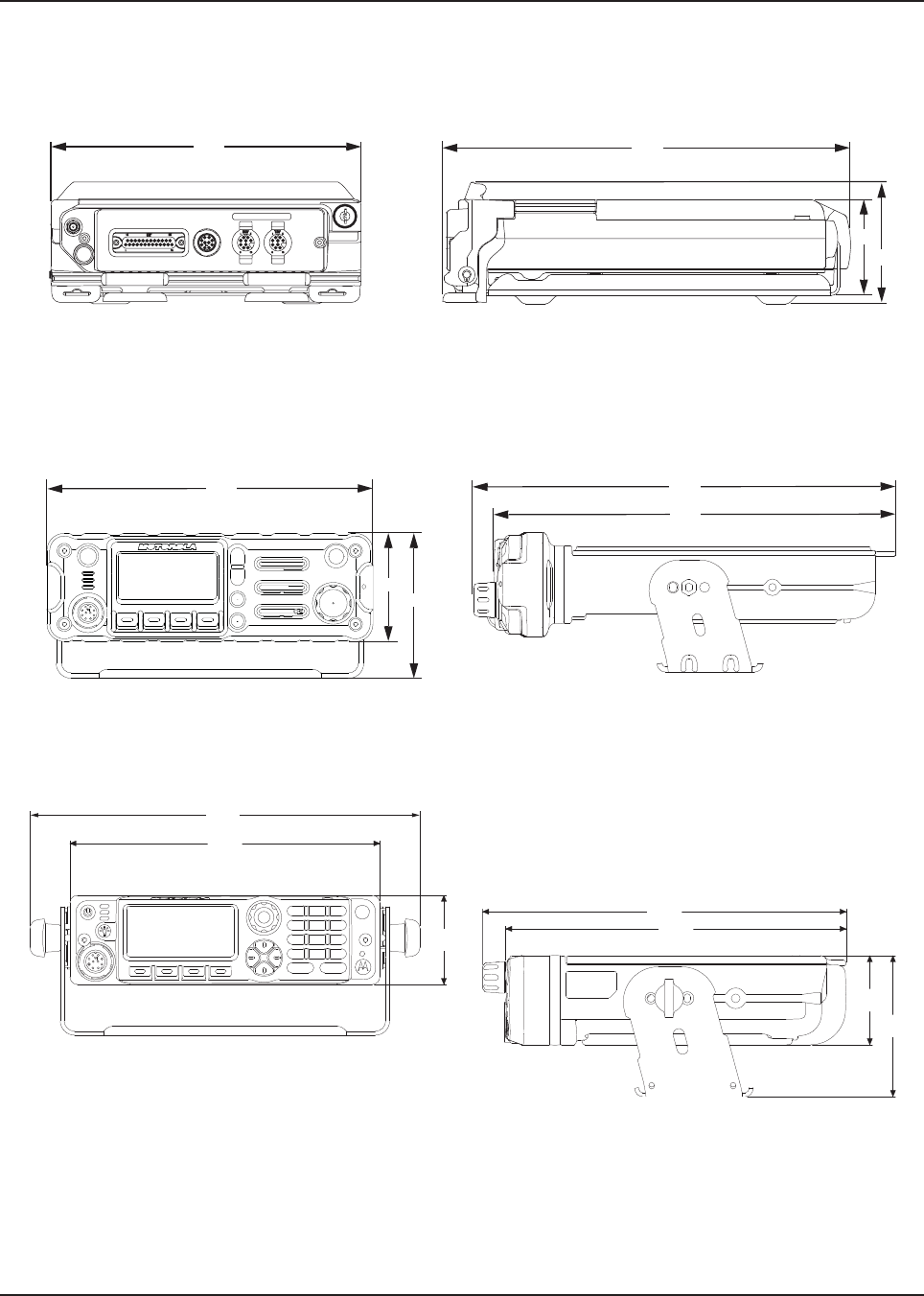
6878215A01
1-2 Introduction Mobile Radio Description
NOTE: The rear accessory connector adds 0.75 in to the overall length. The remote mount length
is 194mm.
Figure 1-5. Front View of APX 7500
High Power (100W) Transceiver and Trunnion Figure 1-6. Side View of APX 7500 High Power (100W)
Transceiver and Trunnion
Figure 1-7. Front View of O2 Control Head
Attached to APX 7500 Mid Power Dash Mount
Transceiver and Trunnion
Figure 1-8. Side View of O2 Control Head
Attached to APX7500 Mid Power Dash Mount
Transceiver and Trunnion
Figure 1-9. Front View of O7 Control Head
Attached to APX 2500 Mid Power Dash Mount
Transceiver and Trunnion
Figure 1-10. Side View of O7 Control Head
Attached to APX 2500 Mid Power Dash Mount
Transceiver and Trunnion
223
74
90
293
206
92
69
278
269
207
194
51
80
178
51
224
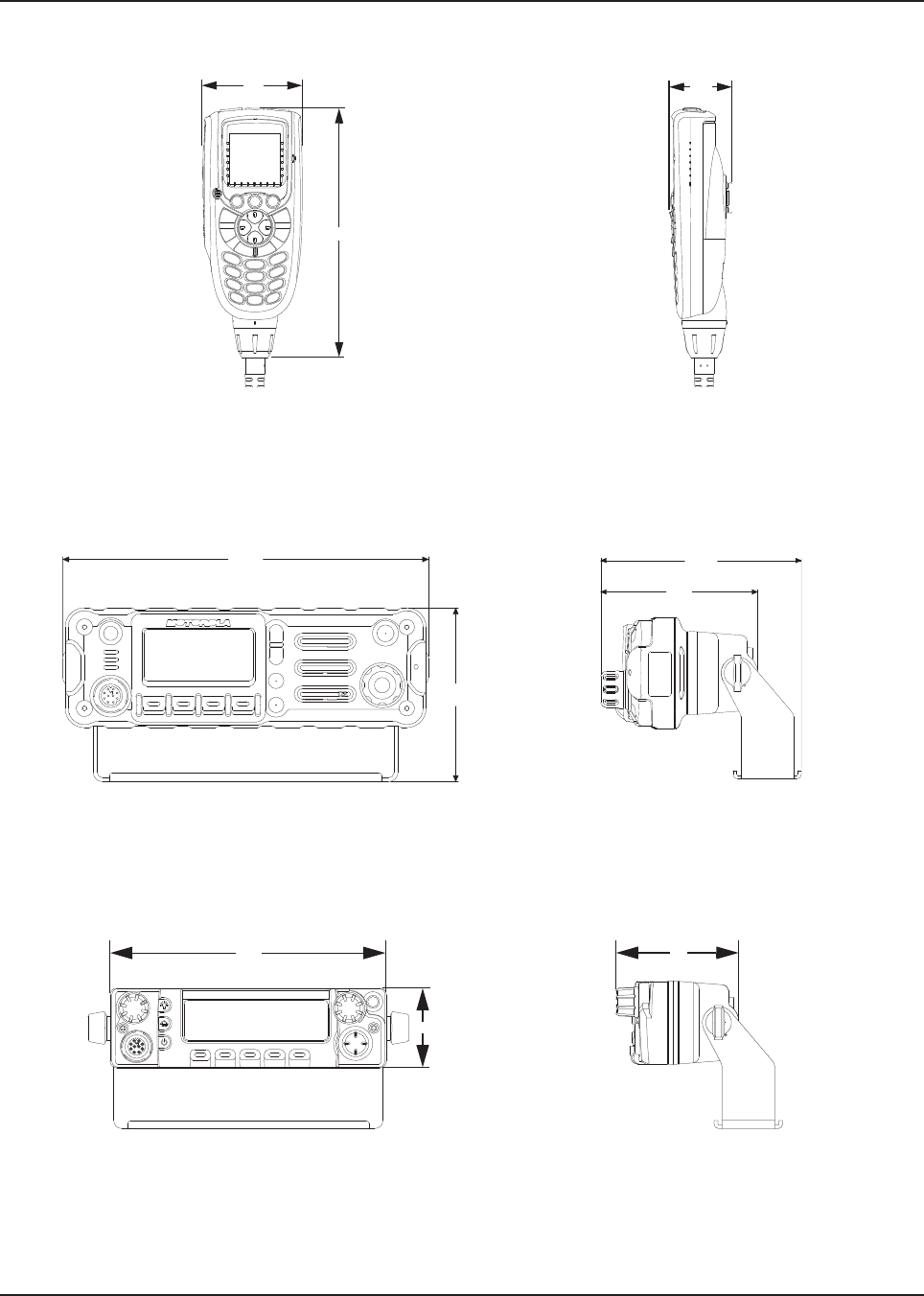
6878215A01
Introduction Mobile Radio Description 1-3
Figure 1-11. Front View of O3 Control
Head with Coiled Cable Figure 1-12. Side View of O3 Control
Head with Coiled Cable
Figure 1-13. Front View of O2 Control Head with
Remote Mount and Trunnion Figure 1-14. Side View of O2 Control Head with
Remote Mount and Trunnion
Figure 1-15. Front View of O5 Control Head with
Remote Mount and Trunnion Figure 1-16. Side View of O5 Control Head with
Remote Mount and Trunnion
61
153
38
209
99
123
97
51
180 75
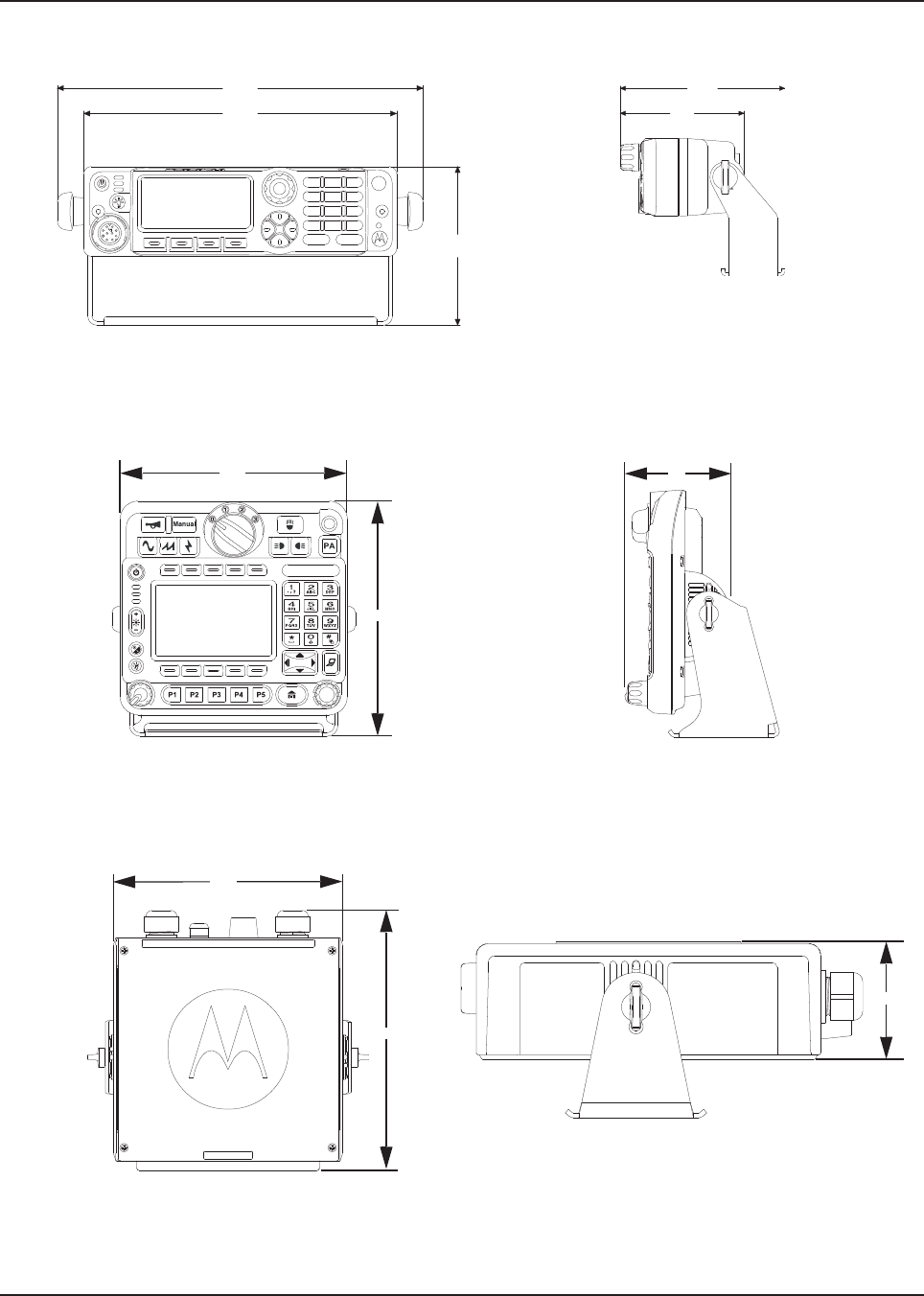
6878215A01
1-4 Introduction Mobile Radio Description
Figure 1-17. Front View of O7 Control Head with
Remote Mount and Trunnion Figure 1-18. Side View of O7 Control Head with
Remote Mount and Trunnion
Figure 1-19. Front View of O9 Control Head with
Trunnion Figure 1-20. Side View of O9 Control Head with
Trunnion
Figure 1-21. Top View of O9 Universal
Relay Controller with Trunnion
(URC is an orderable accessory.)
Figure 1-22. Side View of O9 Universal
Relay Controller with Trunnion
(URC is an orderable accessory.)
209
178
91
108
82
178
190 83
185
210
61.5
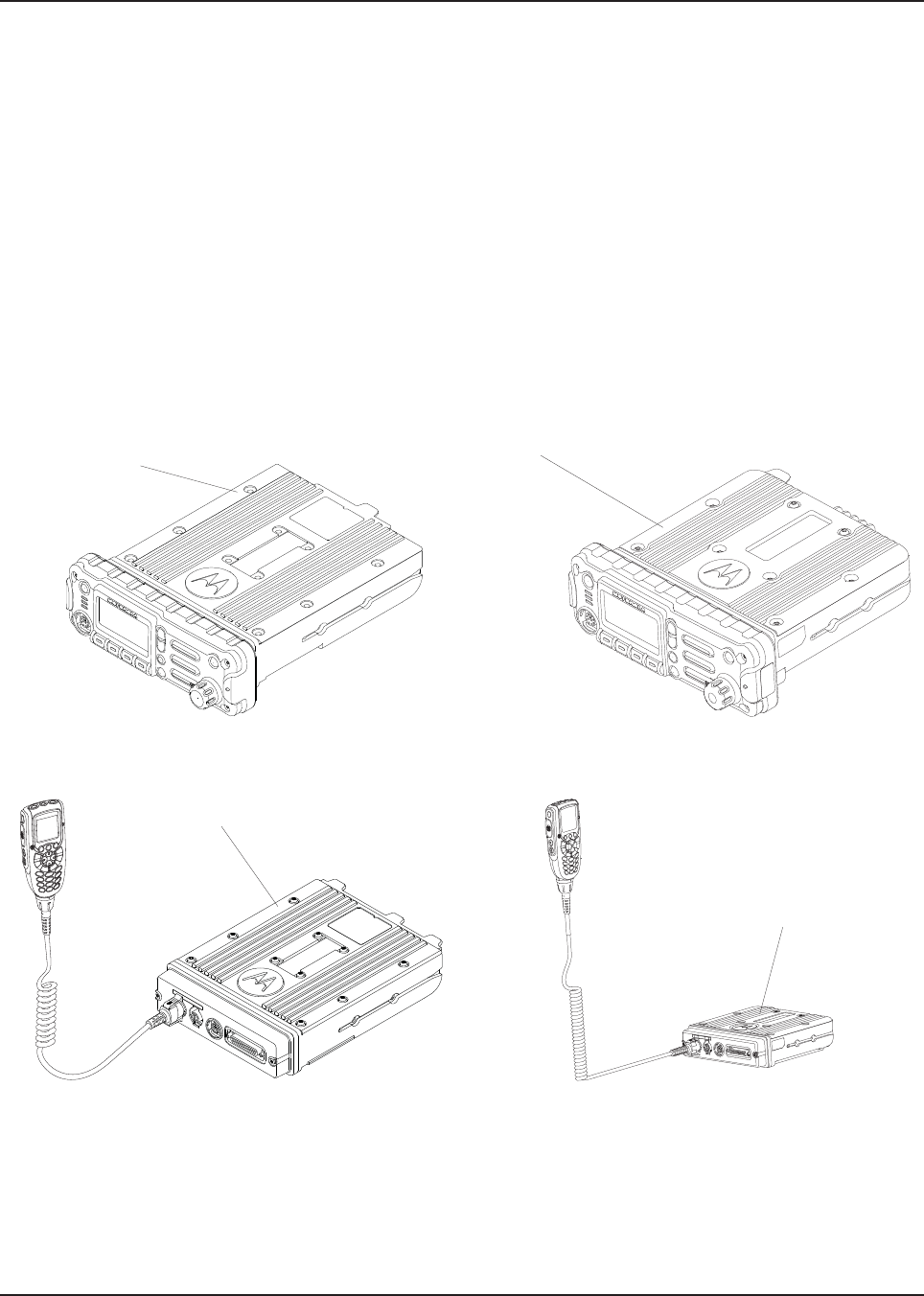
6878215A01
Introduction Standard Configurations 1-5
1.2 Standard Configurations
1.2.1 Dash Mount Configuration
NOTE: The dash mount configuration is not applicable for 100W radios and O9 control heads.
There are two versions of the APX mobile dash mount. The first are the O2, O5 and O7 control
heads which are mounted on the front of the transceiver housing. The second is the O3 control head
which is connected to the transceiver via a coiled cable, which is plugged into the CAN connector on
the transceiver.
Electrical connection between the two takes place within the radio via a flexible circuit board
between the connectors on the front of the transceiver and at the back of the control head for O2, O5
and O7 and between the connectors on the front of the transceiver and at the back of the TIB for the
O3.
Figure 1-23. Dash Mount Configuration for O2 Control Head
Figure 1-24. Dash Mount Configuration for O3 Control Head
ASTRO 25 Subscribers
APX 2500
ASTRO 25 Subscribers APX 5500/
APX 6500/APX 7500/
APX 6500 Li Mobile
ASTRO 25 Subscribers
APX 2500/APX 4500
ASTRO 25 Subscribers APX 5500/
APX 6500/APX 7500/
APX 6500 Li Mobile
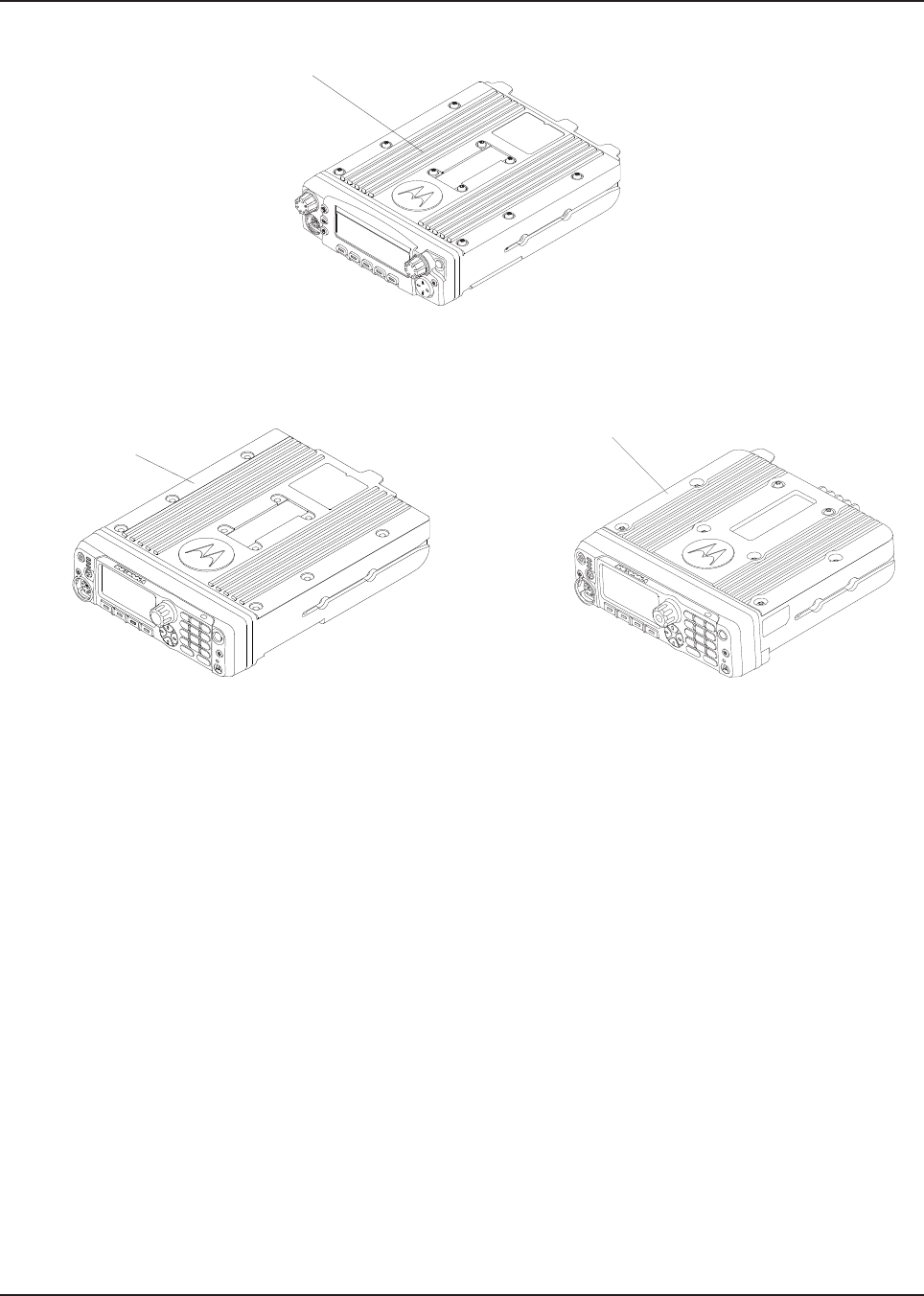
6878215A01
1-6 Introduction Standard Configurations
For details on this configuration, see Section 2.2.1 on page 2-21.
Figure 1-25. Dash Mount Configuration for O5 Control Head (Only Applicable for ASTRO 25 Subscribers
APX 5500/APX 6500/APX 7500/APX 6500 Li Mobile)
Figure 1-26. Dash Mount Configuration for O7 Control Head
ASTRO 25 Subscribers APX 5500/
APX 6500/APX 7500/
APX 6500 Li Mobile
ASTRO 25 Subscribers
APX 2500
ASTRO 25 Subscribers APX 5500/
APX 6500/APX 7500/
APX 6500 Li Mobile
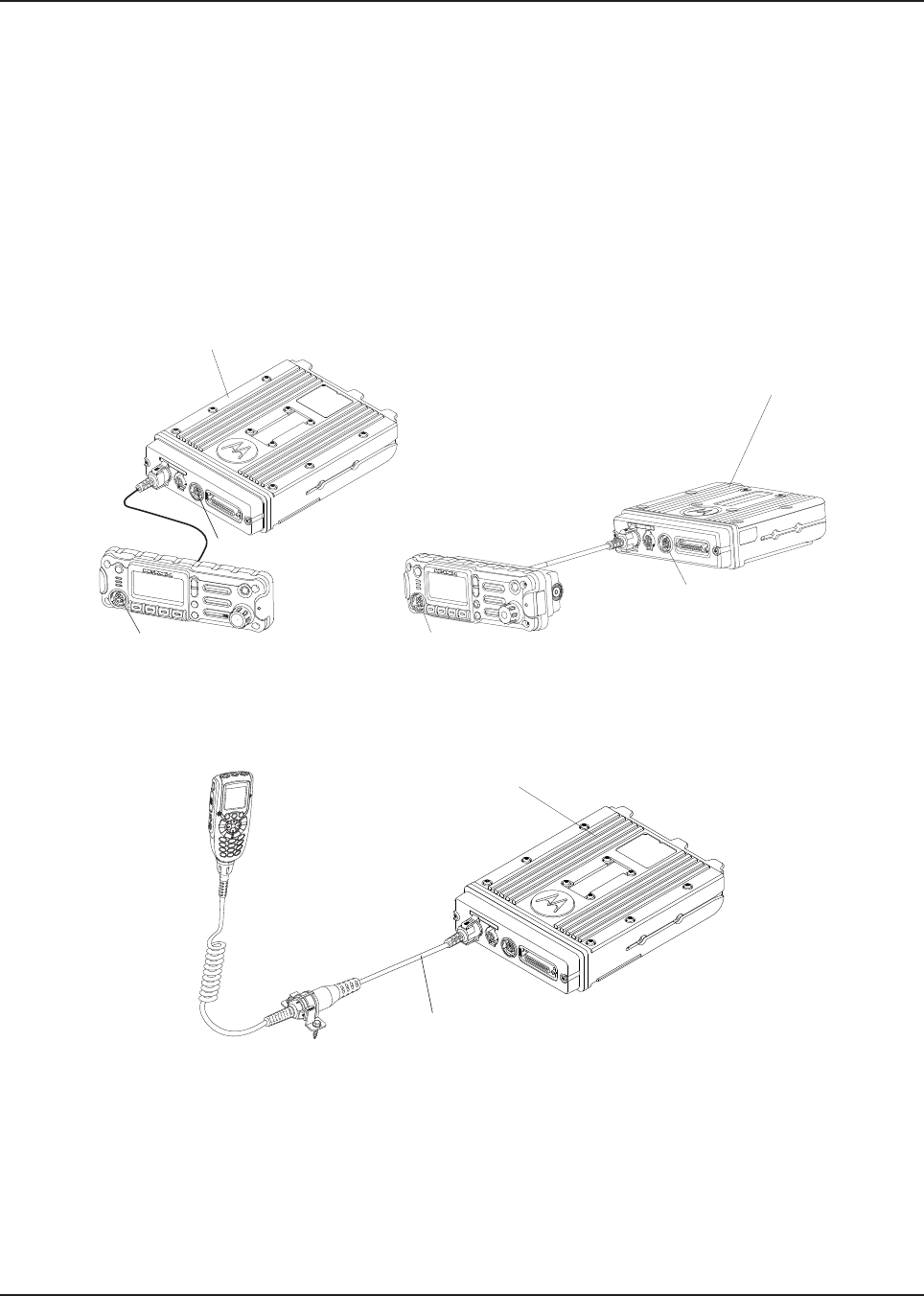
6878215A01
Introduction Standard Configurations 1-7
1.2.2 Remote Mount Configuration
In the remote control version, the transceiver and the control head are mounted separately in the
vehicle. The O2, O5 and O7 control heads are mounted in remote trunnions near the operator.The
O3 and O9 control heads are also mounted near the operator using extension cables. The
transceiver and control head are mounted using a trunnion or other mounting hardware. If the
transceiver is located in a car trunk, ensure that it is mounted securely and that sufficient cooling is
provided. Do not cover the transceiver with baggage, blankets, etc.
NOTE: The keypad mic should only be plugged into the Modified Modular Plug (MMP) connector
located on the control head, in either dash mount or remote mount configuration.
Figure 1-27. Remote Mount Configuration with Mid Power Transceiver, Transceiver Interface Board,
CHIB Rear Assembly and O2 Control Head
Figure 1-28. Remote Mount Configuration with Mid Power Transceiver,
Transceiver Interface Board and O3 Control Head
MMP
MMP
ASTRO 25 Subscribers APX 5500/
APX 6500/APX 7500/
APX 6500 Li Mobile
ASTRO 25 Subscribers
APX 2500/APX 4500
MMP
MMP
5 m (17 ft) Extension Cable
ASTRO 25 Subscribers APX 5500/
APX 6500/APX 7500/
APX 6500 Li Mobile
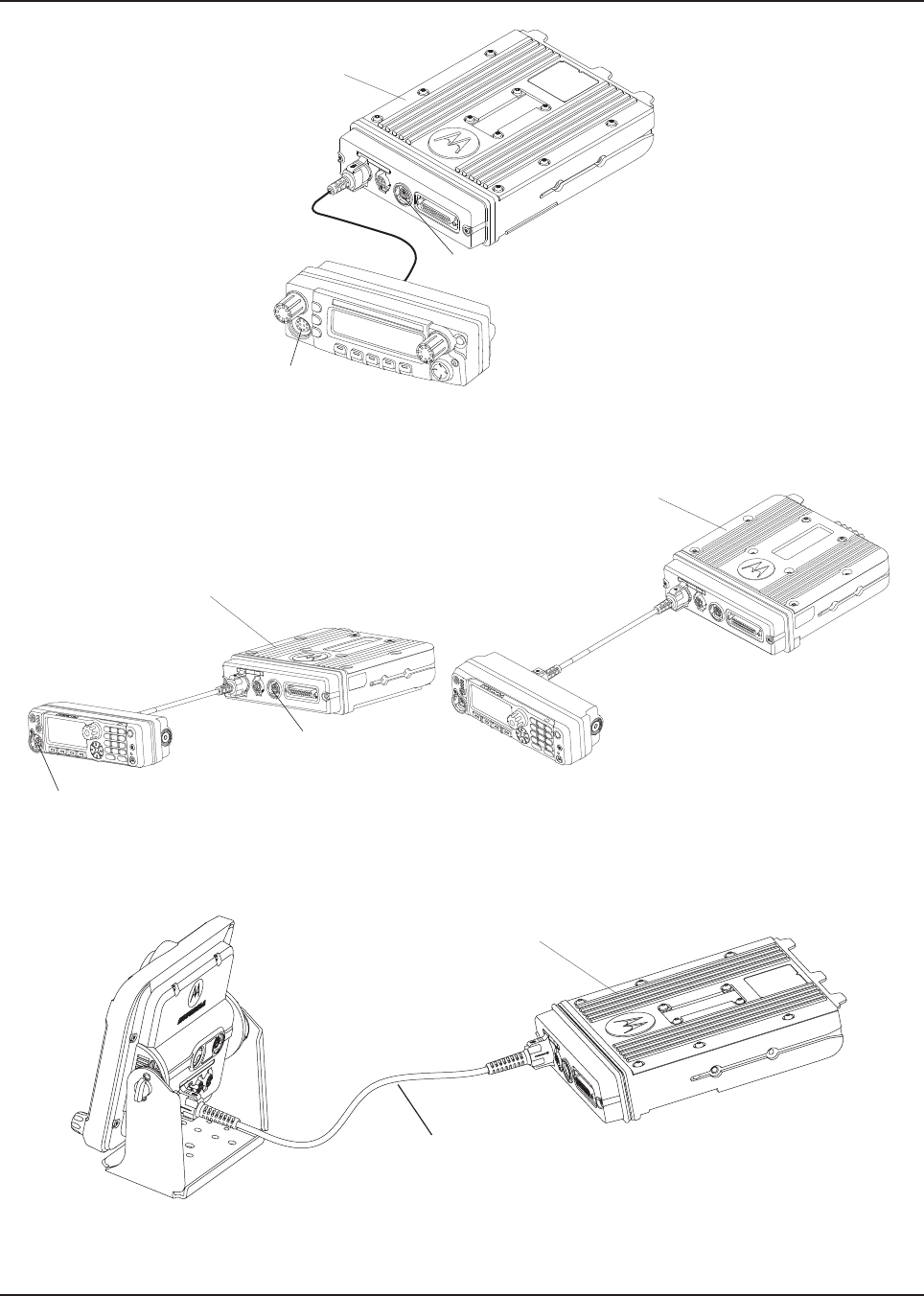
6878215A01
1-8 Introduction Standard Configurations
Figure 1-29. Remote Mount Configuration with Mid Power Transceiver, Transceiver Interface Board,
CHIB Rear Assembly and O5 Control Head
Figure 1-30. Remote Mount Configuration with Mid Power Transceiver,
Transceiver Interface Board, CHIB Rear Assembly and O7 Control Head
Figure 1-31. Remote Mount Configuration with Mid Power Transceiver,
Transceiver Interface Board and O9 Control Head
MMP
MMP
ASTRO 25 Subscribers APX 5500/
APX 6500/APX 7500/
APX 6500 Li Mobile
MMP
MMP
ASTRO 25 Subscribers APX 5500/
APX 6500/APX 7500/
APX 6500 Li Mobile
ASTRO 25 Subscribers
APX 2500
17 ft Extension Cable
ASTRO 25 Subscribers APX 7500
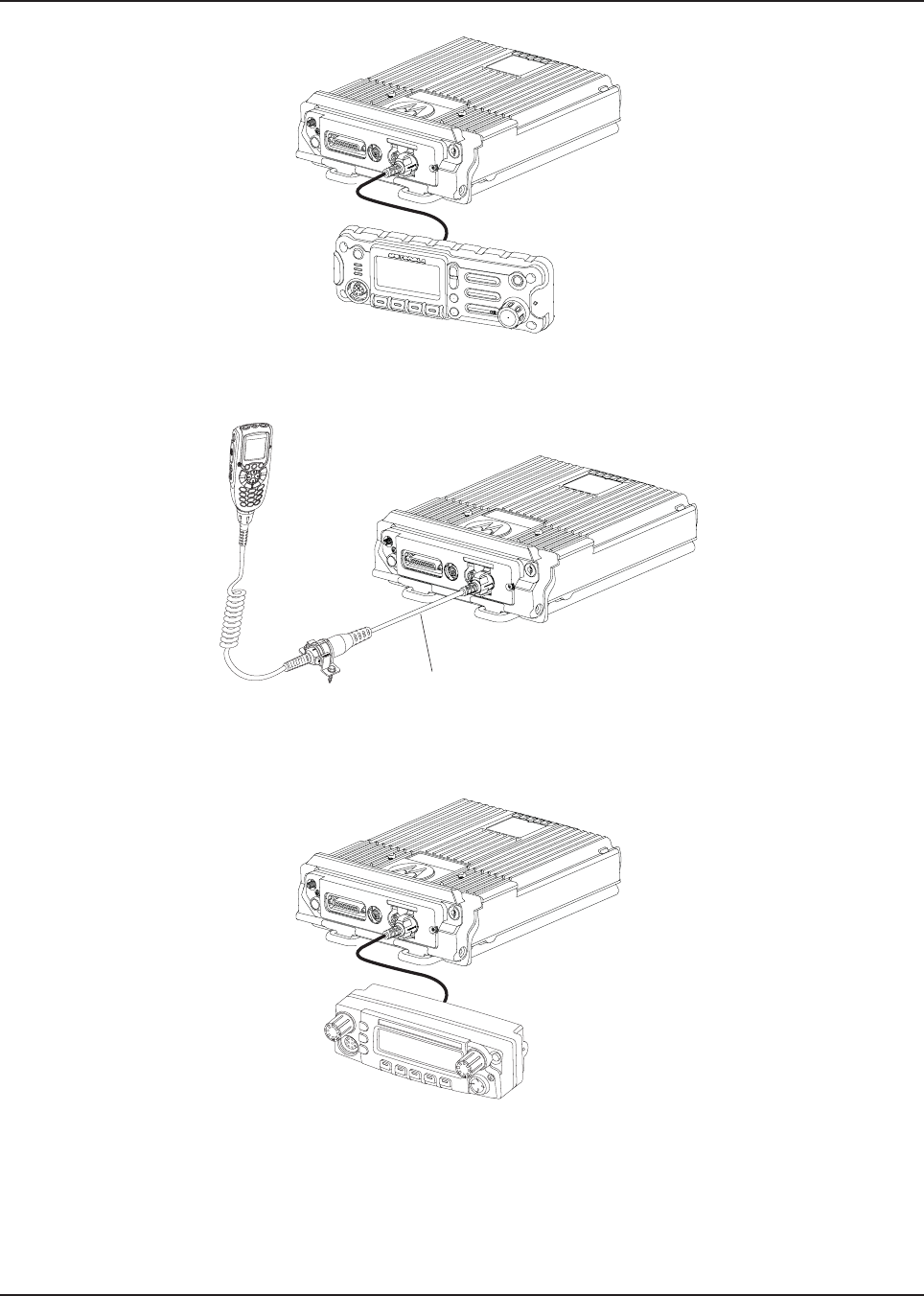
6878215A01
Introduction Standard Configurations 1-9
Figure 1-32. Remote Mount Configuration with High Power (100W)
Radio Transceiver and O2 Control Head
Figure 1-33. Remote Mount Configuration with High Power (100W)
Radio Transceiver and O3 Control Head
Figure 1-34. Remote Mount Configuration with High Power (100W)
Radio Transceiver and O5 Control Head
5 m (17 ft) Extension Cable
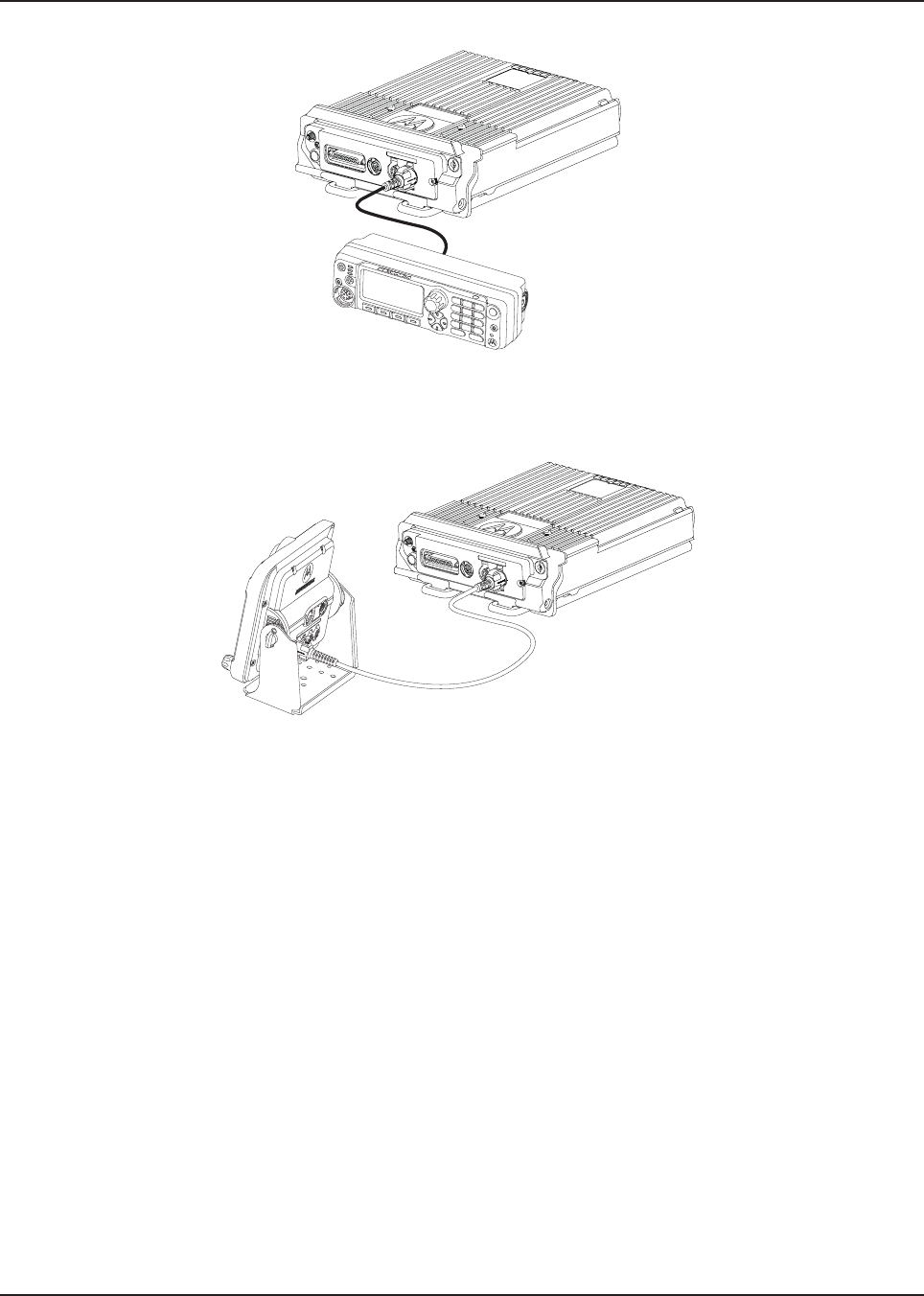
6878215A01
1-10 Introduction Standard Configurations
Figure 1-35. Remote Mount Configuration with High Power (100W)
Radio Transceiver and O7 Control Head
Figure 1-36. Remote Mount Configuration with High Power (100W)
Radio Transceiver and O9 Control Head
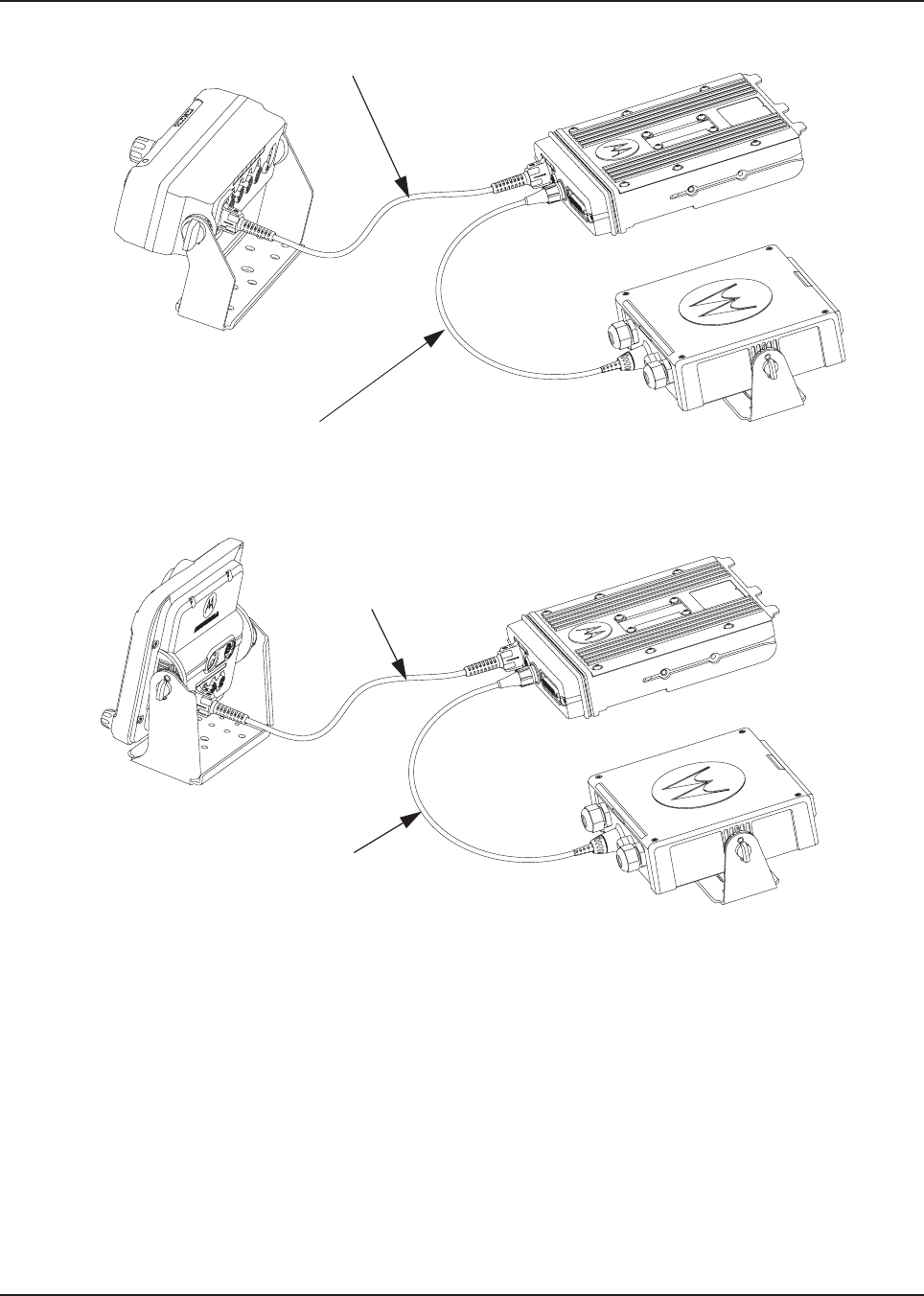
6878215A01
Introduction Standard Configurations 1-11
Figure 1-37. Remote Mount Configuration with Mid Power Radio Transceiver,
Universal Relay Controller and O7 Control Head (URC is optional.)
Figure 1-38. Remote Mount Configuration with Mid Power Radio Transceiver,
Universal Relay Controller and O9 Control Head (URC is optional.)
17 ft Extension Cable
O7 to URC Cable
O9 to URC Cable
17 ft Extension Cable
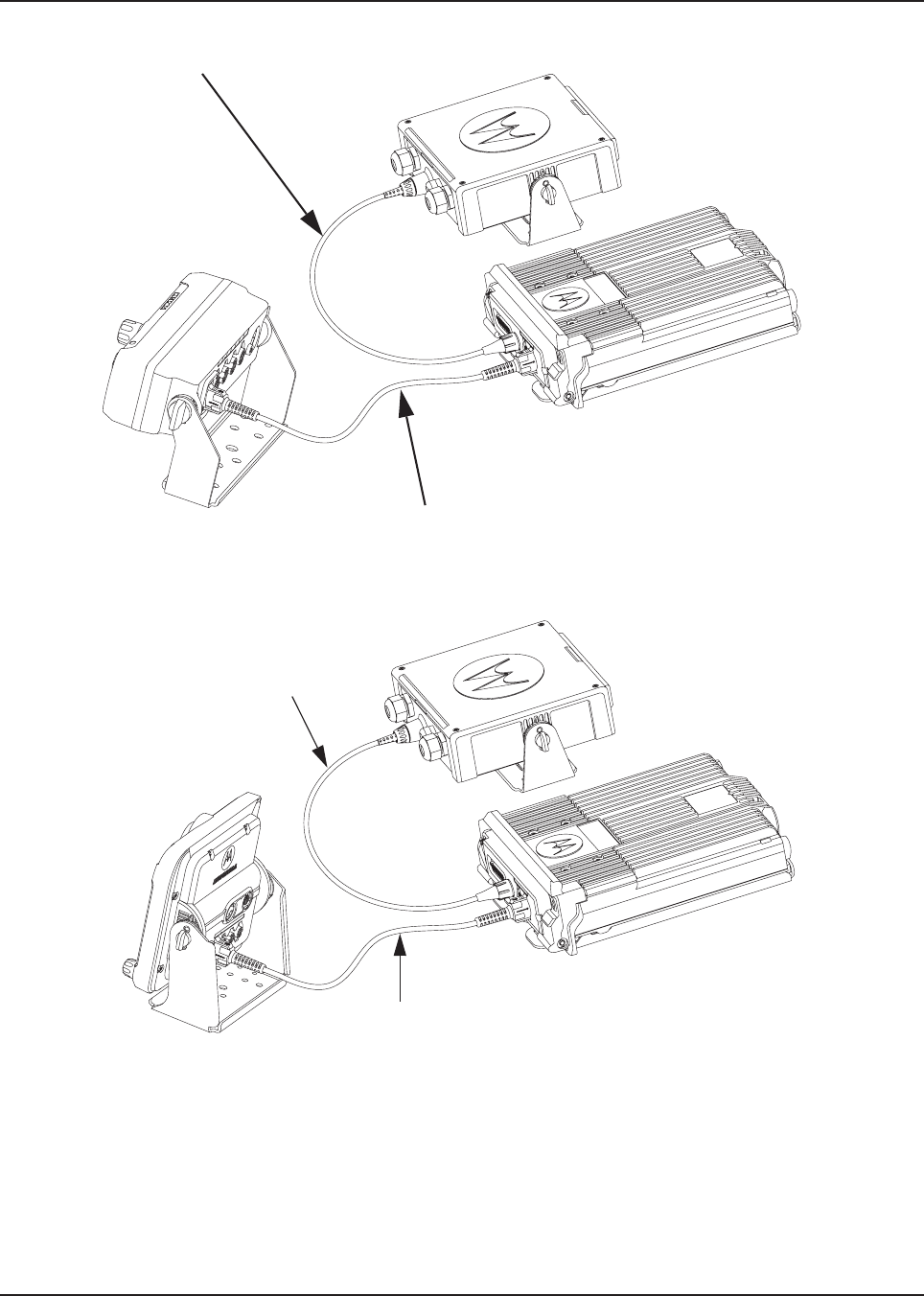
6878215A01
1-12 Introduction Standard Configurations
Figure 1-39. Remote Mount Configuration with High Power (100W) Radio Transceiver,
Universal Relay Controller and O7 Control Head (URC is optional.)
Figure 1-40. Remote Mount Configuration with High Power (100W) Radio Transceiver,
Universal Relay Controller and O9 Control Head (URC is optional.)
For details on these configurations, see Section 2.2.2 on page 2-23.
O7 to URC Cable
17 ft Extension Cable
O9 to URC Cable
17 ft Extension Cable

6878215A01
Introduction Standard Configurations 1-13
1.2.3 Multi Control Head
The multi control head option allows separate, remotely operated control heads to operate and
control the radio. For example, a fire truck could have a control head located in the cab and on the
rear of the truck so that the radio could be operated from outside the vehicle.
NOTE: The dual control head can be used together in the future.

6878215A01
1-14 Introduction Motorcycle Configurations
1.3 Motorcycle Configurations
NOTE: The motorcycle configurations are not applicable for 100W radios and O9 control heads.
The ASTRO APX mobile motorcycle radio models provide most of the equipment needed for
installing a standard ASTRO APX mobile radio on a motorcycle. Most of this radio system is
standard equipment. See Chapter 5: Motorcycle Radio Installation for further information.
1.4 Base/Control Stations
NOTE: The base/control station option is not applicable for 100W radios and O9 control heads.
If mobile radio equipment is installed at a fixed location and operated as a control station or as a
fixed unit, the antenna installation must comply with the following requirements in order to ensure
optimal performance and compliance with the RF energy exposure limits in the standards and
guidelines listed in the 6881095C99 manual:
• The antenna should be mounted outside the building on the roof or a tower if at all possible.
• As with all fixed site antenna installations, it is the responsibility of the licensee to manage the
site in accordance with applicable regulatory requirements and may require additional
compliance actions such as site survey measurements, signage, and site access restrictions in
order to ensure that exposure limits are not exceeded.
1.5 Tools Required for APX Mobile Installations
Tool Part Number
10 mm wrench –
5 mm Allen wrench –
Rubber-coated pliers –
Regular slot screwdriver of Phillips #2 –
Pin removal tool 6680163F01
RF antenna tool HLN6695_
Wing screw torque tool HLN6970_

Chapter 2 Standard Configurations
2.1 Planning the Installation
The APX mobile radio operates only in negative ground electrical systems with a valid operating
range of 10.8VDC to 16.3VDC. Before starting the radio installation, make sure that the ground
polarity of the vehicle is correct. Accidentally reversing the polarity will not damage the radio, but will
cause the cable fuses to blow.
Planning is the key to fast, easy radio installation. Before starting the installation, inspect the vehicle
and determine how and where you intend to mount the antenna, radio, and accessories. Plan wire
and cable runs to provide maximum protection from inching, crushing, and overheating.
Before installing any electrical equipment, check the vehicle manufacturer’s user
manual for warnings or recommendations.
The installation of this device should be completed by an authorized servicer or
installer. Failure to properly install the device may result in damage to the device, or
improper operation.
!
C a u t i o n
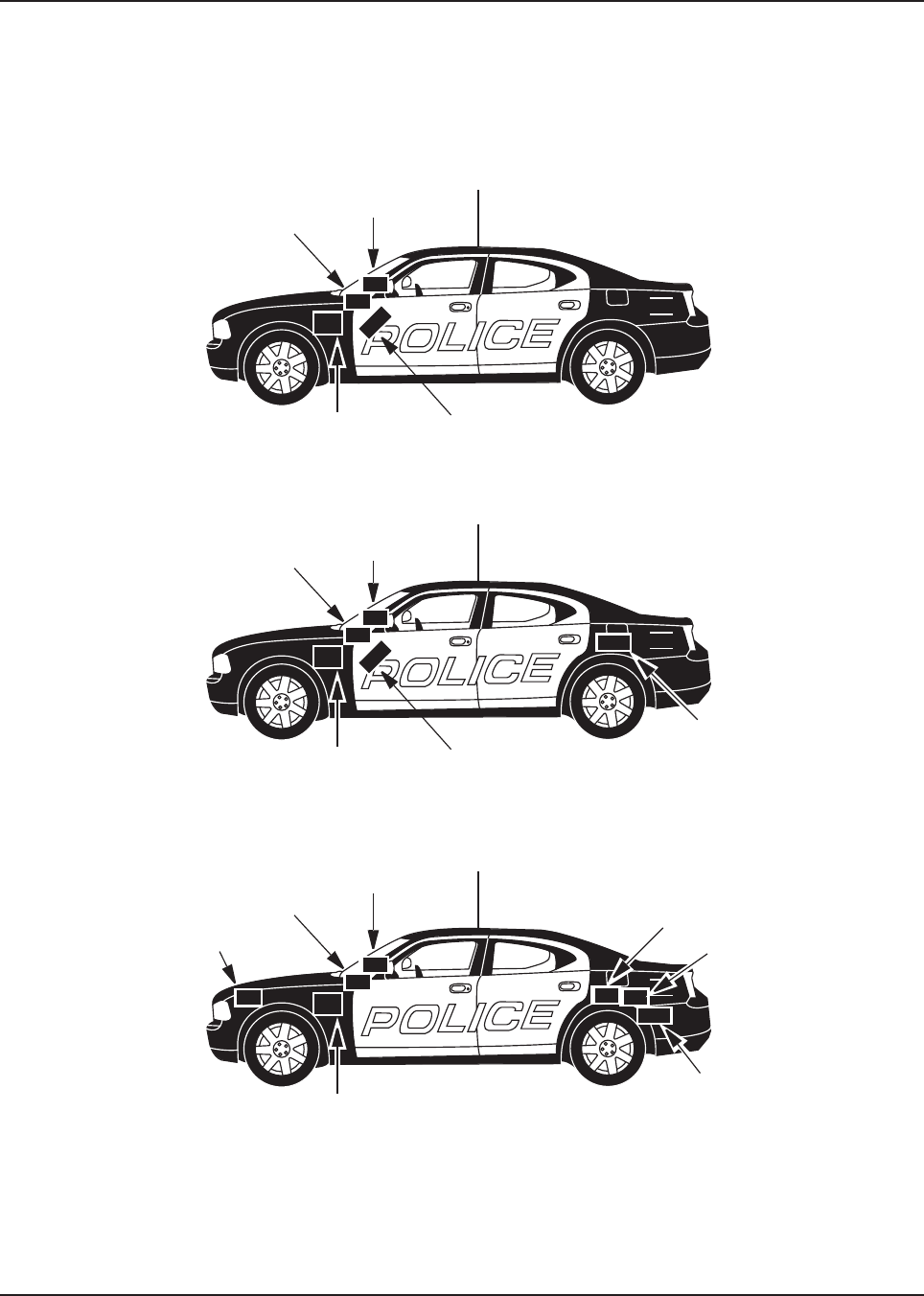
6878215A01
2-2 Standard Configurations Planning the Installation
2.1.1 Installation Examples
The mobile two-way radio offers various methods of installation, with accessories placed to the
vehicle as desired. The radio can be a dash or remote mount except for the 100W radio or with 09
control head, which can only be mounted remotely. The O9 control head with the radio and the URC
can only be mounted remotely (see Figure 2-3).
Figure 2-1. Dash Mount Radios Can Be Located in the Middle Console, on the
Transmission Hump, or Under the Dash (See Figure 2-2 for 100W Radio Install)
Figure 2-2. Remote Mount Radio Control Heads Can Be Located in the Middle
Console, on the Transmission Hump, or Under the Dash
Figure 2-3. Remote Mount of the Radio, O9 Control Head
and Universal Relay Controller (URC is optional.)
NOTE: 100W radio install is typically at the rear vehicle compartment.
911
Antenna
1/4-Wavelength
Radio
Speaker
Battery Radio
911
Antenna
1/4-Wavelength
Control
Head
Speaker
Battery Control
Head
Radio
911
Antenna
1/4-Wavelength
Control Head
Speaker
Battery
Universal Relay
Controller Box
Radio
Siren Speaker Siren Box
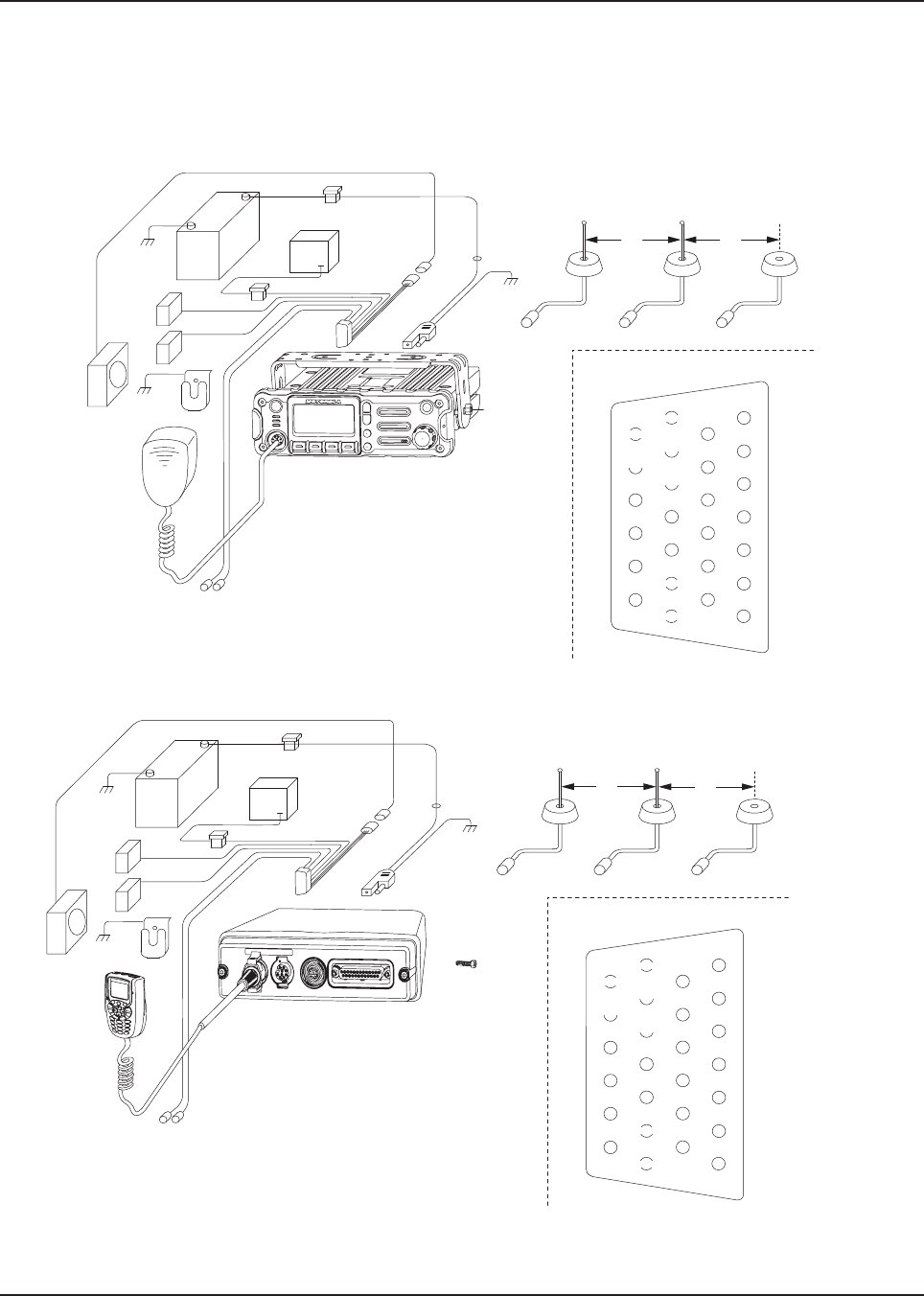
6878215A01
Standard Configurations Planning the Installation 2-3
2.1.2 Wiring Diagrams
Figure 2-6 through Figure 2-17 show the wiring diagrams for all the possible configurations. The title
under each figure identifies the O2, O3, O5, O7 or O9 control head configurations. Identify which of
these figures shows the configuration that you are installing, and use the diagram when planning the
installation.
Figure 2-4. Radio Installation (O2 Mid Power Dash Mount)
Figure 2-5. Radio Installation (O3 Mid Power Dash Mount)
BATTERY
HORN
RELAY
LIGHT
RELAY
MIC
CLIP
SPEAKER
MIC
EMERGENCY
SWITCH
FUSE
FUSE
BLOCK
(+)
(-)
RED LEAD
FUSE
FIREWALL
HOLE
MOUNTING
SCREW
DASH MOUNT RADIO
ANTENNA
CONNECTION
ANTENNA 1
3 ft
IGN SENSE (ACC)
P2
(SEE J2
PINOUT)
DC
POWER
CABLE
TRUNNION J2
REAR ACCESSORY CONNECTOR
1
7
8
14
13
20
21
26
SPKR-
SPKR+
VIPOUT 2
12V
(RELAY)
VIPOUT 1
12V
(RELAY)
GROUND
EMERGENCY
IGN SENSE
(ACC)
ANTENNA
CONNECTION
ANTENNA 2
(FOR DUAL
BAND RADIOS)
ANTENNA
CONNECTION
ANTENNA 3
GPS (OPTIONAL)
3 ft
BATTERY
HORN
RELAY
LIGHT
RELAY
MIC
CLIP
SPEAKER
MIC
EMERGENCY
SWITCH
FUSE
FUSE
BLOCK
(+)
(-)
RED LEAD
FUSE
FIREWALL
HOLE
MOUNTING
SCREW
RADIO
ANTENNA
CONNECTION
ANTENNA 1
IGN SENSE (ACC)
P2
(SEE J2
PINOUT)
DC
POWER
CABLE
TRUNNION
J2
REAR ACCESSORY CONNECTOR
1
7
8
14
13
20
21
26
SPKR-
SPKR+
VIPOUT 2
12V
(RELAY)
VIPOUT 1
12V
(RELAY)
GROUND
EMERGENCY
IGN SENSE
(ACC)
ANTENNA
CONNECTION
ANTENNA 2
(FOR DUAL
BAND RADIOS)
ANTENNA
CONNECTION
ANTENNA 3
GPS (OPTIONAL)
3 ft 3 ft
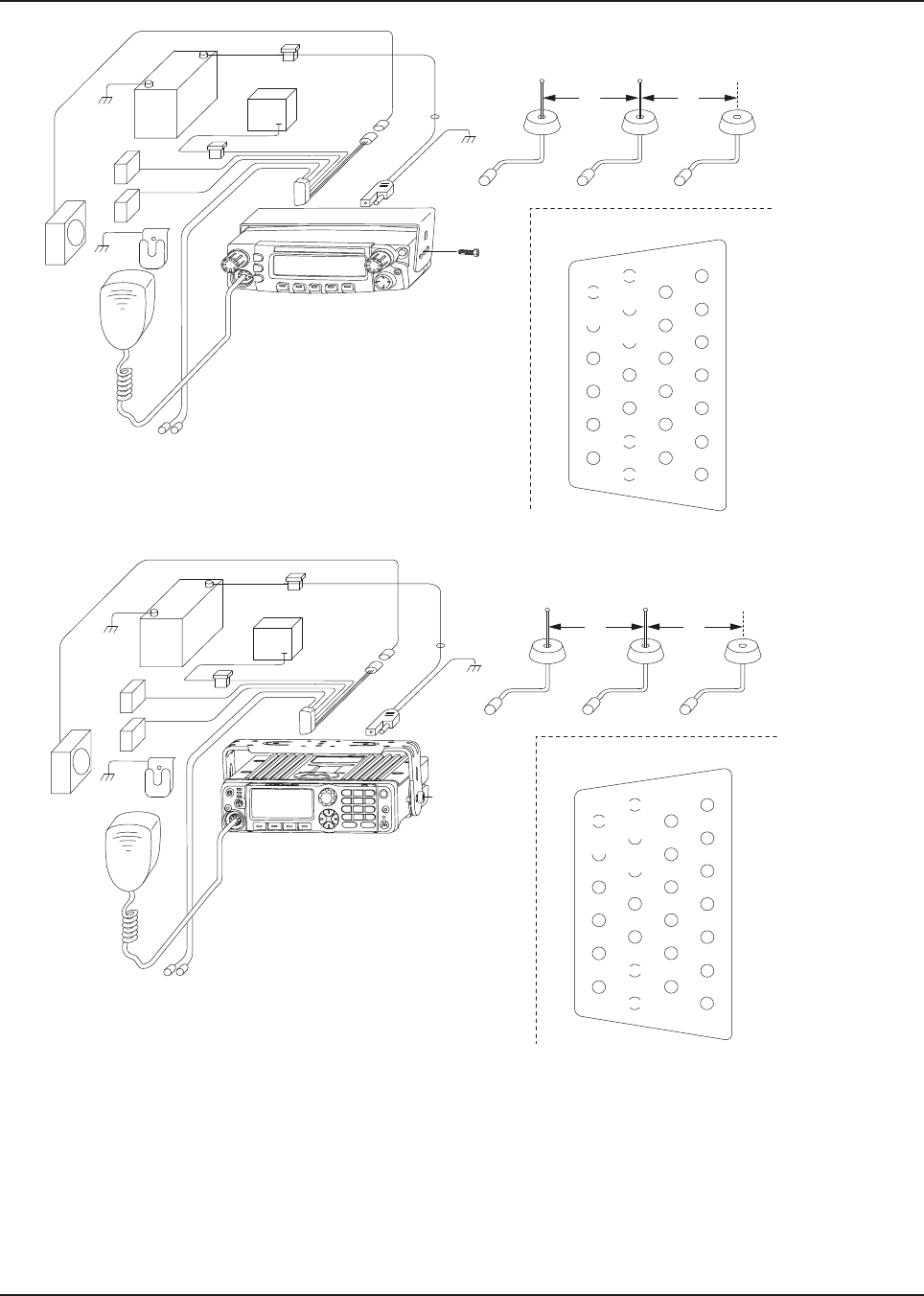
6878215A01
2-4 Standard Configurations Planning the Installation
Figure 2-6. Radio Installation (O5 Mid Power Dash Mount)
Figure 2-7. Radio Installation (O7 Mid Power Dash Mount)
BATTERY
HORN
RELAY
LIGHT
RELAY
MIC
CLIP
SPEAKER
MIC
EMERGENCY
SWITCH
FUSE
FUSE
BLOCK
(+)
(-)
RED LEAD
FUSE
FIREWALL
HOLE
MOUNTING
SCREW
DASH MOUNT RADIO
ANTENNA
CONNECTION
ANTENNA 1
3 ft
IGN SENSE (ACC)
P2
(SEE J2
PINOUT)
DC
POWER
CABLE
TRUNNION J2
REAR ACCESSORY CONNECTOR
1
7
8
14
13
20
21
26
SPKR-
SPKR+
VIPOUT 2
12V
(RELAY)
VIPOUT 1
12V
(RELAY)
GROUND
EMERGENCY
IGN SENSE
(ACC)
ANTENNA
CONNECTION
ANTENNA 2
(FOR DUAL
BAND RADIOS)
ANTENNA
CONNECTION
ANTENNA 3
GPS (OPTIONAL)
3 ft
BATTERY
HORN
RELAY
LIGHT
RELAY
MIC
CLIP
SPEAKER
MIC
EMERGENCY
SWITCH
FUSE
FUSE
BLOCK
(+)
(-)
RED LEAD
FUSE
FIREWALL
HOLE
MOUNTING
SCREW
DASH MOUNT RADIO
ANTENNA
CONNECTION
ANTENNA 1
3 ft
IGN SENSE (ACC)
P2
(SEE J2
PINOUT)
DC
POWER
CABLE
TRUNNION J2
REAR ACCESSORY CONNECTOR
1
7
8
14
13
20
21
26
SPKR-
SPKR+
VIPOUT 2
12V
(RELAY)
VIPOUT 1
12V
(RELAY)
GROUND
EMERGENCY
IGN SENSE
(ACC)
ANTENNA
CONNECTION
ANTENNA 2
(FOR DUAL
BAND RADIOS)
ANTENNA
CONNECTION
ANTENNA 3
GPS (OPTIONAL)
3 ft
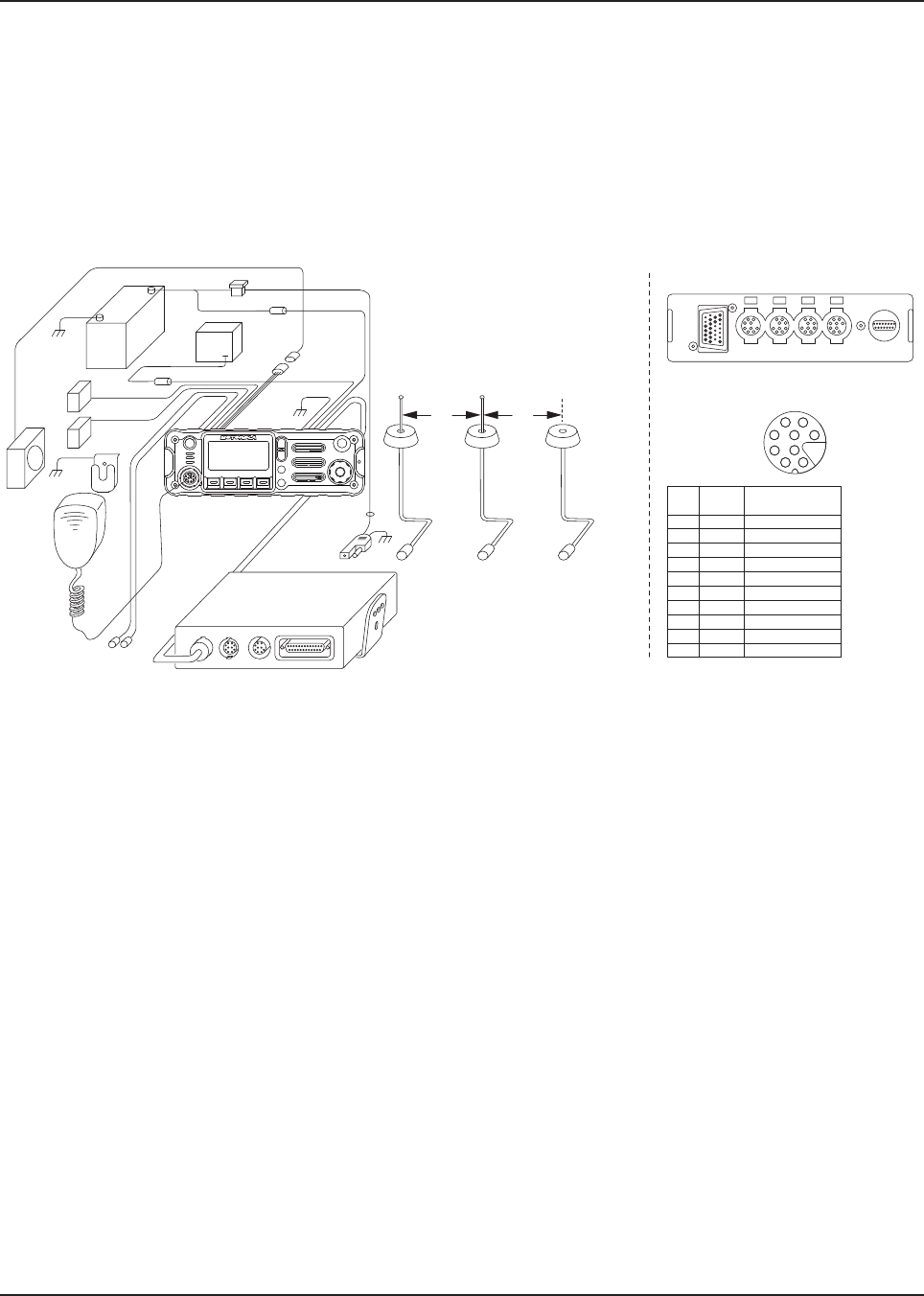
6878215A01
Standard Configurations Planning the Installation 2-5
NOTE: In dash mount configuration, it is mandatory that a rear accessory cable be attached at the
back of a mid power transceiver, in order to ground the Emergency pin to GND. Or, an
emergency footswitch or pushbutton switch must be attached at the back of a mid power.
If the emergency pin is not grounded, upon the attachment of the A+ cable at the DC
connector, the radio will detect a HIGH for the emergency pin state, and assume that
emergency has been activated. This will attempt to power on the radio, and will result in
excessive current draw and incorrect radio operation. Refer to Section 2.1.3.1 for further
details and recommended wiring of emergency in dash mount.
Figure 2-8. Radio Installation (O2 Mid Power Remote Mount)
BATTERY
HORN
RELAY
LIGHT
RELAY
MIC
CLIP
SPEAKER
MIC
EMERGENCY
SWITCH
RED LEAD
FUSE
BLOCK
YELLOW
LEAD
BLACK
LEAD
(+)
(-)
FUSE
FUSE
CONTROL HEAD FIREWALL
HOLE
ANTENNA
CONNECTION
ANTENNA 1
DC POWER
CABLE
RADIO
FUSE
ANTENNA
CONNECTION
ANTENNA 2
(FOR DUAL
BAND RADIOS)
ANTENNA
CONNECTION
ANTENNA 3
GPS (OPTIONAL)
PWR
SPK
J400-1 RED SWB +
J400-2 GREEN GND
J400-3 - NO PIN
J400-4 - "VIP" detect: GPIO=HIGH
J400-5 BLUE VIP_OUT_1
J400-6 YELLOW VIP_OUT_2
J400-7 BLACK VIP_OUT_3
J400-8 WHITE VIP_IN_1 (VIP_IN GPIO)
J400-9 ORANGE VIP_IN_2 (VIP_IN GPIO)
J400-10 VIOLET VIP_IN_3
CAN CAN DEK
VIP
J400
ACC USB
PORTS ON REAR OF REMOTE CONTROL HEAD
VIP CONNECTOR PIN-OUT
J400
6
9
10
7
4
2
5
8
1
Radio
Pin
Number
VIP Cable
(HKN6196_)
Wire Color
Function
3 ft 3 ft
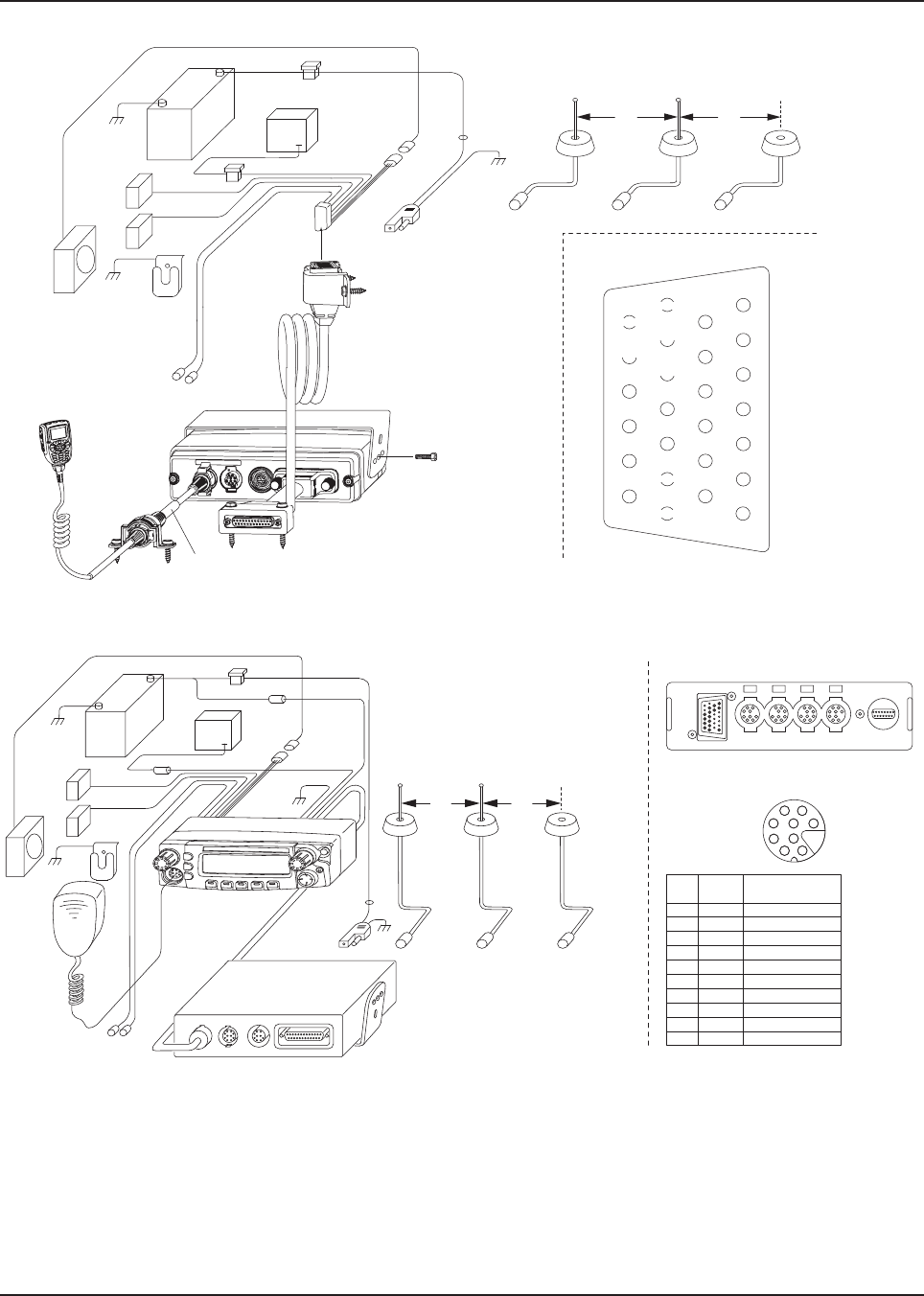
6878215A01
2-6 Standard Configurations Planning the Installation
Figure 2-9. Radio Installation (O3 Mid Power Remote Mount)
Figure 2-10. Radio Installation (O5 Mid Power Remote Mount)
BATTERY
HORN
RELAY
LIGHT
RELAY
CH
hang
up
box
SPEAKER
O3CH
5m (17ft)
CABLE (PMLN4958)
EMERGENCY
SWITCH
FUSE
FUSE
BLOCK
(+)
(-)
RED LEAD
FUSE
FIREWALL
HOLE
MOUNTING
SCREW
IGN SENSE (ACC)
P2
(SEE J626
PINOUT)
CABLE
HLN 6863
DC
POWER
CABLE
TRUNNION
connect to
P2
FRONT ACCESSORY
CABLE (PMLN4959)
ANTENNA
CONNECTION
ANTENNA 1
J2
REAR ACCESSORY CONNECTOR
1
7
8
14
13
20
21
26
SPKR-
SPKR+
VIPOUT 2
12V
(RELAY)
VIPOUT 1
12V
(RELAY)
GROUND
EMERGENCY
IGN SENSE
(ACC)
ANTENNA
CONNECTION
ANTENNA 2
(FOR DUAL
BAND RADIOS)
ANTENNA
CONNECTION
ANTENNA 3
GPS (OPTIONAL)
3 ft 3 ft
BATTERY
HORN
RELAY
LIGHT
RELAY
MIC
CLIP
SPEAKER
MIC
EMERGENCY
SWITCH
RED LEAD
FUSE
BLOCK
YELLOW
LEAD
BLACK
LEAD
(+)
(-)
FUSE
FUSE
CONTROL HEAD FIREWALL
HOLE
ANTENNA
CONNECTION
ANTENNA 1
DC POWER
CABLE
RADIO
FUSE
ANTENNA
CONNECTION
ANTENNA 2
(FOR DUAL
BAND RADIOS)
ANTENNA
CONNECTION
ANTENNA 3
GPS (OPTIONAL)
PWR
SPK
J400-1 RED SWB +
J400-2 GREEN GND
J400-3 - NO PIN
J400-4 - "VIP" detect: GPIO=HIGH
J400-5 BLUE VIP_OUT_1
J400-6 YELLOW VIP_OUT_2
J400-7 BLACK VIP_OUT_3
J400-8 WHITE VIP_IN_1 (VIP_IN GPIO)
J400-9 ORANGE VIP_IN_2 (VIP_IN GPIO)
J400-10 VIOLET VIP_IN_3
CAN CAN DEK
VIP
J400
ACC USB
PORTS ON REAR OF REMOTE CONTROL HEAD
VIP CONNECTOR PIN-OUT
J400
6
9
10
7
4
2
5
8
1
Radio
Pin
Number
VIP Cable
(HKN6196_)
Wire Color
Function
3 ft 3 ft
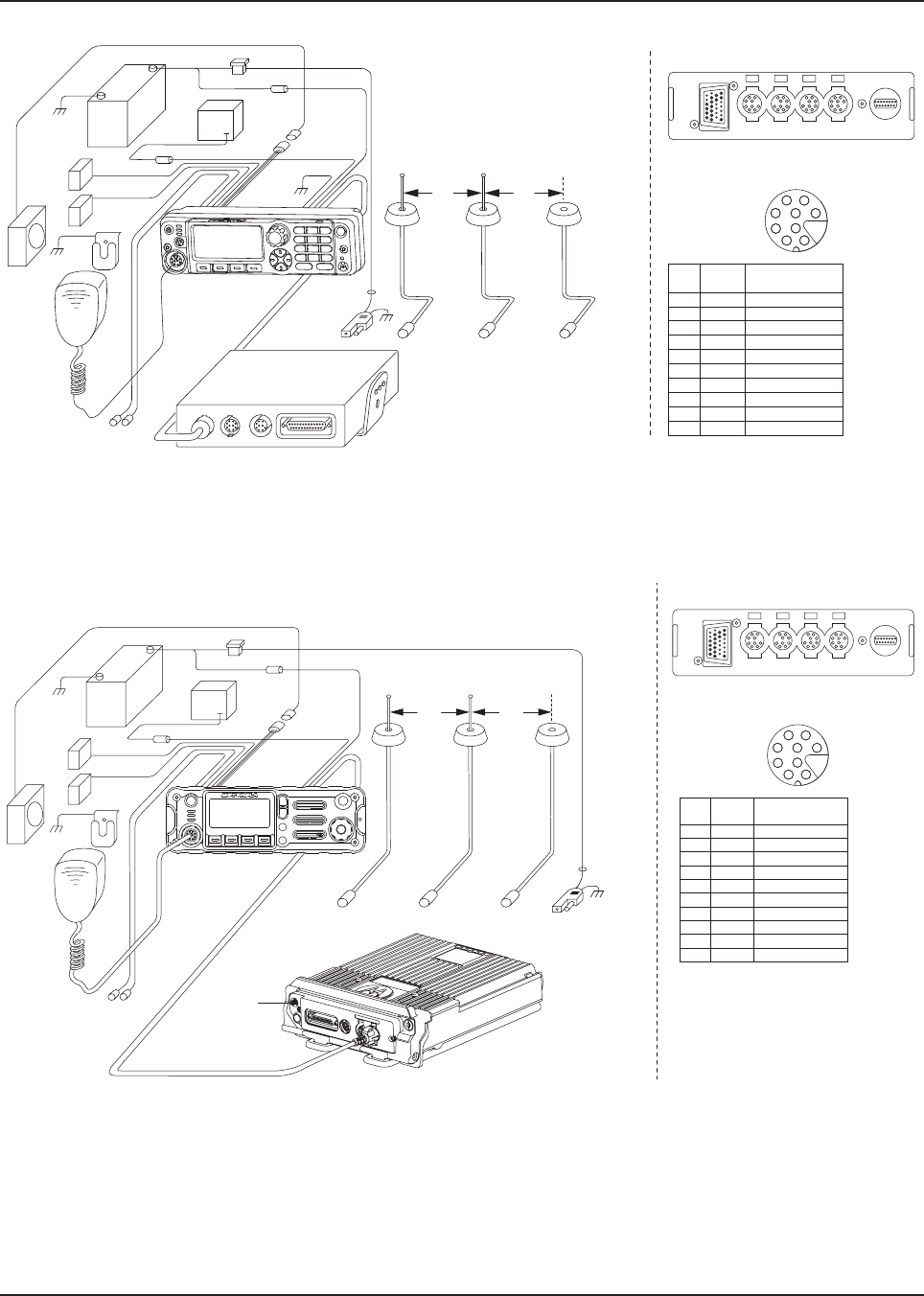
6878215A01
Standard Configurations Planning the Installation 2-7
Figure 2-11. Radio Installation (O7 Mid Power Remote Mount)
Refer to Section 2.1.3.2 and Section 4.2.1 for further details and recommended wiring of emergency
in remote mount.
Figure 2-12. Radio Installation (O2 High Power Remote Mount)
BATTERY
HORN
RELAY
LIGHT
RELAY
MIC
CLIP
SPEAKER
MIC
EMERGENCY
SWITCH
RED LEAD
FUSE
BLOCK
YELLOW
LEAD
BLACK
LEAD
(+)
(-)
FUSE
FUSE
CONTROL HEAD FIREWALL
HOLE
ANTENNA
CONNECTION
ANTENNA 1
DC POWER
CABLE
RADIO
FUSE
ANTENNA
CONNECTION
ANTENNA 2
(FOR DUAL
BAND RADIOS)
ANTENNA
CONNECTION
ANTENNA 3
GPS (OPTIONAL)
PWR
SPK
J400-1 RED SWB +
J400-2 GREEN GND
J400-3 - NO PIN
J400-4 - "VIP" detect: GPIO=HIGH
J400-5 BLUE VIP_OUT_1
J400-6 YELLOW VIP_OUT_2
J400-7 BLACK VIP_OUT_3
J400-8 WHITE VIP_IN_1 (VIP_IN GPIO)
J400-9 ORANGE VIP_IN_2 (VIP_IN GPIO)
J400-10 VIOLET VIP_IN_3
CAN CAN DEK
VIP
J400
ACC USB
PORTS ON REAR OF REMOTE CONTROL HEAD
VIP CONNECTOR PIN-OUT
J400
6
9
10
7
4
2
5
8
1
Radio
Pin
Number
VIP Cable
(HKN6196_)
Wire Color
Function
3 ft 3 ft
EMERGENCY
SWITCH
FIREWALL
HOLE
ANTENNA
CONNECTION
GPS
ANTENNA
CONNECTOR
DC POWER
CABLE
ANTENNA
CONNECTION
RADIO
CONTROL HEAD
BATTERY
HORN
RELAY
LIGHT
RELAY
MIC
CLIP
SPEAKER
MIC
RED LEAD
FUSE
BLOCK
YELLOW
LEAD
(+)
(-)
FUSE
FUSE
REMOTE
MOUNT
CONTROL
CABLE
ANTENNA 1
ANTENNA 2
(FOR DUAL
BAND RADIOS)
ANTENNA
CONNECTION
ANTENNA 3
GPS
(OPTIONAL)
FUSE
PWR
SPK
CAN CAN DEK
VIP
J400
ACC USB
PORTS ON REAR OF REMOTE CONTROL HEAD
VIP CONNECTOR PIN-OUT
J400
6
9
10
7
4
2
5
8
1
J400-1 RED SWB +
J400-2 GREEN GND
J400-3 - NO PIN
J400-4 - "VIP" detect: GPIO=HIGH
J400-5 BLUE VIP_OUT_1
J400-6 YELLOW VIP_OUT_2
J400-7 BLACK VIP_OUT_3
J400-8 WHITE VIP_IN_1 (VIP_IN GPIO)
J400-9 ORANGE VIP_IN_2 (VIP_IN GPIO)
J400-10 VIOLET VIP_IN_3
Radio
Pin
Number
VIP Cable
(HKN6196_)
Wire Color
Function
3 ft 3 ft
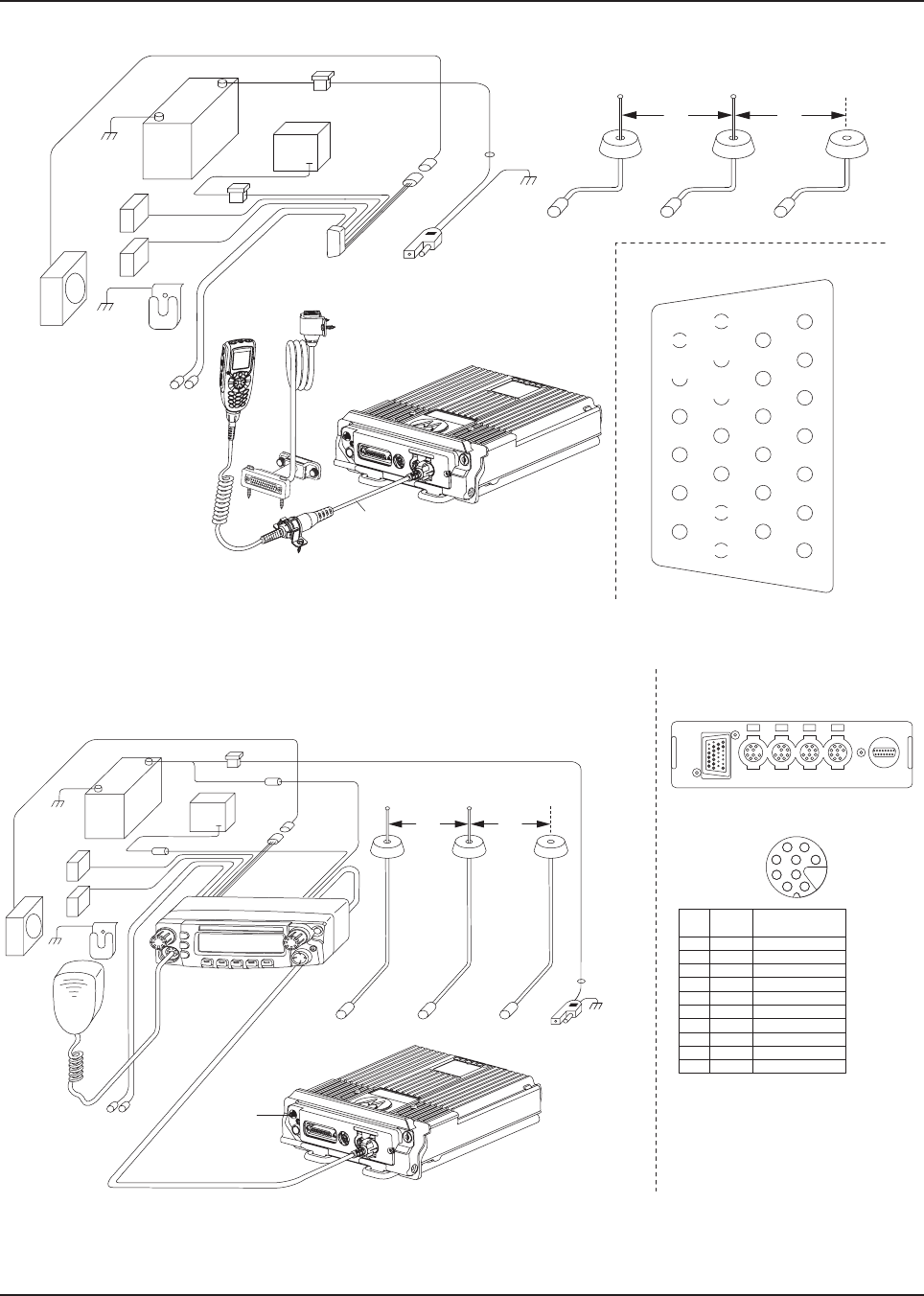
6878215A01
2-8 Standard Configurations Planning the Installation
Figure 2-13. Radio Installation (O3 High Power Remote Mount)
Figure 2-14. Radio Installation (O5 High Power Remote Mount)
BATTERY
HORN
RELAY
LIGHT
RELAY
CH
hang
up
box
SPEAKER
EMERGENCY
SWITCH
FUSE
FUSE
BLOCK
(+)
(-)
RED LEAD
FUSE
FIREWALL
HOLE
IGN SENSE (ACC)
P2
(SEE J626
PINOUT)
CABLE
HLN6863
J626
Front Accessory Cable
(PMLN4959)
DC
POWER
CABLE
O3CH
5m (17ft)
CABLE (PMLN4958)
ANTENNA
CONNECTION
ANTENNA 1
J2
REAR ACCESSORY CONNECTOR
1
7
8
14
13
20
21
26
SPKR-
SPKR+
VIPOUT 2
12V
(RELAY)
VIPOUT 1
12V
(RELAY)
GROUND
EMERGENCY
IGN SENSE
(ACC)
ANTENNA
CONNECTION
ANTENNA 2
(FOR DUAL
BAND RADIOS)
ANTENNA
CONNECTION
ANTENNA 3
GPS (OPTIONAL)
3 ft 3 ft
EMERGENCY
SWITCH
FIREWALL
HOLE
ANTENNA
CONNECTION
GPS
ANTENNA
CONNECTOR
DC POWER
CABLE
ANTENNA
CONNECTION
RADIO
CONTROL HEAD
BATTERY
HORN
RELAY
LIGHT
RELAY
MIC
CLIP
SPEAKER
MIC
RED LEAD
FUSE
BLOCK
YELLOW
LEAD
(+)
(-)
FUSE
FUSE
REMOTE
MOUNT
CONTROL
CABLE
ANTENNA 1
ANTENNA 2
(FOR DUAL
BAND RADIOS)
ANTENNA
CONNECTION
ANTENNA 3
GPS
(OPTIONAL)
FUSE
PWR
SPK
CAN CAN DEK
VIP
J400
ACC USB
PORTS ON REAR OF REMOTE CONTROL HEAD
VIP CONNECTOR PIN-OUT
J400
6
9
10
7
4
2
5
8
1
J400-1 RED SWB +
J400-2 GREEN GND
J400-3 - NO PIN
J400-4 - "VIP" detect: GPIO=HIGH
J400-5 BLUE VIP_OUT_1
J400-6 YELLOW VIP_OUT_2
J400-7 BLACK VIP_OUT_3
J400-8 WHITE VIP_IN_1 (VIP_IN GPIO)
J400-9 ORANGE VIP_IN_2 (VIP_IN GPIO)
J400-10 VIOLET VIP_IN_3
Radio
Pin
Number
VIP Cable
(HKN6196_)
Wire Color
Function
3 ft 3 ft
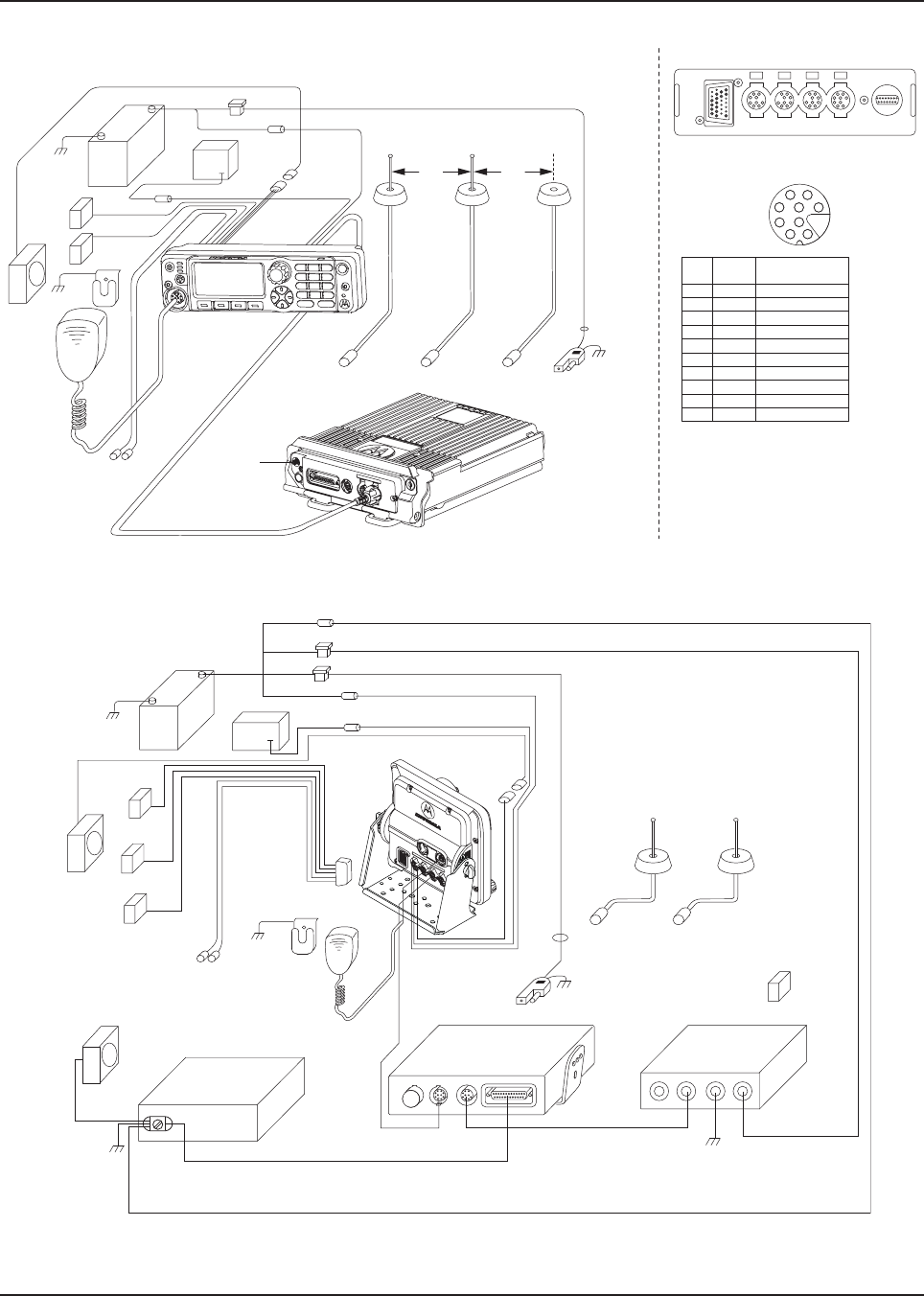
6878215A01
Standard Configurations Planning the Installation 2-9
Figure 2-15. Radio Installation (O7 High Power Remote Mount)
Figure 2-16. Radio Installation of O9 Remote Mount with Transceiver (URC is optional.)
EMERGENCY
SWITCH
FIREWALL
HOLE
ANTENNA
CONNECTION
GPS
ANTENNA
CONNECTOR
DC POWER
CABLE
ANTENNA
CONNECTION
RADIO
CONTROL HEAD
BATTERY
HORN
RELAY
LIGHT
RELAY
MIC
CLIP
SPEAKER
MIC
RED LEAD
FUSE
BLOCK
YELLOW
LEAD
(+)
(-)
FUSE
FUSE
REMOTE
MOUNT
CONTROL
CABLE
ANTENNA 1
ANTENNA 2
(FOR DUAL
BAND RADIOS)
ANTENNA
CONNECTION
ANTENNA 3
GPS
(OPTIONAL)
FUSE
PWR
SPK
CAN CAN DEK
VIP
J400
ACC USB
PORTS ON REAR OF REMOTE CONTROL HEAD
VIP CONNECTOR PIN-OUT
J400
6
9
10
7
4
2
5
8
1
J400-1 RED SWB +
J400-2 GREEN GND
J400-3 - NO PIN
J400-4 - "VIP" detect: GPIO=HIGH
J400-5 BLUE VIP_OUT_1
J400-6 YELLOW VIP_OUT_2
J400-7 BLACK VIP_OUT_3
J400-8 WHITE VIP_IN_1 (VIP_IN GPIO)
J400-9 ORANGE VIP_IN_2 (VIP_IN GPIO)
J400-10 VIOLET VIP_IN_3
Radio
Pin
Number
VIP Cable
(HKN6196_)
Wire Color
Function
3 ft 3 ft
MIC
MIC
CLIP
EMERGENCY
SWITCH
(SEE J2
PINOUT)
GUN LOCK
EARJACK
Control Head
Speaker
Siren Speaker
Siren Box
RED LEAD
HORN
RELAY
ANTENNA 1
ANTENNA
CONNECTION
FIREWALL
HOLE
DC POWER
CABLE
URC Controller Box
BLACK
LEAD
LIGHTBAR
O9 TO URC Cable
RADIO
CAN Cable
ANTENNA
CONNECTION
ANTENNA 2
(+)
(-)
RED LEAD
RED LEAD
RED LEAD
YELLOW LEAD
CONTROL HEAD
FUSE
FUSE
FUSE
FUSE
BLOCK
BATTERY
FUSE
CIRCUIT BREAKER
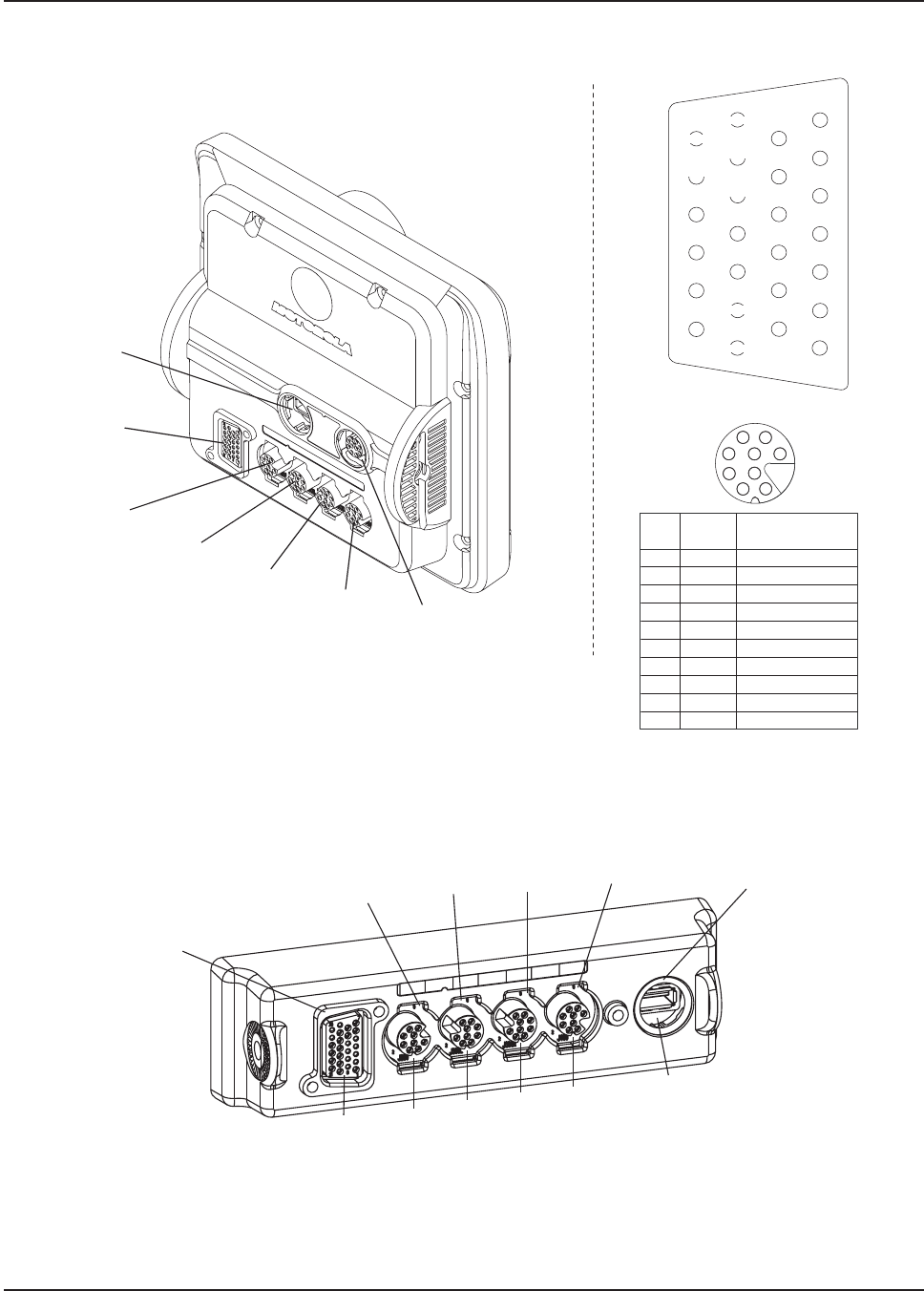
6878215A01
2-10 Standard Configurations Planning the Installation
Figure 2-17. Radio Installation (O9 Remote Mount with Pinouts)
Refer to Section 2.1.3.2 and Section 4.2.1 for further details and recommended wiring of emergency
in remote mount.
Figure 2-18. Remote Control Head Pinouts
VIP CONNECTOR PIN-OUT
J400
6
9
10
7
4
2
5
8
1
J400-1 RED SWB +
J400-2 GREEN GND
J400-3 - NO PIN
J400-4 - "VIP" detect: GPIO=HIGH
J400-5 BLUE VIP_OUT_1
J400-6 YELLOW VIP_OUT_2
J400-7 BLACK VIP_OUT_3
J400-8 WHITE VIP_IN_1 (VIP_IN GPIO)
J400-9 ORANGE VIP_IN_2 (VIP_IN GPIO)
J400-10 VIOLET VIP_IN_3
Radio
Pin
Number
VIP Cable
(HKN6196_)
Wire Color
Function
J2
REAR ACCESSORY CONNECTOR
1
7
8
14
13
20
21
26
SPKR-
SPKR+
VIPOUT 2
12V
(RELAY)
VIPOUT 1
12V
(RELAY)
GROUND
EMERGENCY
IGN SENSE
(ACC)
GCAI
J400
DEK/VIP
(YELLOW)
J300R
CAN
(BLUE)
J500
USB
J100
M.A.P.
J200
PWR/SPKR
(RED) J300L
CAN
(BLUE)
M.A.P. PWR
SPK
(RED)
CAN
(BLUE)
CAN
(BLUE)
DEK
VIP
(YELLOW)
USB
J100
J200 J300L J300R J400 J500
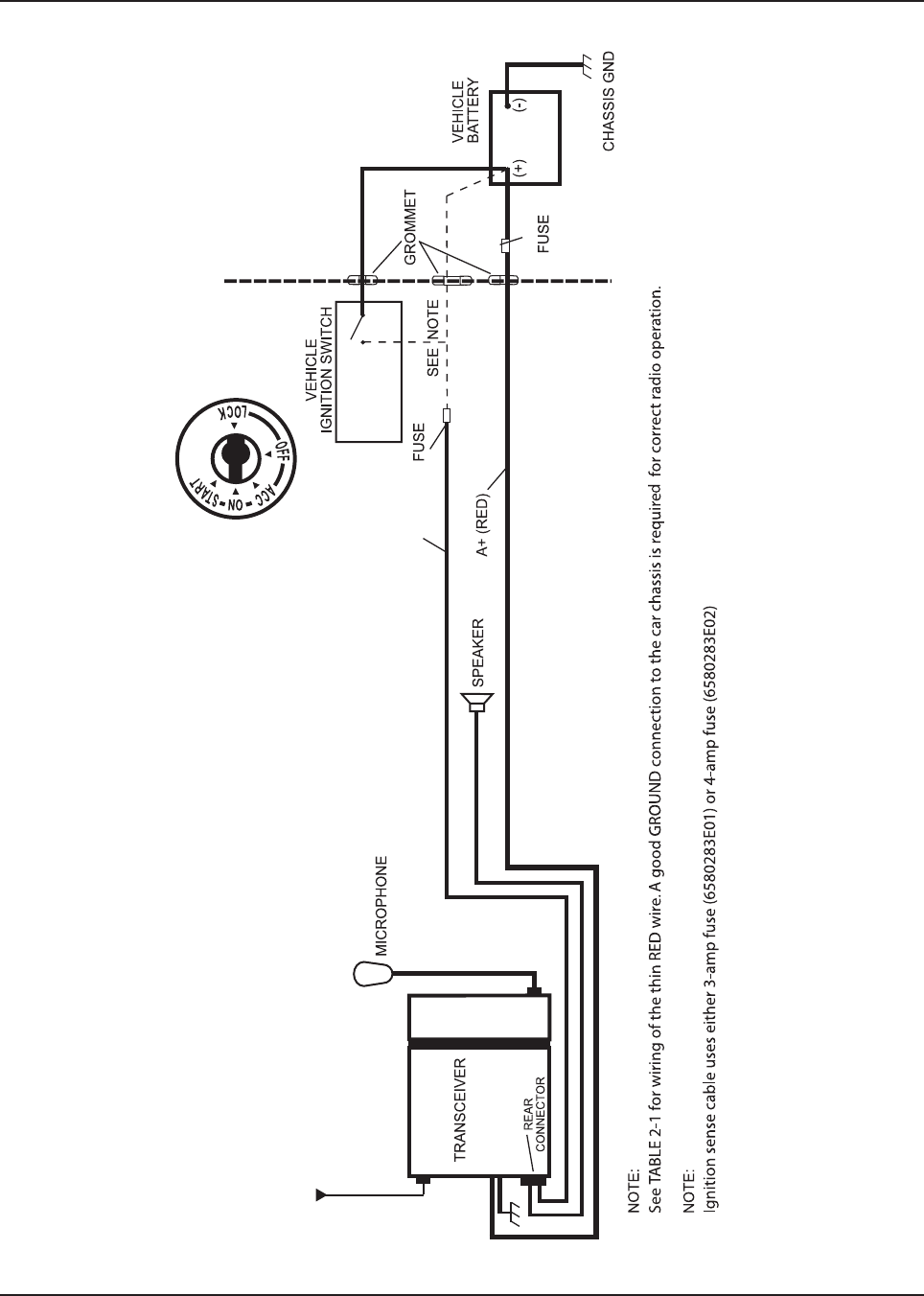
6878215A01
Standard Configurations Planning the Installation 2-11
RADIO COMPARTMENT = OPERATOR COMPARTMENT VEHICLE BATTER
Y
COMPARTMENT
CONTROL HEAD
IGN SENSE
(thin RED)
ACC line
Figure 2-19. Cabling Interconnect Diagram for Dash Mount (Cannot Be Used for 100W Radios)
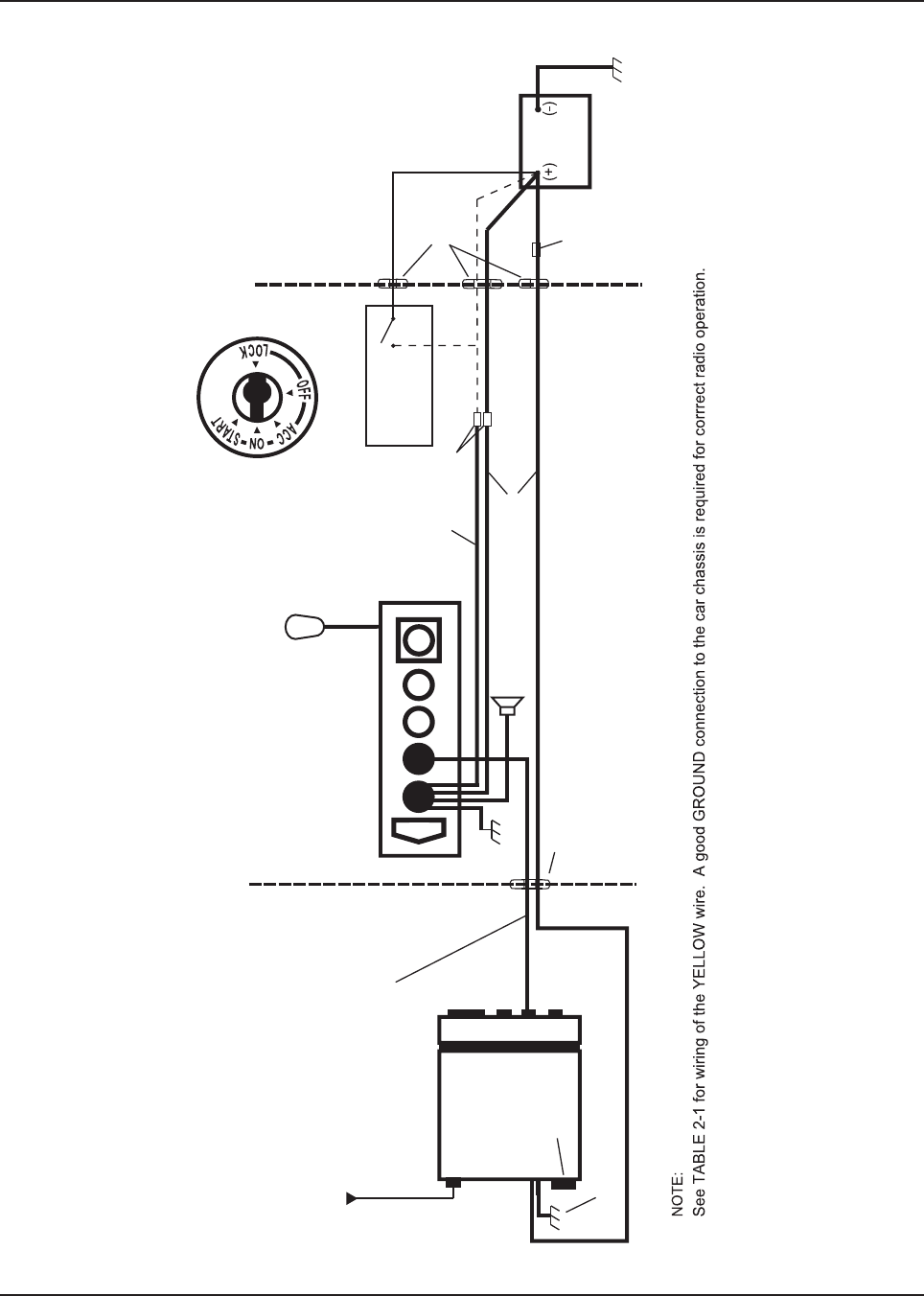
6878215A01
2-12 Standard Configurations Planning the Installation
IGN SENSE
(YELLOW)
ACC line
VEHICLE
IGNITION SWITCH
GROMMET
VEHICLE
BATTERY
CHASSIS GND
MICROPHONE
CONTROL HEAD (REAR VIEW)
DIGITAL CONTROL CABLE
REMOTE MOUNT OPERATION
RADIO COMPARTMENT VEHICLE BATTER
Y
COMPARTMENT
OPERATOR COMPARTMENT
TRANSCEIVER
CHASSIS GND
REAR
CONNECTOR
TIB
GROMMET
SPEAKER A+ (RED)
SEE NOTE
FUSE
FUSE
Figure 2-20. Cabling Interconnect Diagram for Remote Mount
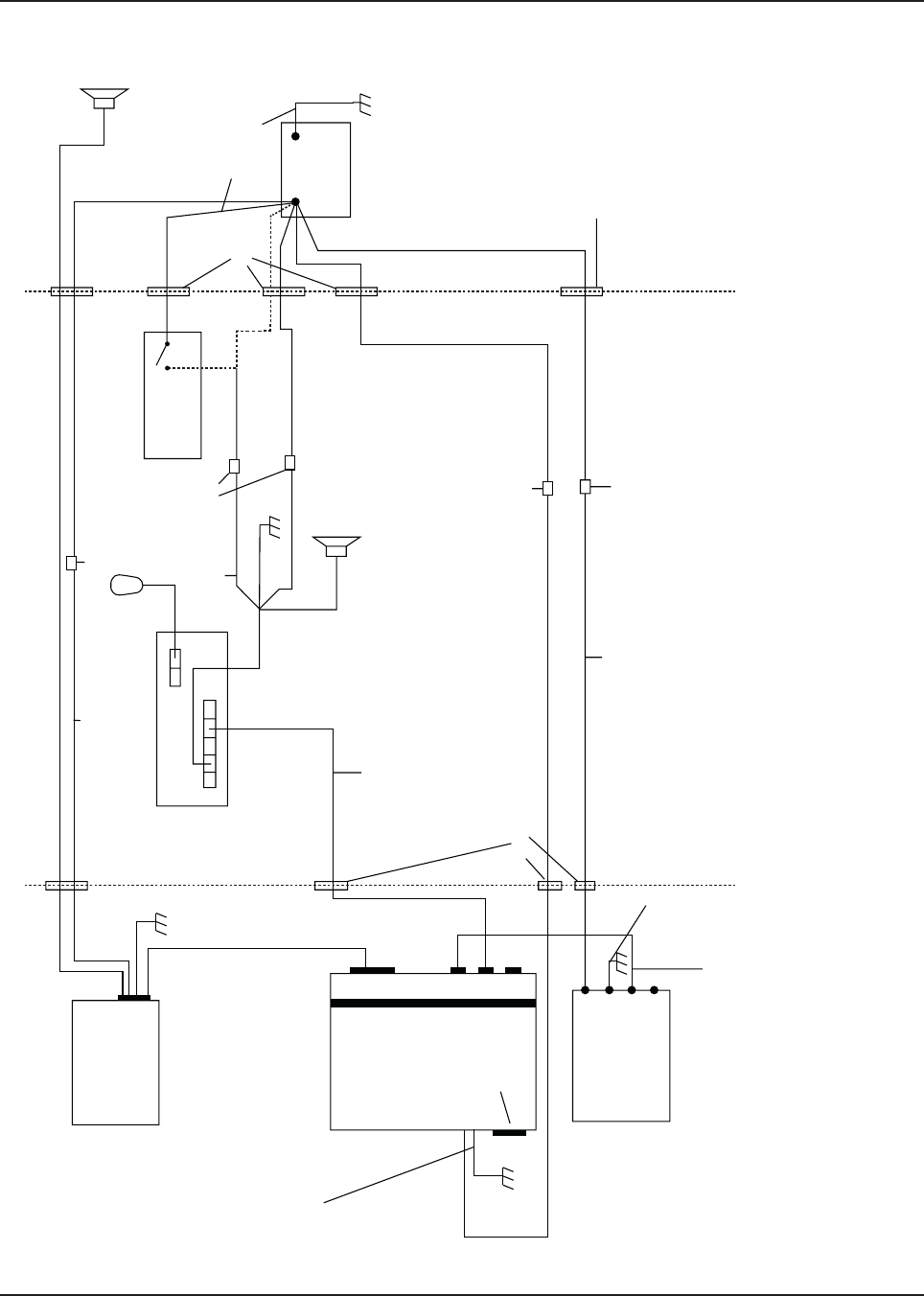
6878215A01
Standard Configurations Planning the Installation 2-13
RADIO COMPARTMENT OPERATOR COMPARTMENT VEHICLE BATTERY
COMPARTMENT
Siren Box
CAUTION
(BLK)
A+
(Red)
A+
(Red)
15A Fuse
MICROPHONE
VEHICLE
IGNITION SWITCH
VEHICLE
BATTERY
PART OF
VEHICLE
WIRING
Siren Speaker
ON/ACC
3A OR 4A FUSE SEE NOTE
SPEAKER
RADIO POWER CABLE
(RED/BATTERY HOT)
15A, 20A OR
30A FUSE
16A Circuit Breaker
GROMMET
GROMMET
GROMMET
REAR
CONNECTOR
URC Controller
Box
Chassis GND
GCAI to RJ45
Cable
RADIO
TIB
Chassis GND
CAN extension cable
A+
(Red)
IGN Sense
(yellow)
(BLK)
Control Head (Rear View)
Chassis GND
(+) (-)
Figure 2-21. Cabling Interconnect Diagram for 09 Remote Mount (URC is optional.)
NOTE:
For remote mount configurations, do not supply IGNITION at the radio's rear accessory connector. IGNITION should be supplied according to TABLE 2-2. See TABLE 2-2 for combinations of wiring th
e
RED and YELLOW cables.
The RED and YELLOW power cables connect to either the vehicle battery or the ignition switch. Connect the RED cable directly to the battery. The receiver operates when the control head is on. Conne
c
the YELLOW cable to the ignition switch. The transmitter operates only when the ignition switch is on.
Alternate connections: Connecting both RED and YELLOW cables to the battery allows the control head to turn the receiver and transmitter on or off. Connecting both RED and YELLOW cables to th
e
ignition switch allows the ignition switch to turn the receiver and transmitter on or off. Alternator whine and other noise problems may occur. Isolate the RED cable with a Motorola relay (5900813674).

6878215A01
2-14 Standard Configurations Planning the Installation
2.1.3 Radio Operation Wiring for Dash and Remote Configurations
Determine from Table 2-1, Table 2-2, or Table 2-3 the radio functionality you wish to achieve, which is
controlled by the vehicle’s ignition switch state, the physical wiring of the radio’s ignition sense (ACC)
wire, and by the programmed CPS setting. For additional radio functionality as determined by the
programming of the ignition switch in CPS, refer to the HELP menu in your CPS (i.e. Ignition as:
Required, Blank, Soft Power Off, TX Inhibit, PTT TX Inhibit, Ignition Only Power Up).
Choose a clean ignition point which is not shared in the immediate vicinity by other high current
accessories/devices. This will help to reduce the transients on the ignition line. Examples of
high-current accessories/devices are: Air Horn, relays, lightbars and etc. It is recommended to wire
to the vehicle’s ACC line, not the START or the solenoid side of the ignition circuit. Refer to chapter 6
for best installation practices. The Ignition sense (ACC) cable uses either a 3-amp fuse
(6580283E01) or 4-amp fuse (6580283E02).
2.1.3.1 Dash Mount: Power, Ignition, and Emergency Cable Installation
The standard dash mount rear ignition sense cable HLN6863 contains a “thin red” ignition wire, a
jumper wire that shorts emergency to ground, and two gray wires attached to an external speaker
plug. The thin RED wire is the ignition sensed wire. Refer to Table 2-1, Table 2-2, or Table 2-3 for its
correct wiring configurations.
NOTE: This cable MUST be attached in order for the radio to operate in Dash mount, regardless of
how emergency is programmed in CPS or wired inside the vehicle. Either the emergency
jumper wire or an emergency accessory (footswitch or button) must be wired to the rear of the
transceiver in Dash mount. Otherwise, upon attachment of the radio’s power cable to the
vehicle battery, the radio will incorrectly determine that emergency operation has been
activated, such as when an emergency footswitch is de-pressed and the emergency pin is
ungrounded.

6878215A01
Standard Configurations Planning the Installation 2-15
2.1.3.2 Remote Mount: Power, Ignition, and Emergency Cable Installation
The single control head O2, O5, O7 or O9 remote mount configurations receive power from the J200
connector’s red and black wires. The yellow wire at J200 is one ignition sense wire. On mid power
radios, the J2 and J600 connectors can also be used for ignition sense. On high power radios, the
J200 yellow wire or the J600 connector can be used for ignition sense. If the HLN6863 is attached at
J100 of the O2, O5, O7 or O9 control head, the “thin red” wire will NOT function as an ignition sense
wire, since the J100 connector has no ignition sense electrical connection.
NOTE: It is incorrect for installation to attach ignition sense at more than one wire or connector.
Refer to Table 2-1 or Table 2-2 for its correct wiring configurations.
The O3 control head receives its power down the CAN cable, and detects the ignition state by the
ignition sense pin at either J2 or J600. On mid power radios, the J2 and J600 connectors can also be
used for ignition sense. On high power radios, only the J600 connector can be used for ignition
sense.
In Multi-Control Head installations, the yellow ignition wire must be connected to the head assigned
ID # 1. See Section 2.2.2.5 “Setting the Initial Control Head ID” on page 2-29 for further information.
In remote mount O2, O3, O5, O7 or O9, an Emergency jumper to ground is placed by default on the
TIB (JU344) so that there is no need to attach a cable with an emergency accessory at either J2 or at
J600. This jumper must be removed if an emergency accessory (footswitch or button to Ground) is
installed at either J2 or J600 (or J626 on the accessory cable) locations. If the jumper JU344 is
removed but no emergency accessory is installed, the radio will power-up incorrectly into emergency
mode all the time. Refer to Figure 4-3 for details.
The design of the control head is different compared to the transceiver, therefore it is also NOT
necessary to attach HLN6863 at J100 to prevent accidental emergency operation. The control head
uses an edge-detect, not a state-detect like on the transceiver, so mounting of HLN6863 is not
mandatory.
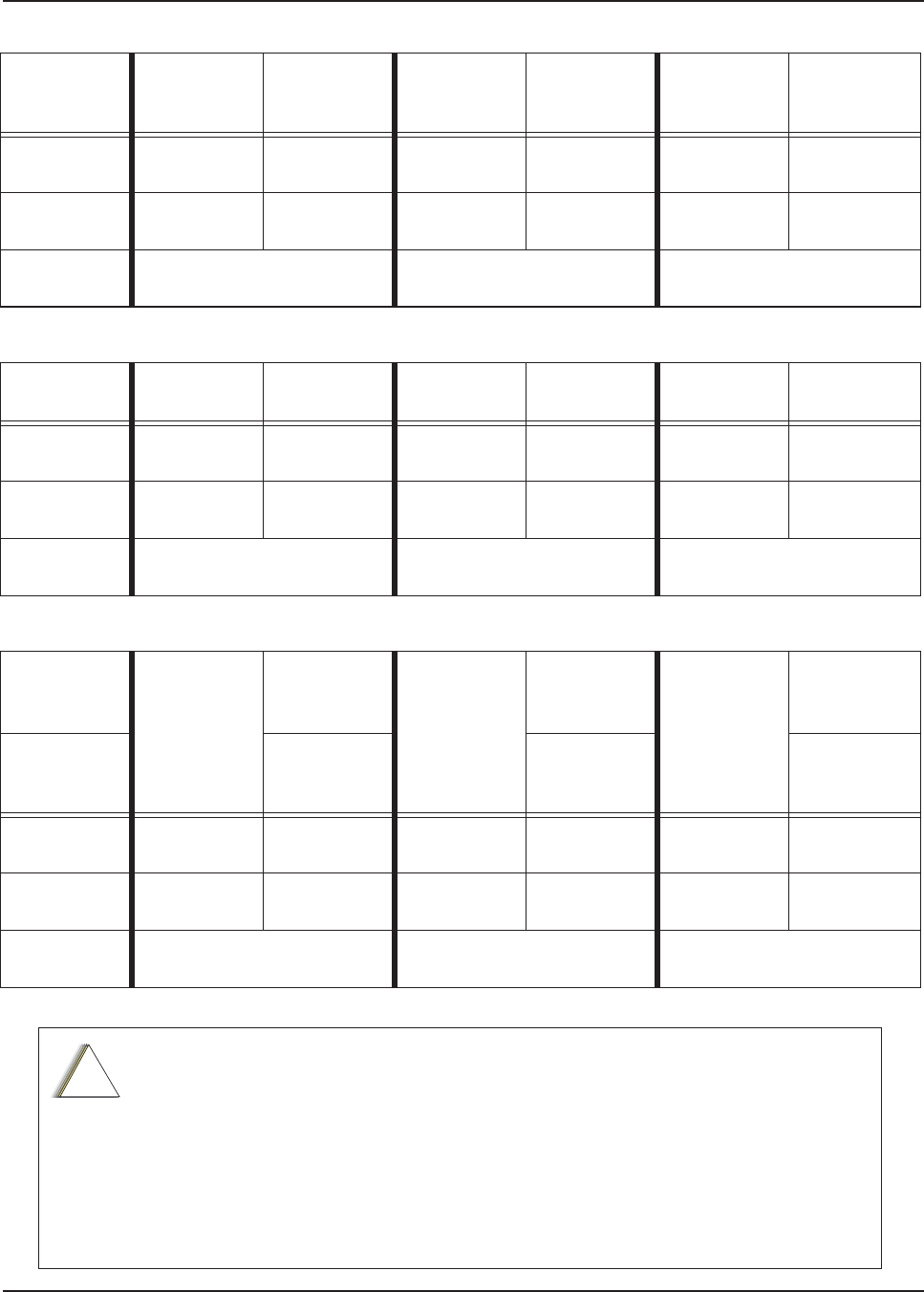
6878215A01
2-16 Standard Configurations Planning the Installation
Table 2-1. Dash O2, O5 or O7 Radio Operations Dependent Upon A+ and Ignition Connections
Dash Mount Transceiver
Red Power
Wire
HLN6863
Thin Red Wire
Transceiver
Red Power
Wire
HLN6863
Thin Red Wire
Transceiver
Red Power
Wire
HLN6863
Thin Red Wire
Connected to
battery
XXX X
Connected to
ignition switch
XXX
Ignition switch
controls
No ignition switch control. Enables ignition switch functionality
as programmed in the codeplug.
Illegal wiring configuration. See
CAUTION note.
Table 2-2. Remote O2, O5, O7, or O9 Radio Operations Dependent Upon A+ and Ignition Connections
Remote
Mount Control Head
Red Wire Control Head
Yellow Wire Control Head
Red Wire Control Head
Yellow Wire Control Head
Red Wire Control Head
Yellow Wire
Connected to
battery
XXX X
Connected to
ignition switch
XXX
Ignition switch
controls
No ignition switch control. Enables ignition switch functionality
as programmed in the codeplug.
Illegal wiring configuration. See
CAUTION note.
Table 2-3. Remote O2, O5, O7 or O9 Radio Operations Dependent Upon A+ and Ignition Connections
Mid Power
Dash/Remote Transceiver
Red Power
Wire
HLN6863
Thin Red Wire
at J2 Transceiver
Red Power
Wire
HLN6863
Thin Red Wire
at J2 Transceiver
Red Power
Wire
HLN6863
Thin Red Wire
at J2
High Power
Dash/Remote
HLN6863
Thin Red Wire
at J626
HLN6863
Thin Red Wire
at J626
HLN6863
Thin Red Wire
at J626
Connected to
battery
XXX
Connected to
ignition switch
XXX
Ignition switch
controls
No ignition switch control. Enables ignition switch functionality
as programmed in the codeplug.
Illegal wiring configuration. See
CAUTION note.
DO NOT connect any wires to the battery terminals until you have finished the entire
radio installation (Dash or Remote Mount) configuration to avoid potential equipment
damage.
Incorrect wiring of the radio may result in incorrect ignition sense detection, incorrect
power-on state, or incorrect power-off state of the radio system.
The Control Head Power cable wire (RED) and Transceiver Power cable wire (RED)
are always attached to the battery terminal and NOT to the ignition switch.
!
C a u t i o n

6878215A01
Standard Configurations Planning the Installation 2-17
2.1.4 Ignition Sense Switch (Radio Wide Advance)
CPS selectable settings to control the radio’s functionality based on the state of the vehicle’s Ignition
status.
NOTE: When either TX Inhibit, PTT TX Inhibit or Required are selected, the Emergency Power Up
feature will not be available to the radio-user.
When any other Ignition Switch setting is made, Emergency Power Up is available to the
radio-user, regardless of current ignition state.
Any optional inactivity time-out timer setting in CPS may delay the power off of the radio once
Ignition sense is removed.
Table 2-4. Ignition Sense Switch Settings in CPS
Feature Description
Blank • Radio POWERS ON when the Power Button is pressed or with the emergency power up
feature.
• Radio POWERS OFF when the Power Button is pressed.
TX Inhibit • Radio POWERS ON when the Power Button is pressed or with the emergency power up
feature.
• Radio POWERS OFF when the Power Button is pressed.
•If IGNITION is not present all transmissions are inhibited.
• The radio will not affiliate with trunking systems and therefore CANNOT receive any
trunking dispatch communications.
• Emergency Alarm transmissions are NOT possible with the use of the emergency power
up feature.
PTT TX Inhibit • Radio POWERS ON when the Power Button is pressed or with the emergency power up
feature.
• Radio POWERS OFF when the Power Button is pressed.
•If IGNITION is not present all transmissions are inhibited.
• The radio is able to affiliate with trunking systems. The radio can ONLY receive trunking
dispatch communications.
• Emergency Alarm transmissions are possible with the use of the emergency power up
feature.
Required • Radio POWERS ON when the Power Button is pressed and Ignition is present.
• Radio POWERS ON when Ignition is cycled and radio was previously ON.
• Radio POWERS OFF when the Power Button is pressed, or when Ignition is lost.
Soft Power Off • Radio POWERS ON when the Power Button is pressed, or when Ignition is detected.
• Radio POWERS OFF when the Power Button is pressed, or when Ignition is lost.
Ignition Only Power Up • Radio POWERS ON when Ignition is present.
• Radio POWERS OFF when Ignition is lost.
• Control head power button is ignored.

6878215A01
2-18 Standard Configurations Planning the Installation
2.1.5 Siren/PA Configuration/Programming
The Siren/PA is shipped pre-wired for 100W operation. It can be rewired for 65W, 75W, or 130W
power levels.
To change to another power level, perform the following:
1. Open the Siren/PA connector cover to gain access to the two-connector speaker leads. Do
not change the speaker common lead (pin 20). The other lead is connected to pin 35 (for
100W operation).
2. Using an appropriate pin removal tool, extract pin 35 and move it to one of the following pin
locations:
- pin location 36 for 75W operation
- pin location 28 for 65W or 130W operation
3. For 65W or 75W operation, no further changes are required. Reassemble the connector.
4. For 130W operation, you must parallel two 11ȍ speakers, each rated at 65W minimum.
Proper phasing of the two speakers is important--when connecting two speakers in parallel,
wire similar speaker terminals together to ensure maximum loudness and prevent
"deadspots." For example, if the terminals are marked "1" and "2", connect the terminals
marked "1" together and connect those wires to one speaker lead. Connect the terminals
marked "2" together and connect those wires to the other speaker lead.
5. When the Siren/PA is configured for dual speaker, 130W operation, it is necessary to remove
a resistor and move two jumpers to set the correct power level. Remove the Siren/PA cover,
and locate resistor R219 (0 ohm). This resistor should be removed for 130W operation.
Locate jumpers JU100 and JU101. These jumpers should be installed for 130W operation.
6. Close and reconnect the Siren/PA connector cover.
NOTE:Jumpers JU100 and JU101 do not affect the Siren output level. JU100 and JU101
compensate for the lower speaker load and the two speakers in parallel, by
decreasing the gain U102-1. JU100 affects the radio PA level and JU101 affects the
PA audio level.
Pin locations of various power level configurations are listed in Table 2-5
Before continuing, remember that under a high-line supply condition
(16.6V), up to 30% more power will go to the speaker(s) after
reconfiguring for 130W operation. Do this only when your PA
speakers are capable of handling the extra power.
Table 2-5. Power Level Configurations
Pin location of speaker
leads R219 JU100/JU101
65W 20,28 IN Across pins A and B
75W 20,36 IN Across pins A and B
100W 20,35 IN Across pins A and B
130W 20,28 OUT Across pins B and C
!
C a u t i o n
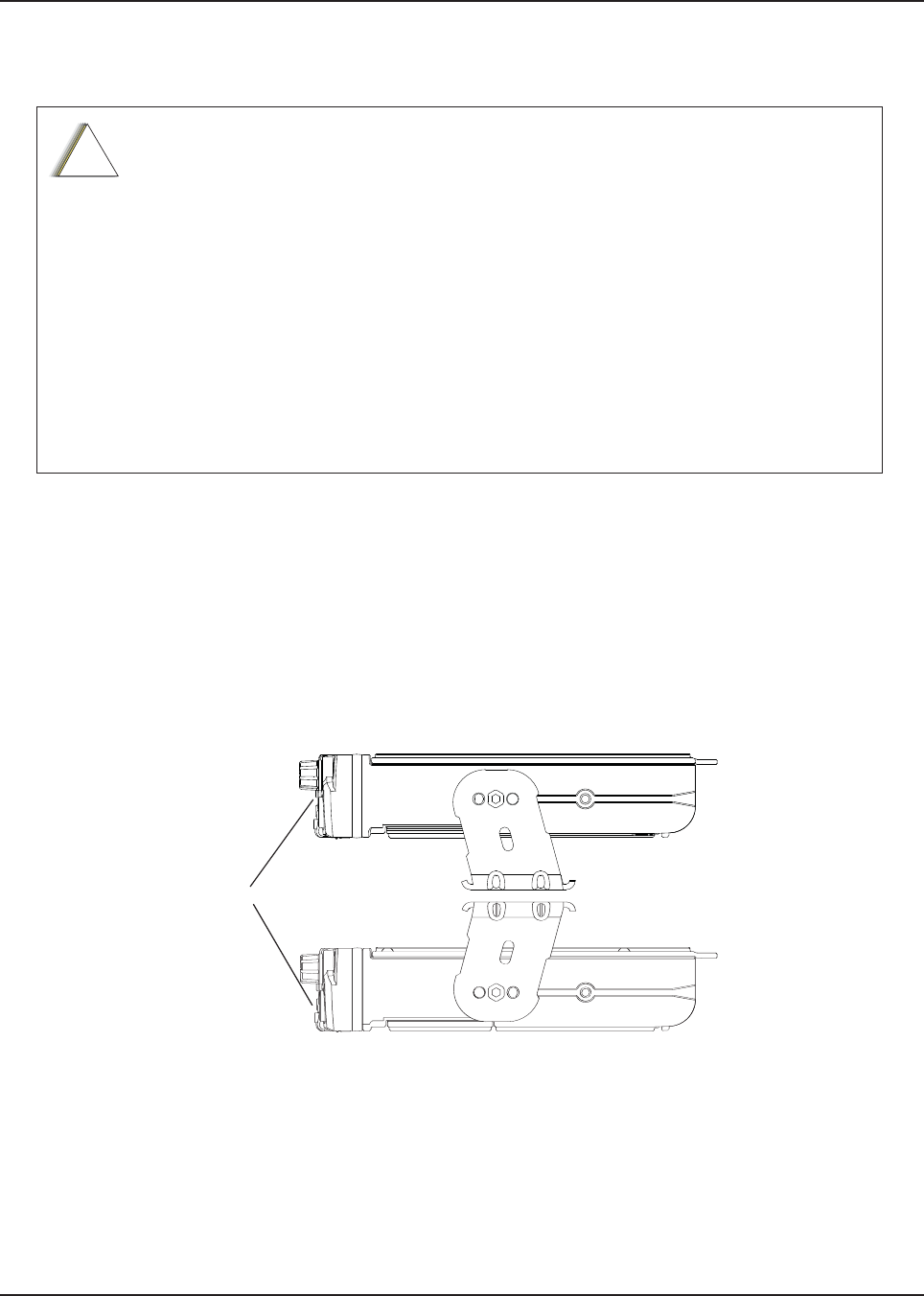
6878215A01
Standard Configurations Radio Mounting 2-19
2.2 Radio Mounting
The mounting location must be accessible and visible. Select a location that will permit routing the
RF antenna cable as directly as possible.
NOTE: For optimum radio performance, orient the mounting trunnion as shown in Figure 2-22 or
Figure 2-23 for mid power and Figure 2-24 for high power. For new or existing installations of
all but 100W radios, use only the APX mobile trunnion, kit number HLN7002_except for APX
2500 and APX 4500 which shall use the trunnion with kit number HLN6861_. For new or
existing installations of 100W radios, use only the APX mobile trunnion, kit numbers
HLN7003_.
Figure 2-22. APX 7500/ APX6500/ APX5500/ APX6500Li Mid Power Trunnion Orientation
(Cannot Be Used for 100W Radios)
DO NOT mount the radio on a plastic mounting surface without first reinforcing the
mounting surface; the weight of the radio may crack or break the mounting surface.
DO NOT mount the radio on a flat or concave surface where the radio could be
partially submersed in water. This is especially important if the cab area of the vehicle
is cleaned by spraying with water. If the radio sits in water for a length of time, moisture
may seep inside the radio and damage the electronic components.
DO NOT allow water to stand in recessed areas of vertically mounted radios. Remove
any moisture immediately to prevent it from seeping down into the radio.
Care must be taken to shield the control head (front and back) from direct exposure to
pressurized water. The pressurized water from a hose, in most cases, is more severe
than the stated test and conditions in typical environments.
!
C a u t i o n
RADIO FRONT
APPLIES TO RADIOS IN DASH AND REMOTE INSTALLATIONS
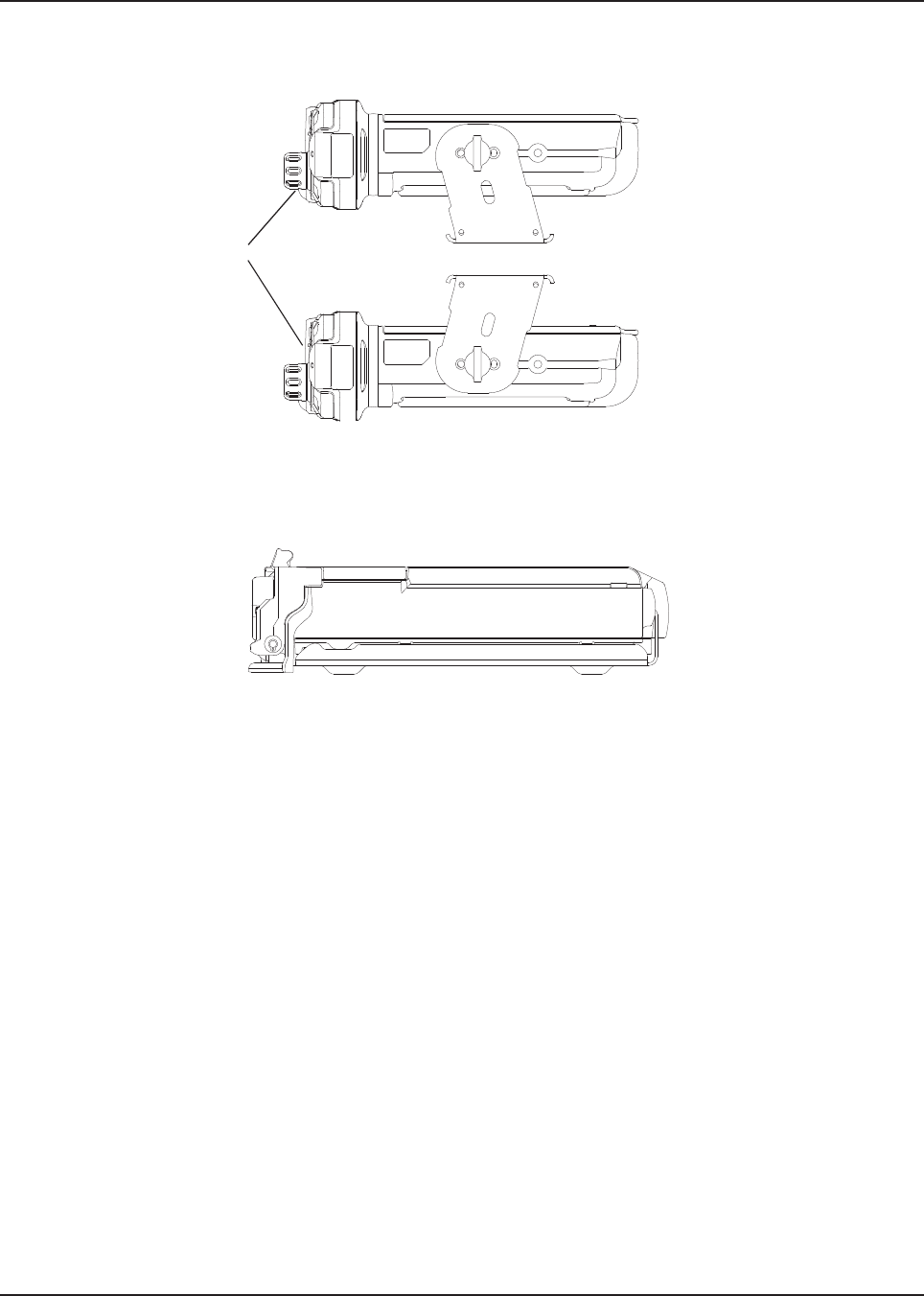
6878215A01
2-20 Standard Configurations Radio Mounting
Figure 2-24. Trunnion Orientation for 100W Radios
Figure 2-23. APX 2500/APX4500 Mid Power Trunnion
Orientation (Cannot Be Used for 100W Radios)
RADIO FRONT

6878215A01
Standard Configurations Radio Mounting 2-21
2.2.1 Dash Mount with Trunnion
NOTE: This configuration is not applicable for 100W radios.
1. Referring to Figure 2-6, select the suitable trunnion kit per the type of mid power transceiver.
2. Select the location to mount your radio on the transmission hump (see Figure 2-25) or under
the dash (see Figure 2-26).
NOTE: When mounting the trunnion on the transmission hump take care the transmission housing is
not affected. Plan your installation ensuring enough room for the Accessory connector and
cable in the back of the radio.
3. Using the trunnion mounting bracket as a template, mark the positions of the holes on the
mounting surface. Use the innermost four holes for a curved mounting surface such as the
transmission hump, and the four outmost holes for a flat surface such as under the dash.
4. Center punch the spots you have marked and realign the trunnion in position.
5. Secure the trunnion mounting bracket with the four self-drilling screws provided
(see Figure 2-25 and Figure 2-26).
6. Ensure that the plastic guides are aligned (horizontal) to the grooves of the trunnion. Slide the
radio into the grooves until it snaps into place (see Figure 2-26).
Table 2-6. Mid Power Trunnion Kit
Item Part Number Description Mid Power Transceiver
1
0371859H01 Trunnion Mounting Screw APX 5500/APX 6500/APX 6500 Li/APX 7500
0305760W02 Trunnion Mounting Wing Screw APX 2500/APX 4500
2 0312002B14 Self-Drilling Tapping Screw
APX 5500/APX 6500/APX 6500 Li/APX 7500
APX 2500/APX 4500
3
HLN7002_ Mackinaw Trunnion Hardware Kit APX 5500/APX 6500/APX 6500 Li/APX 7500
HLN6861_ Millenium Trunnion Hardware Kit APX 2500/APX 4500
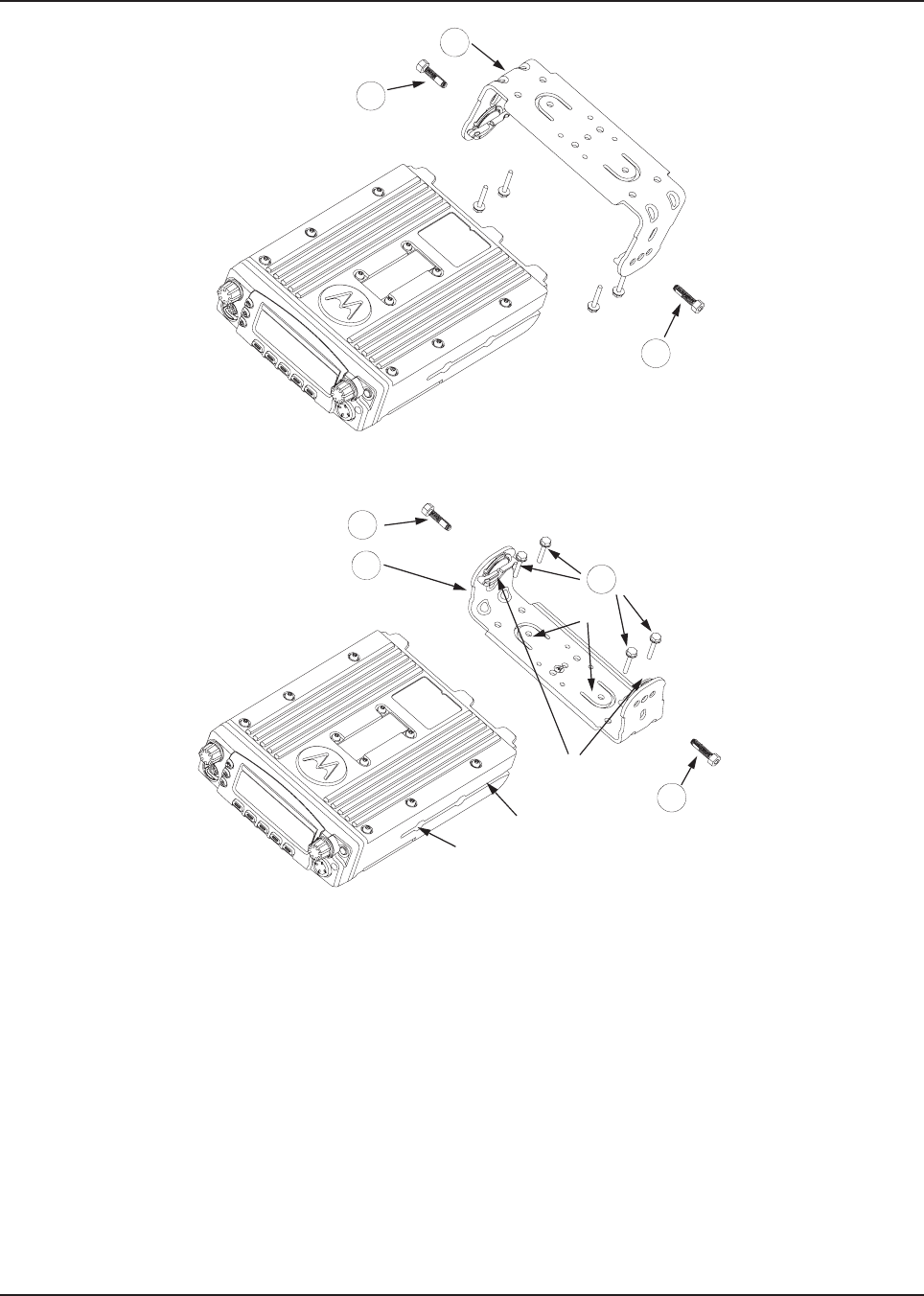
6878215A01
2-22 Standard Configurations Radio Mounting
Figure 2-25. Transmission Hump Trunnion Mounting
Figure 2-26. Below Dash Trunnion Mounting
7. Secure the radio with two screws provided (Item 1 in Table 2-6). The torque down force for
0371859H01 should be between 50in-lbf to 52in-lbf.
8. For screw 0305760W02, the wing screw torque tool (HLN6970_) is designed to securely
tighten the trunnion wing screws while installing the radio. The tool can also be used to
loosen the wing screws. Detailed instructions are included in the tool packaging.
NOTE: This configuration shows the O5 control head. The TIB is used for O3 control head for the
same configuration.
Tabs
Threaded Hole
for Screw
Groove
Plastic
Guides
1
32
1
1
1
3

6878215A01
Standard Configurations Radio Mounting 2-23
2.2.2 Remote Mount with Trunnion
For a remote mount installation, the transceiver may be mounted anywhere in the vehicle, provided
that the installation location is safe, follows the cautions mentioned at the beginning of this section,
and is accessible for servicing/maintenance as well as cabling. A typical mounting location
recommended by Motorola is in the vehicle’s trunk. The trunnion provided may still be used to mount
the transceiver, and the mounting process is the same as for the dash mount installation
(Section 2.2.1 on page 2-21). However, for 100W radios you must follow the procedure detailed
below in Section 2.2.2.1. See Figure 2-10, Figure 2-11, Figure 2-13, or Figure 2-14 for a remote
installation.
Before installing any electrical equipment, check the vehicle manufacturer’s user
manual.
The installation of this device should be completed by an authorized servicer or
installer.
Before making any holes in the trunk for radio mounting, check the vehicle
manufacturer's user manual for restrictions (e.g. due to the gas tank location).
!
C a u t i o n
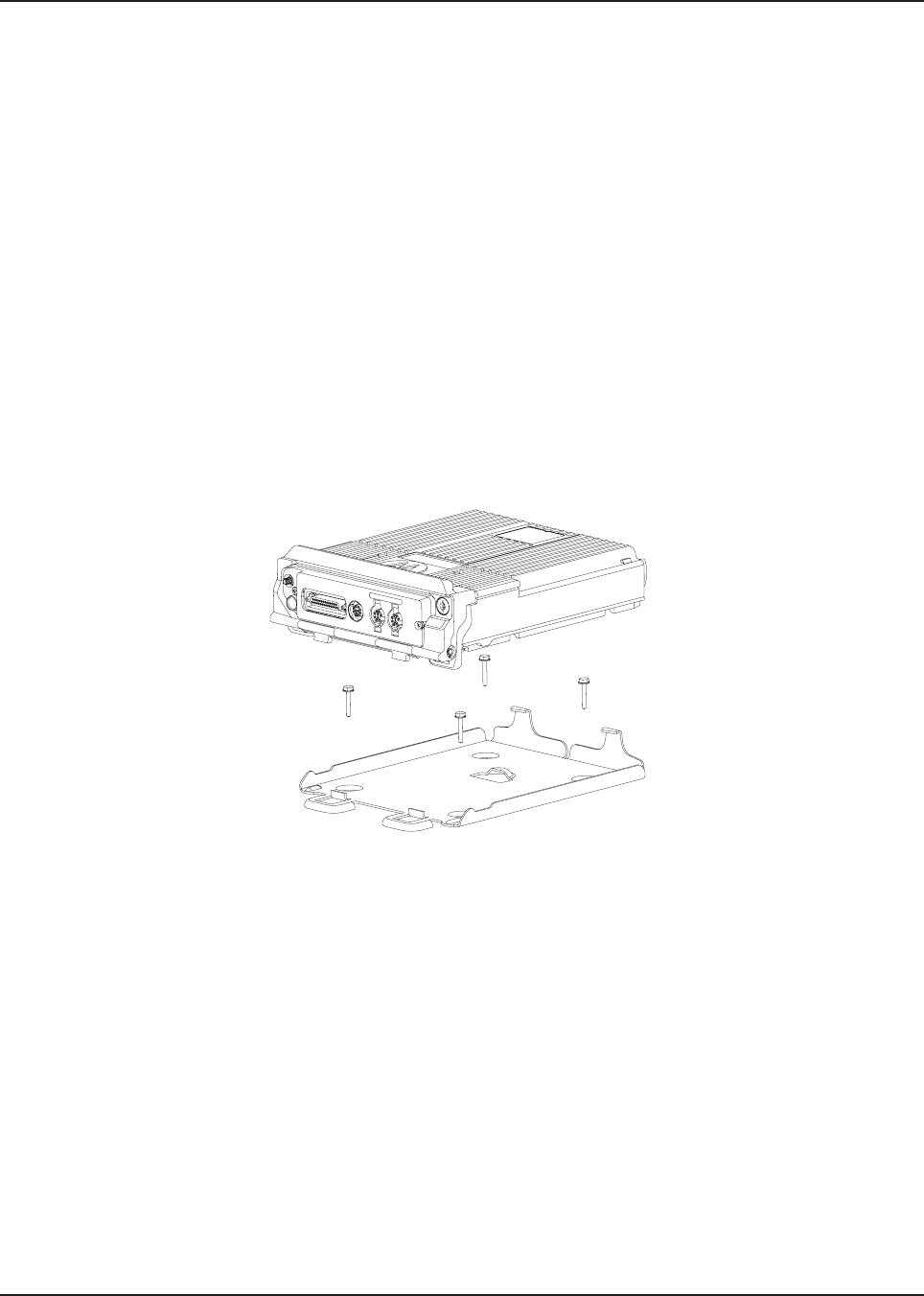
6878215A01
2-24 Standard Configurations Radio Mounting
2.2.2.1 100W Radios Only
NOTE: Cabling to the front of the radio (TIB) should not be completed with the handle opened as it is
needed to be removed to close the handle. It is suggested that the cabling is to be attached
to the front of the radio after the radio is assembled into the trunnion.
1. After selecting the mounting location, use the trunnion mounting bracket as a template and
mark the positions of the holes on the mounting surface.
2. Center-punch the spots you have marked and realign the trunnion in position.
3. Secure the trunnion mounting bracket with the four self-drilling screws provided
(see Figure 2-27).
4. After the trunnion has been mounted in the vehicle using the screws provided, install the
radio. Place the radio with the lock handle fully opened on the trunnion, oriented at least
10 mm in front of the rear catches. Push the radio towards the rear catches. The radio is lifted
up slightly and then drops back down, flushed with the trunnion, and stops against the rear
catches. Once this occurs, close the lock handle. Rotate the handle towards the top of the
radio until it is locked in place. The key is not needed in the lock to close the handle, but is
needed to reopen. The keys can only be removed from the lock when it is in the locked
position.
Figure 2-27. 100W Radio Mounting into Quick Release Trunnion
2.2.2.2 Remote Mount Control Head Installation
Choose a mounting location for the radio, considering accessibility, and control and antenna cable
lengths.
The recommended mounting surfaces for the control unit are under the mounting surface, on the
transmission hump, or on the center console. Figure 2-28 and Figure 2-29 shows how the trunnion,
control head, and cables should be installed for the O2, O5, O7 or O9 control head.
NOTE: Connector-protective covers (i.e. Dust Covers) HLN6980_ are provided with the radio.
They should be installed on exposed connectors for added environmental robustness.
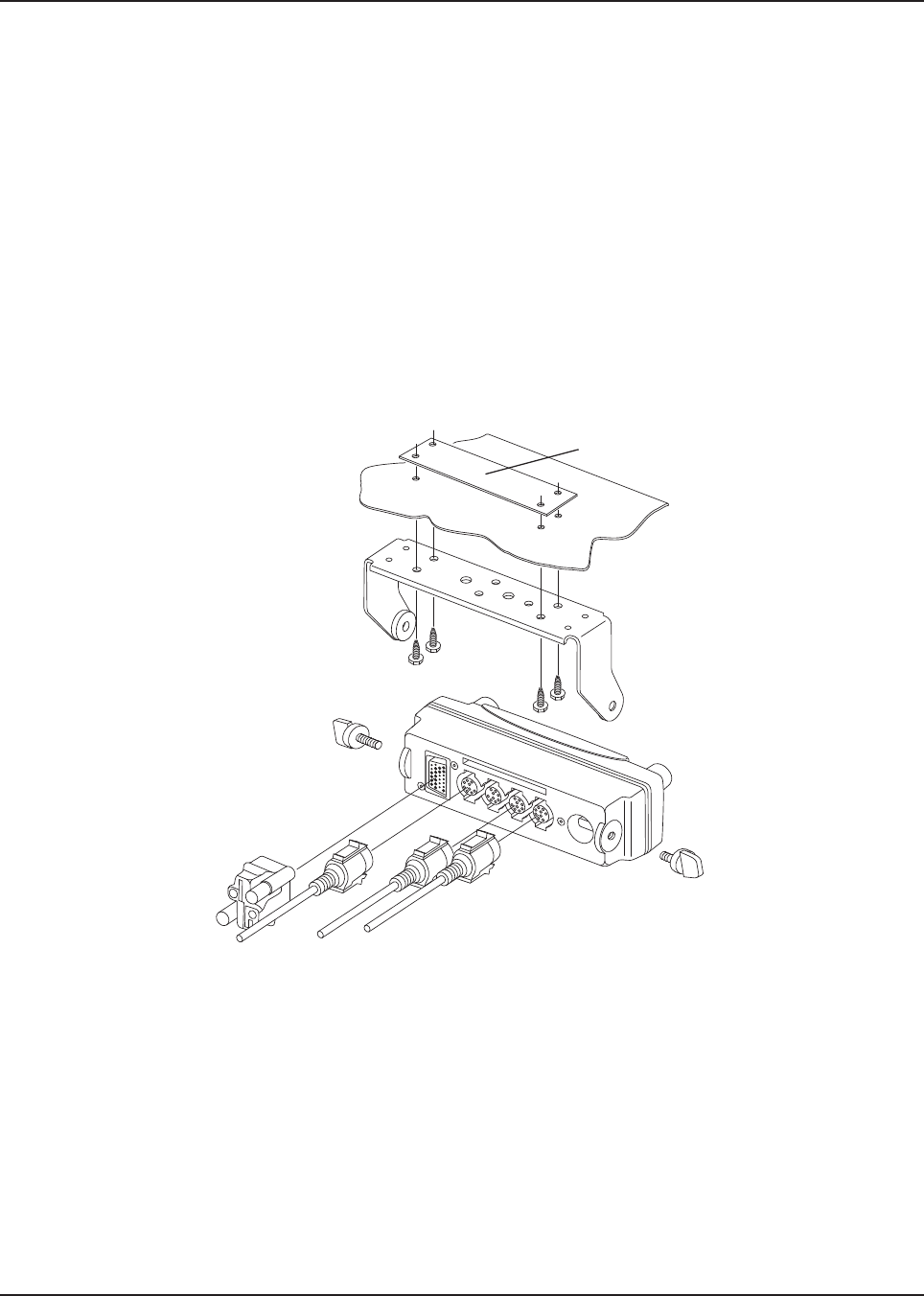
6878215A01
Standard Configurations Radio Mounting 2-25
An adjustable trunnion, which allows a number of mounting positions, is supplied for mounting the
control unit. The installation must not interfere with the operation of the vehicle or its accessories, nor
disturb passenger seating or leg room. The control head must be within convenient reach and
viewing of the user.
If the trunnion is mounted on a plastic mounting surface, all four mounting screws should penetrate
the mounting surface’s supporting metal frame. If that is not possible, use a metal backing plate (not
supplied) to strengthen the installation. Install the control follows:
1. Use the control unit trunnion as a template to mark the mounting holes; drill 5/32" holes.
If mounting on a plastic surface, use a metal backing plate.
2. Attach the trunnion bracket using all four 10-16" x 5/8" self-tapping screws provided.
3. Temporarily install the control head (adjusting for proper viewing angle) and fasten it to the
trunnion with two wing screws. Test the installation to be sure the control head feels securely
locked in place while you are pressing its buttons.
4. Finish installation by fully tightening screws.
Figure 2-28. O5 Control Head Installation Exploded View
(Also applicable for O2 and O7 Control Heads)
Metal Backing Plate
(Not Supplied)
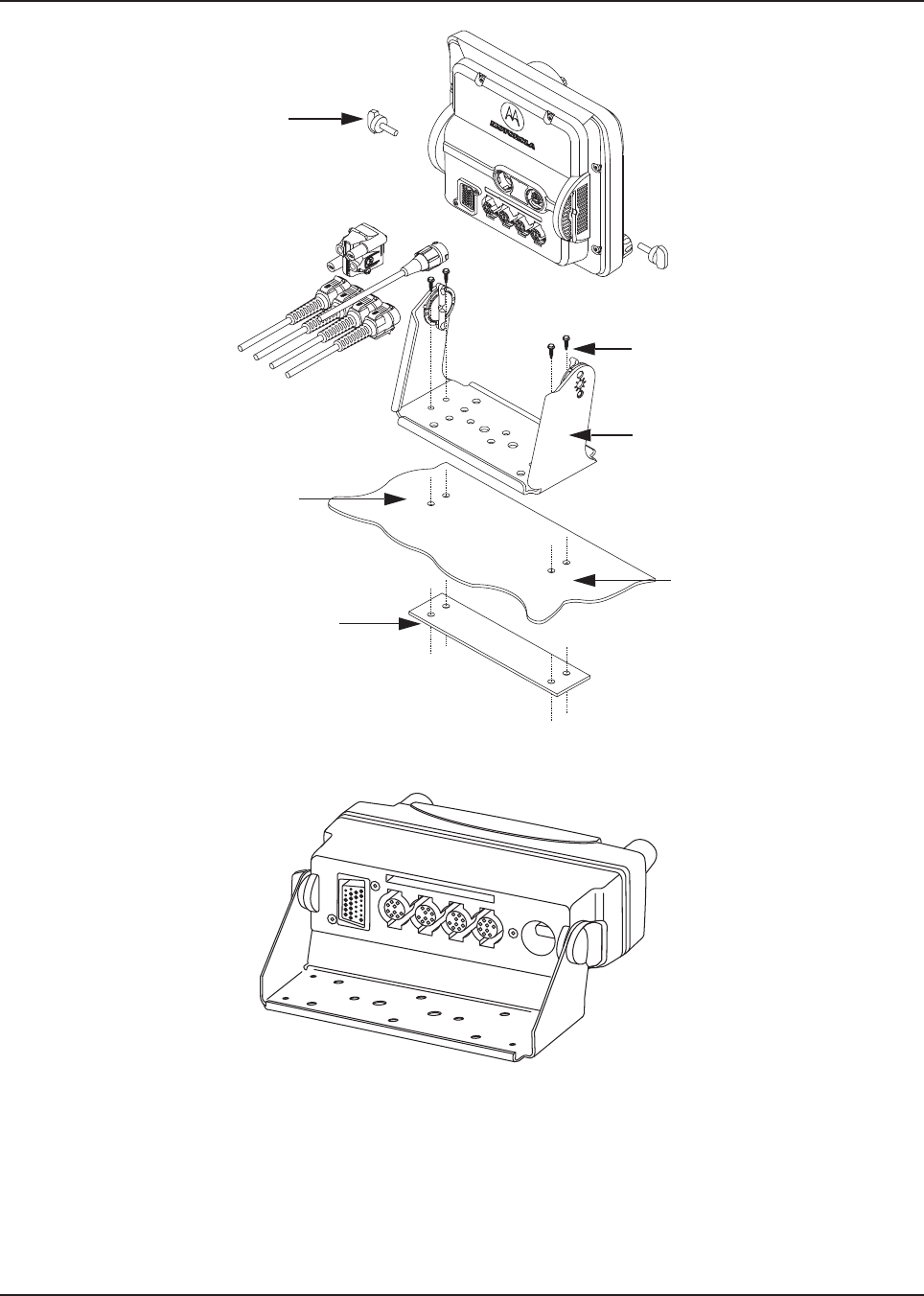
6878215A01
2-26 Standard Configurations Radio Mounting
Figure 2-29. O9 Control Head Installation Exploded View
Figure 2-30. O5 Control Head Rear View
(Also applicable for O2 and O7 Control Heads)
ADJUST THE CONTROL HEAD TO
DESIRED ANGLE AND SECURE
WITH WING SCREWS
USE FOUR MOUNTING SCREWS
ON ALL INSTALLATIONS
TRUNNION
DRILL FOUR 5/32'' HOLES
IN MOUNTING SURFACE
MOUNTING SURFACE
IMPORTANT
USE A METAL BACKING PLATE
(NOT SUPPLIED) IF MOUNTING
TRUNNION ON PLASTIC OR
UNSTABLE SURFACE
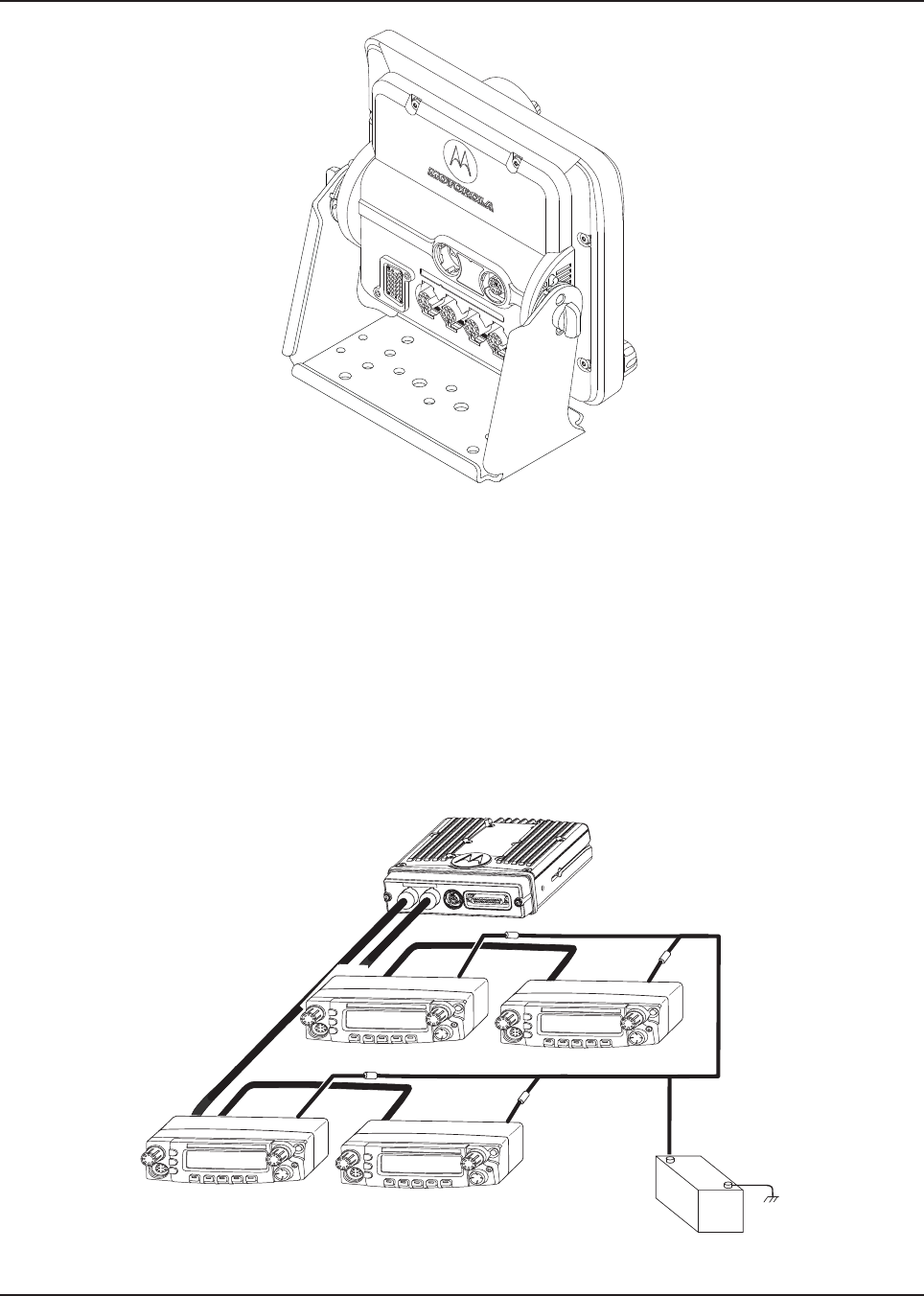
6878215A01
Standard Configurations Radio Mounting 2-27
Figure 2-31. O9 Control Head Rear View
2.2.2.3 Multiple Control Head Installation
Control heads in a multiple control head configuration should be installed per the steps detailed in
Section 2.2.2.2: “Remote Mount Control Head Installation” on page 2-24. Two heads can be
connected to each of the two CAN connectors on the transceiver, with the remaining heads
connected to one or both of the first two. Control heads can also be connected a “daisy chain”
configuration from a single transceiver CAN connector. See Figure 2-32 for examples.
NOTE: The transceiver must be configured for Multiple Control Head via CPS programming.
Navigate to the “Control Head” tab in the Radio Wide section of CPS, and select “Help” for
further information and tutorials.
Control Head 1 Control Head 2
J300R J300R
J200 J200
J300L
(-)
RED LEAD
(+)
BATTERY
FUSE
FUSE
FUSE
FUSE
Control Head 3 Control Head 4
J300R
J200 J200
J300L
J300R
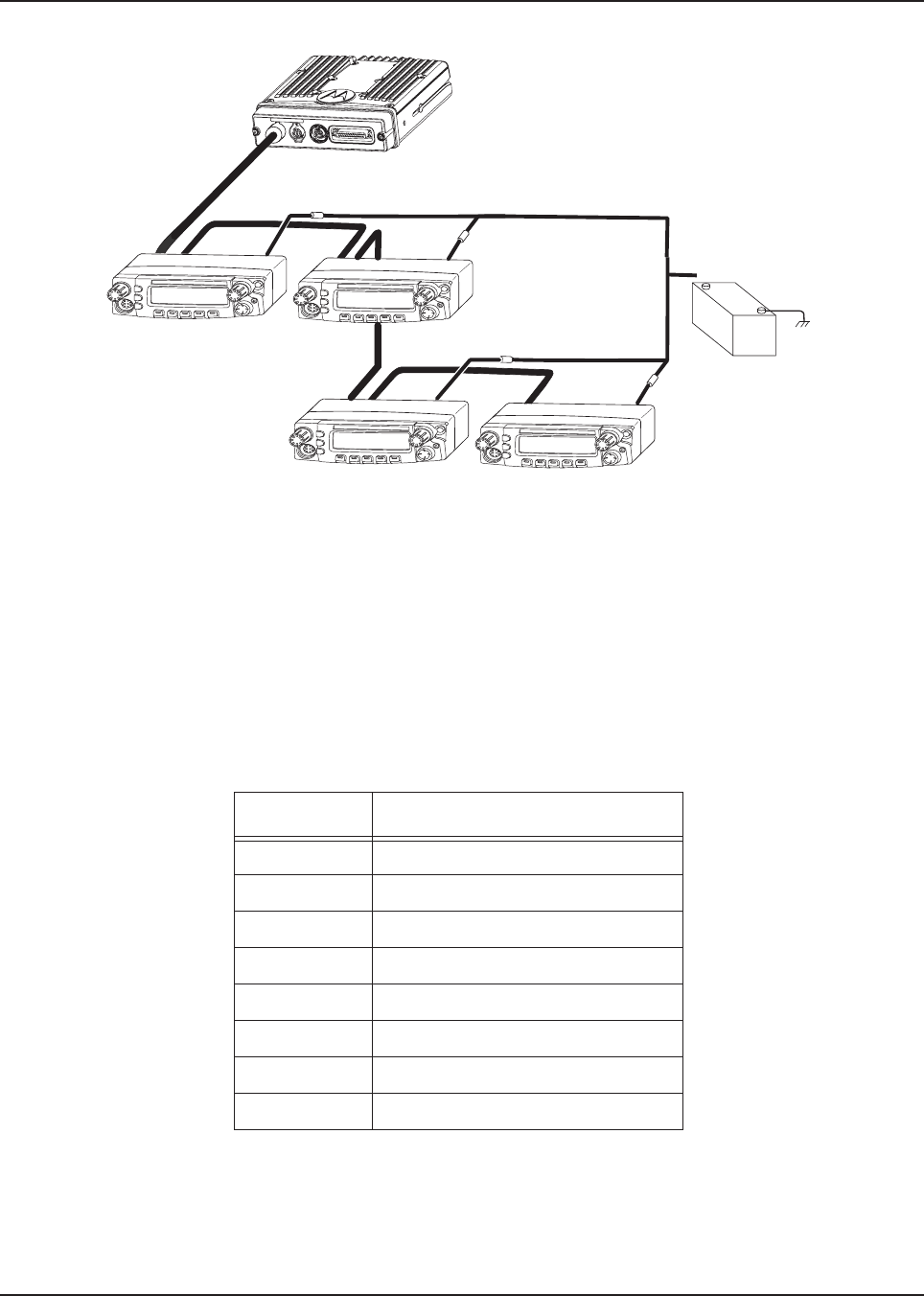
6878215A01
2-28 Standard Configurations Radio Mounting
Figure 2-32. Multiple Control Heads Example Configurations
NOTE: In Multiple Control Head (MCH) installations, the yellow ignition sense wire must be
connected to the head assigned ID # 1. See Section 2.2.2.5 “Setting the Initial Control Head
ID” on page 2-29 for further information.
Use the most convenient configuration for your installation, ensuring that the combined cable lengths
do not exceed 131 feet (40 meters). See Table 2-7 for a list of available CAN cable lengths. Control
head ground, power and ignition sense wires (black, red, and yellow respectively) may need
additional length (not supplied) in installations that locate the head more than 10 feet from a power
source.
Table 2-7. Available CAN Cables
Part Number Description
HKN6164_ Cable, Remote Mount, 40m (131ft)
HKN6165_ Cable, Remote Mount, 35m (115ft)
HKN6166_ Cable, Remote Mount, 23m (75ft)
HKN6167_ Cable, Remote Mount, 15m (50ft)
HKN6168_ Cable, Remote Mount, 9m (30ft)
HKN6169_ Cable, Remote Mount, 5m (17ft)
HKN6170_ Cable, Remote Mount, 3m (10ft)
PMLN4958_ Cable, O3 Extension, 5m (17ft)
Control Head 1 Control Head 2
J300R J300R
J200 J200
J300L J300L
(-)
RED LEAD
(+)
BATTERY
FUSE
FUSE
FUSE
FUSE
Control Head 3 Control Head 4
J300R
J200 J200
J300L
J300R
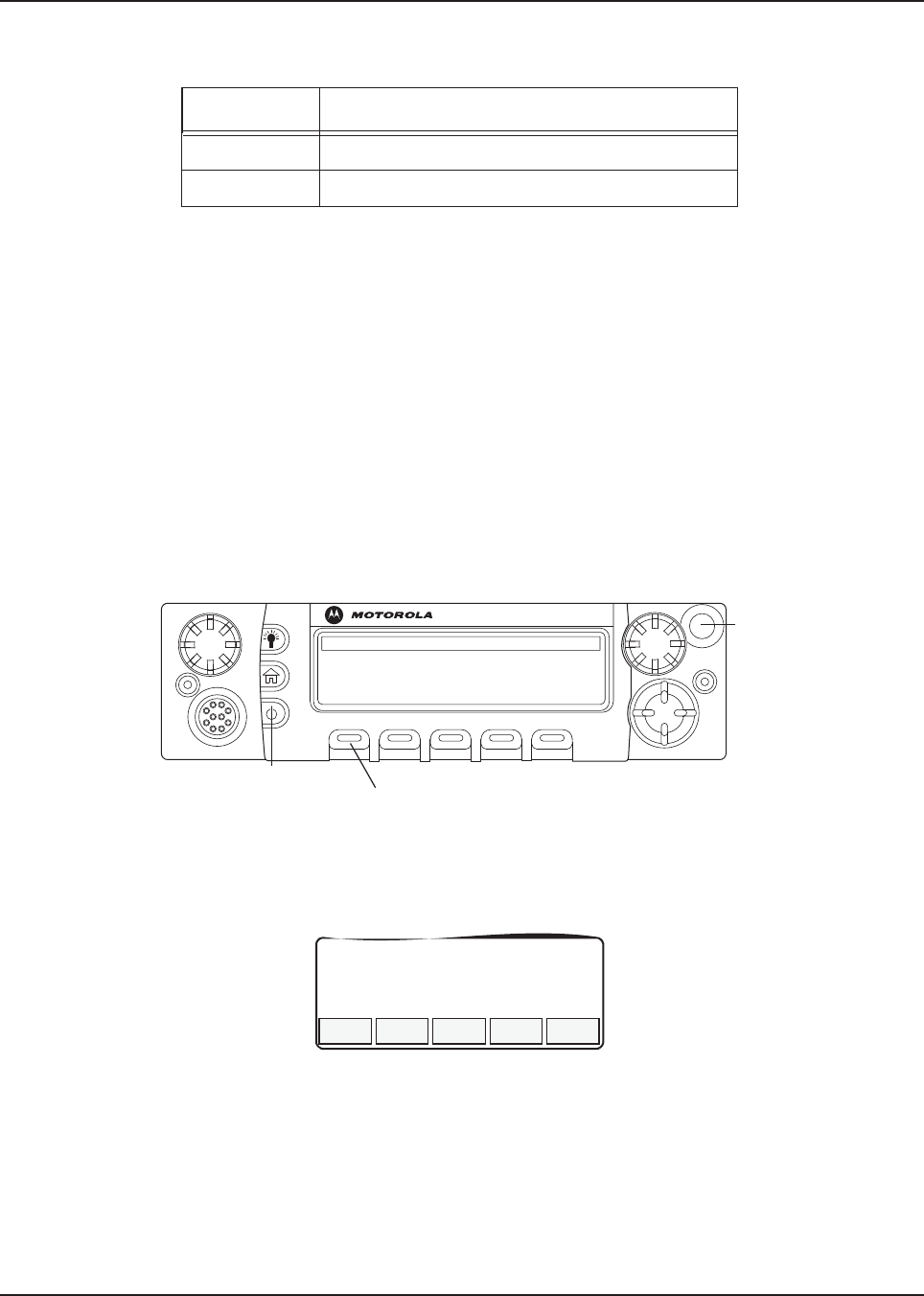
6878215A01
Standard Configurations Radio Mounting 2-29
2.2.2.4 Cable Installation
Route the cables where they are protected from pinching, sharp edges or crushing. Use grommets in
any holes where the cable passes through metal panels. Figure 2-19 shows how the cables and
components are connected. It is not recommended to route cabling or wiring inside the wheel wells
of a vehicle.
2.2.2.5 Setting the Initial Control Head ID
The Front Panel Programming (FPP) mode allows you to define which control head in a Multi Control
Head system becomes control head number 1-4.
Set the control head ID number for each attached head the first time Multi Control Head is used.
1. Press the power button to power off the radio.
2. Press and hold left-most menu and the orange button on the control head simultaneously.
Figure 2-33. APX Mobile O5 Control Head Front View
3. Press the power button to power on the control head. The head will power on into FPP mode
and display the current control head ID number:
Figure 2-34. Radio Display with Current Control Head ID
4. Turn the Mode knob to change the control head’s ID number.
Table 2-8. Ignition Interface Cables
Part Number Description
HLN6863_ Cable, M.A.P. 26pin with Only Ignition and SPK
PMLN4959_ Cable, Y-Splitter with DB-25 and M.A.P. Interface
O5
Left-most
Menu Button
Power Button
Emergency
Button
CH ID#
1
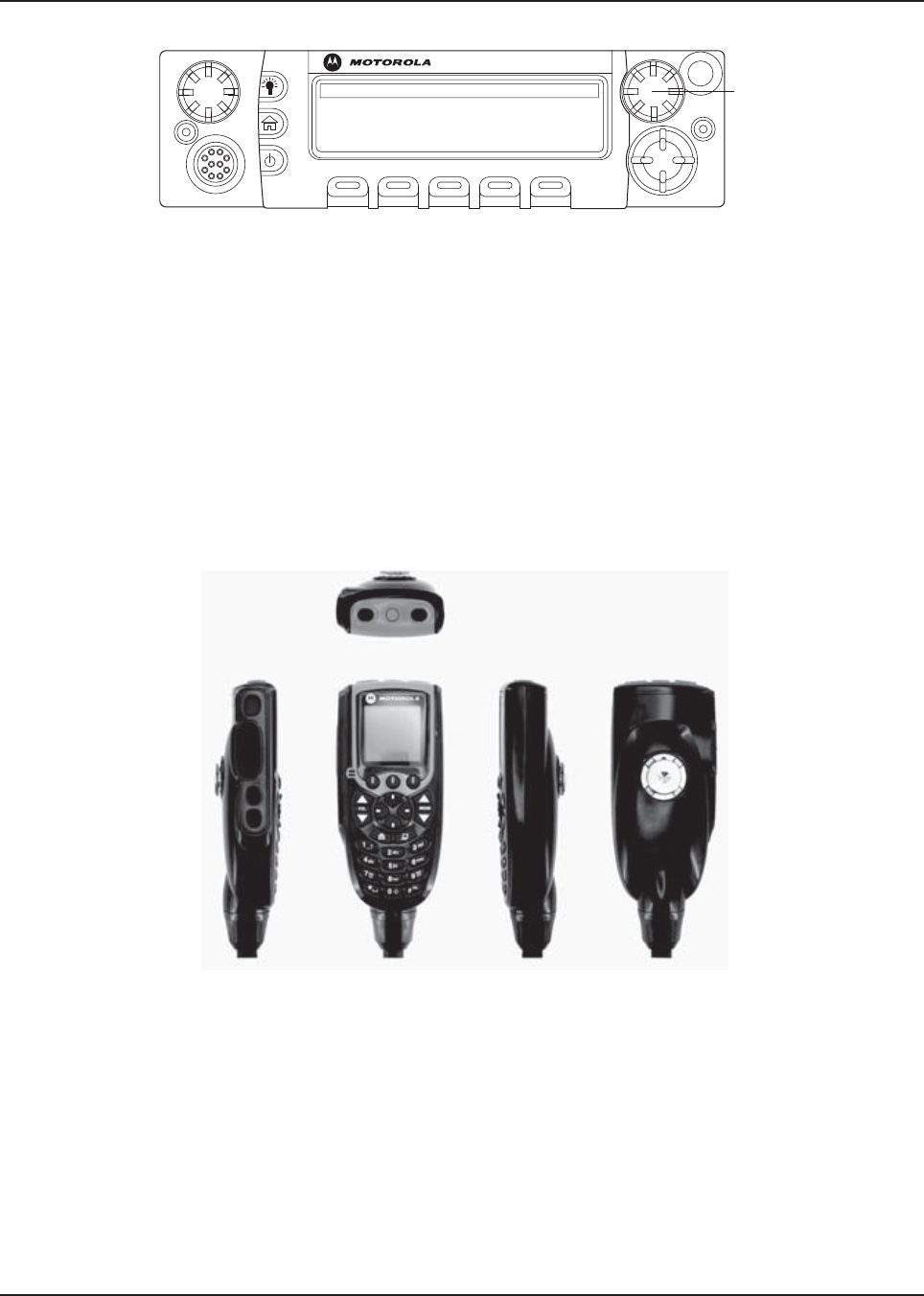
6878215A01
2-30 Standard Configurations Radio Mounting
Figure 2-35. APX Mobile O5 Control Head Front View – Mode Knob
5. Repeat steps 1 to 4 above to set the ID of the remaining control heads.
NOTE: In Multiple Control Head (MCH) installations, the yellow ignition sense wire must be
connected to the head assigned ID # 1.
2.2.2.6 O3 Control Head and Remote Mount Cabling
Choose a mounting location for the radio, considering accessibility, and control and antenna cable
lengths. The control head extension cable and the accessories cable should be installed and routed
properly to avoid complications. Route the cables in the vehicle’s wiring troughs (where available) or
route the cables where they are protected from pinching, sharp edges, or crushing. One suggested
route is along one side of the driveshaft hump under the carpet. Use grommets in any holes where
the cable passes through metal panels.
Figure 2-36. O3 Control Head
The recommended mounting surface for the control unit is on the center console. Figure 2-38 shows
how the hang-up clip control head, and cables should be installed for the O3 control head.
NOTE: Connector-protective covers are provided with the radio. They should be used for added
environmental robustness.
O5
Mode Knob
Top
Front RightLeft Back
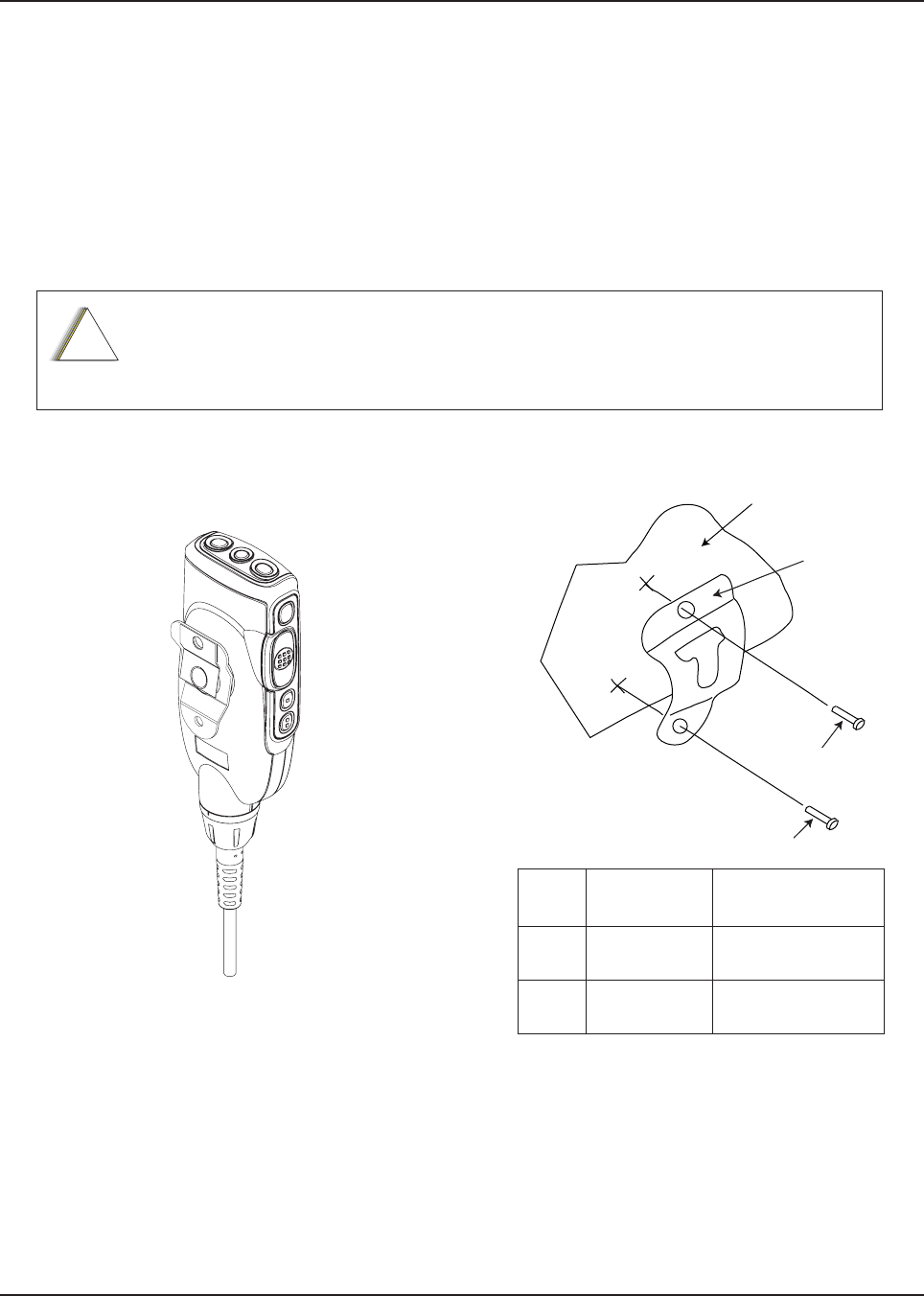
6878215A01
Standard Configurations Radio Mounting 2-31
A mounting clip, which allows the control head to be mounted, is supplied together with the control
head. The installation must not interfere with the operation of the vehicle or its accessories, nor
disturb the passenger seating. The control head must be within convenient reach and viewing of the
user.
Install the mounting clip as follows:
1. Use the provided mounting clip to determine the location of the two screw holes.
2. Drill 7/16” deep holes for upper and lower screws.
3. Use the tapping screw provided to install the mounting clip.
Care must be taken to shield the control head (front and back) from direct exposure to
pressurized water. The pressurized water from a hose, in most cases, is more severe
than the stated test and conditions in typical environments.
Figure 2-37. O3 Control Head Rear View Figure 2-38. Hang-Up Clip Installation
Exploded View
!
C a u t i o n
VEHICLE
DASHBOARD
2
2
1
2
2
1
Vehicle Mounting Surface
Item
No. Part Number Description
1 01-80743T91 Mic Hang-Up Clip
Assembly
2 03-07644M19 Screw, Machine,
8-32 x 7/16
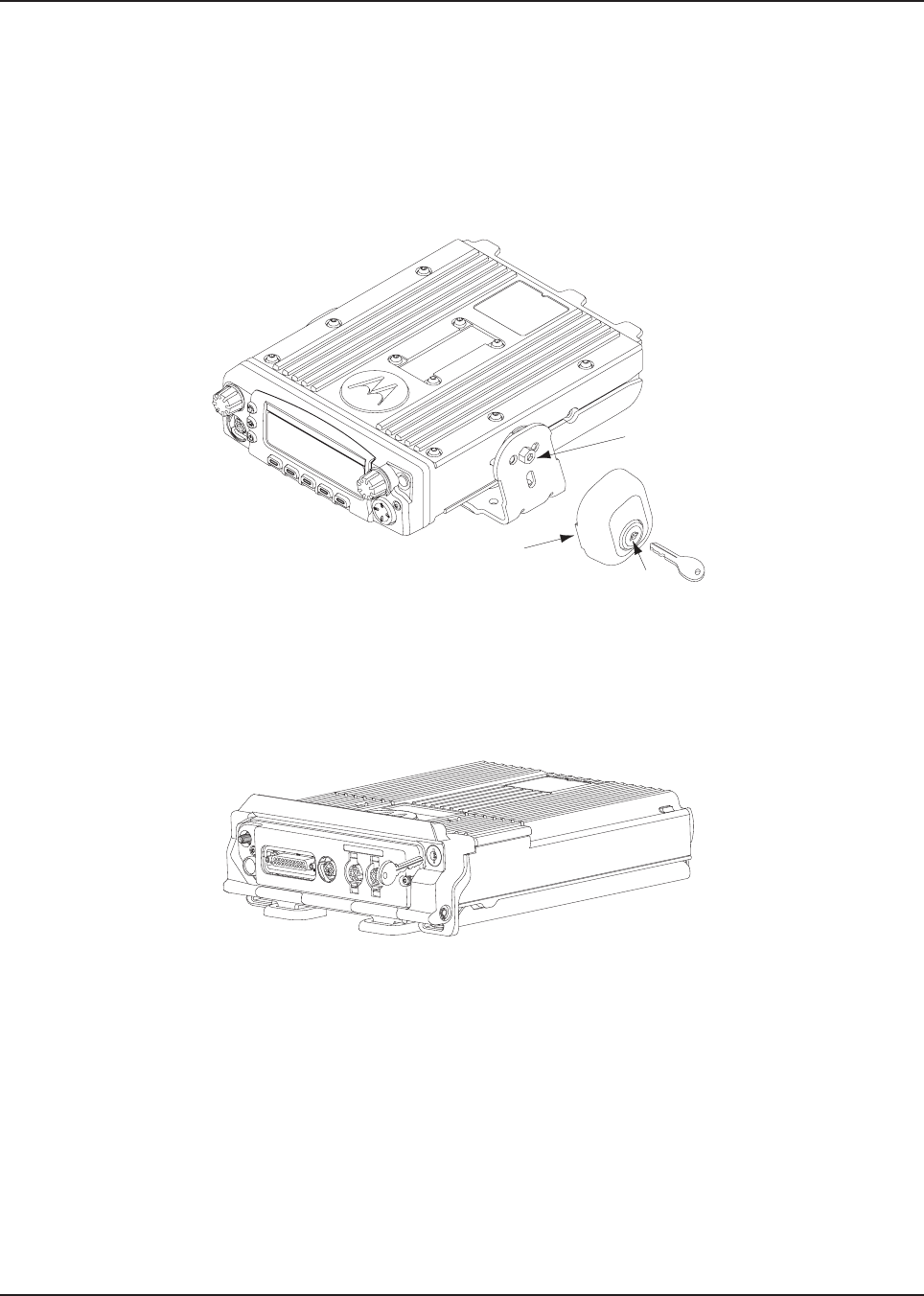
6878215A01
2-32 Standard Configurations Radio Mounting
2.2.3 Locking Kit (Optional)
2.2.3.1 All Radios Except 100W
If an optional locking kit (HLN6372_) is used (shown in Figure 2-39), position the lock housing on the
trunnion after installing the radio mounting screws. Then rotate the lock with the key in it and remove
the key to lock the radio. You can install the lock on either side of the radio, and in dash and remote
mount installations.
Figure 2-39. Locking Kit (Optional) (Cannot Be Used for 100W Radios)
2.2.3.2 100W Radios
An integral lock is included with all 100W radios. The use of a key is only required to unlock the radio
(see Figure 2-40).
Figure 2-40. Lock Supplied with 100W Quick Release Trunnion
Lock
Lock
Housing
Existing
Mounting
Screw
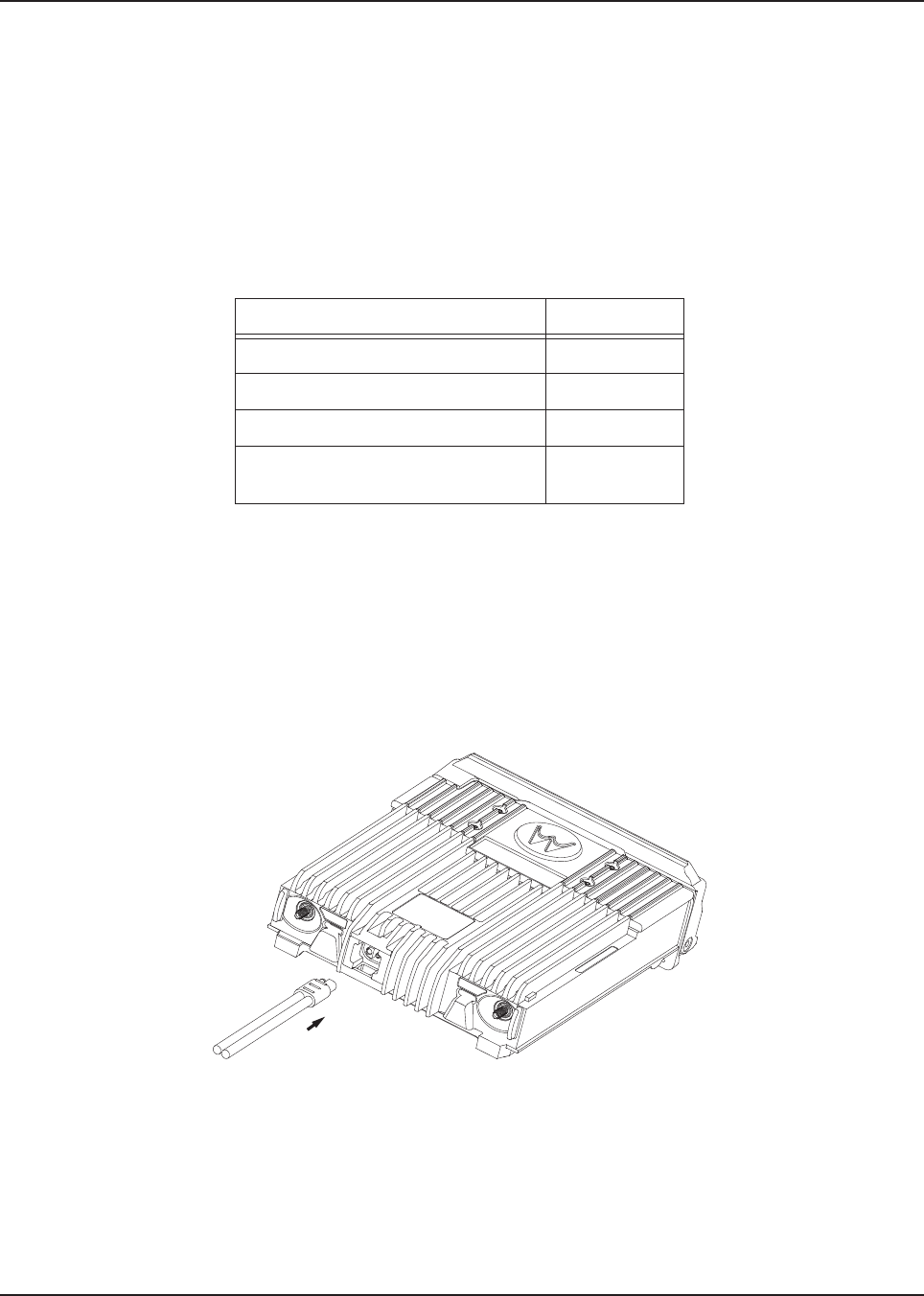
6878215A01
Standard Configurations Power Cables (Transceiver and Control Head) 2-33
2.3 Power Cables (Transceiver and Control Head)
Route the RED power cable from both the radio and the control head to the vehicle’s battery
compartment, using accepted industry methods and standards. Be sure to grommet the firewall hole
to protect the cable. Remove the 15-amp (part number 6580283E06), 20-amp (part number
6580283E07) or 30-amp (part number 6580283E09) fuse from the fuseholder and connect the red
lead of the radio power cable to the positive battery terminal using the hardware provided as shown
in Figure 2-46 and Figure 2-47. Connect the black lead to a convenient solid chassis ground point.
DO NOT connect the black lead directly to the battery’s negative terminal.
NOTE: Remote Control Head power cable uses a 5A Fuse (part number 6580283E03).
2.3.1 Optional Locking Feature for High Power Chassis Power Cables
An optional clip (HLN7017_) can be used to increase DC cable retention in the high power radios.
Directions for assembly and disassembly are:
1. Install the DC cable to the radio by aligning the male and female portions of the battery side
with the mating components on the radio side.
Figure 2-41. Bracket Installation
Table 2-9. Power Cables
Description Part Number
Mid Power Dash Mount HKN4191_
Mid Power Remote Mount HKN4192_
High Power Remote Mount HKN6110_
O5, O7, and O9 Remote Control
Head Power Cable
HKN6188_
(1)
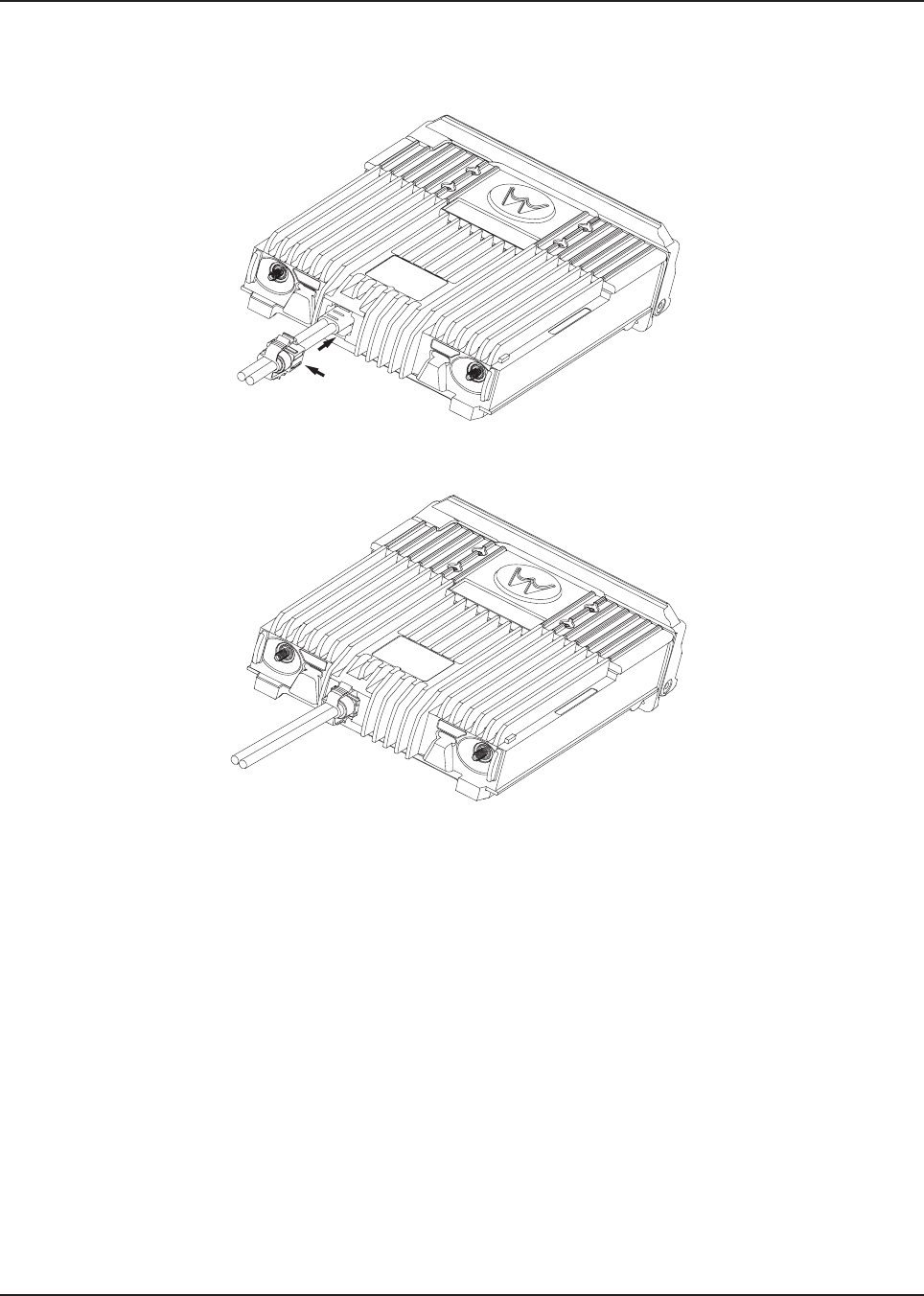
6878215A01
2-34 Standard Configurations Power Cables (Transceiver and Control Head)
2. Insert the locking bracket (HLN7017_) onto the DC cable.
3. Slide the bracket toward the radio until the bracket clips snap onto the radio features.
Figure 2-42. Bracket Installation
Figure 2-43. Bracket Installation (Assembled State)
(3)
(2)
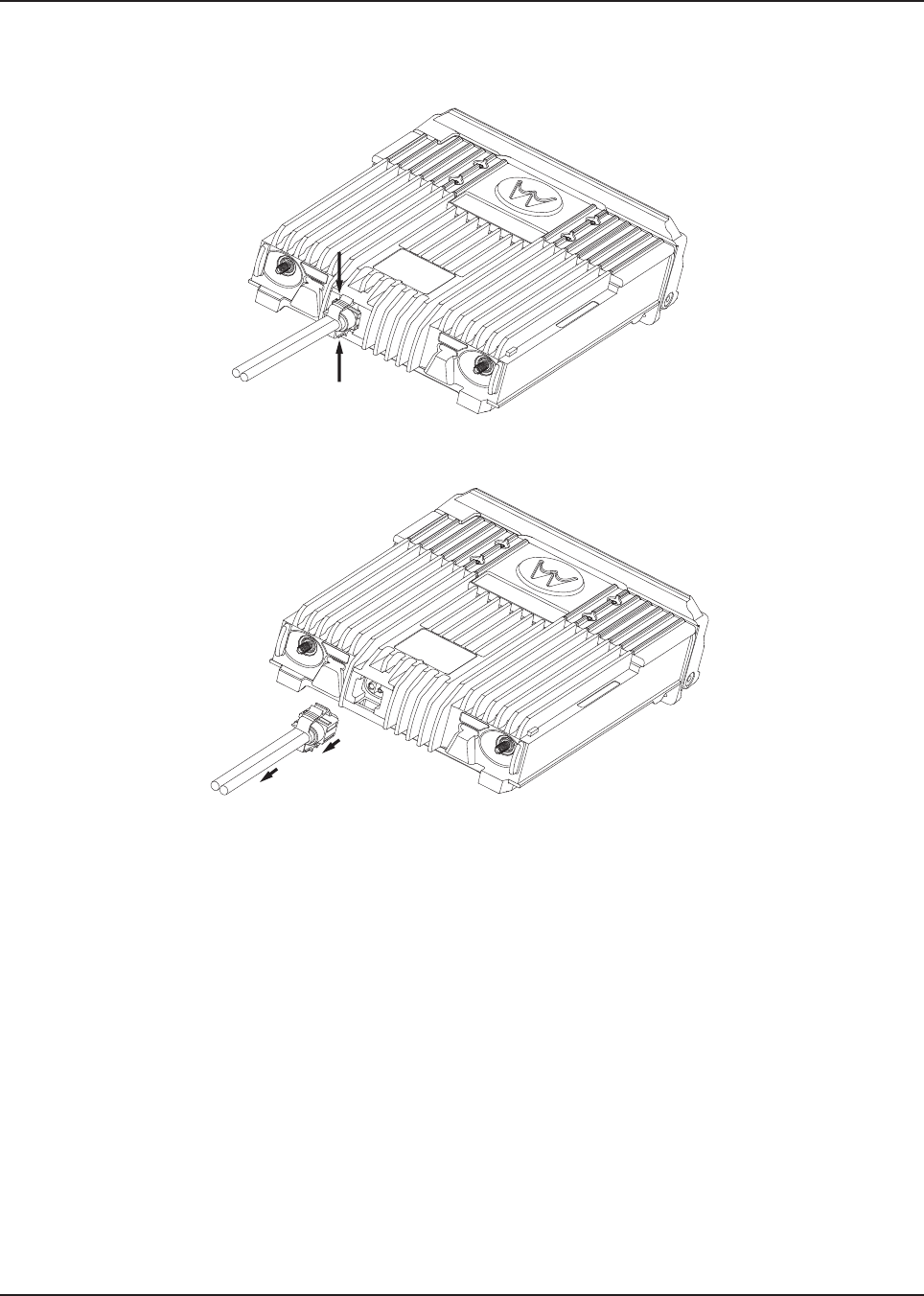
6878215A01
Standard Configurations Power Cables (Transceiver and Control Head) 2-35
4. To disassemble the power cable, squeeze the locking bracket clips inward and while
squeezing the clips, pull the locking clip and power cable to remove the power cable.
Figure 2-44. Bracket Uninstallation
Figure 2-45. Bracket Uninstallation
(4)
(5)
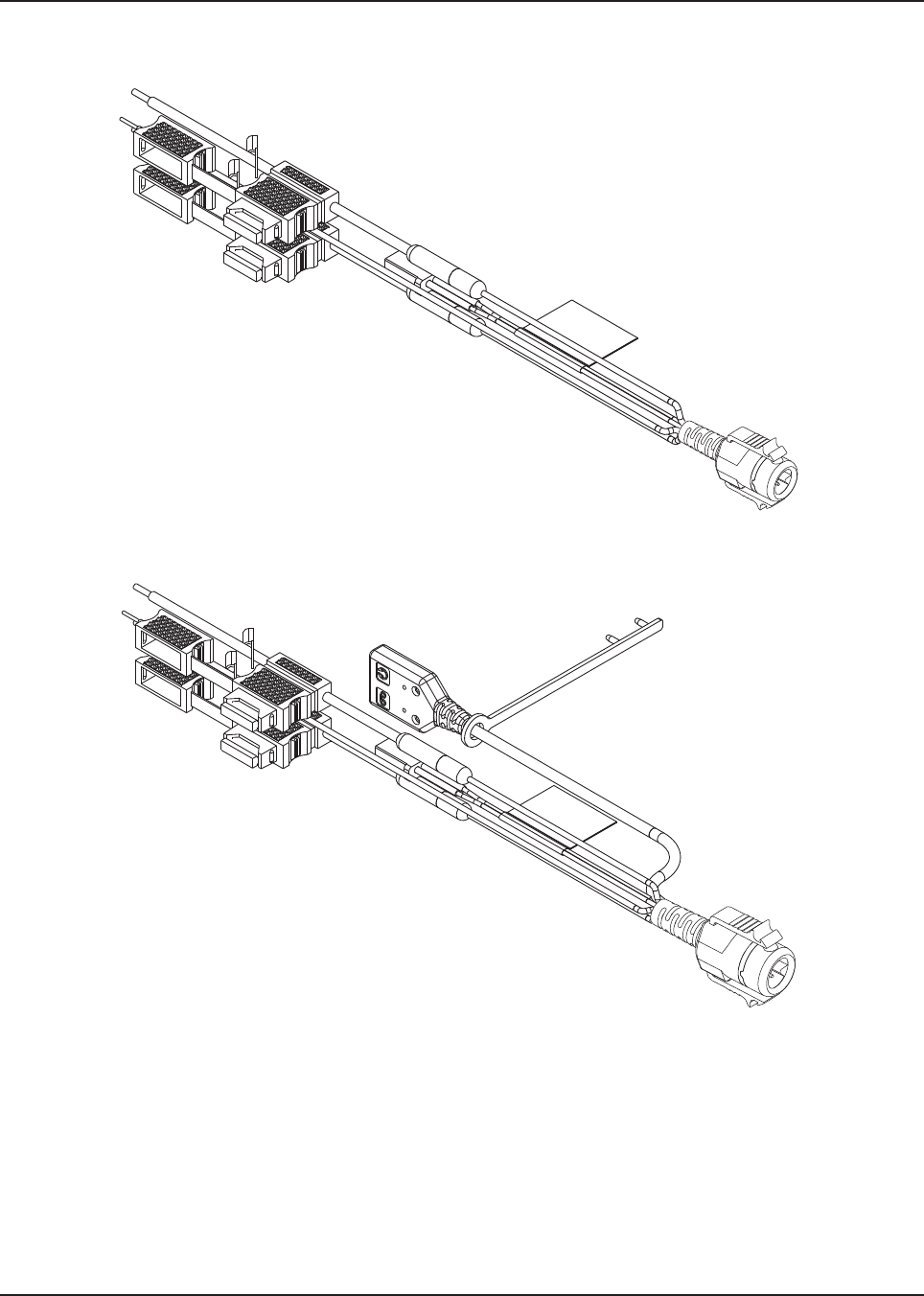
6878215A01
2-36 Standard Configurations Power Cables (Transceiver and Control Head)
2.3.2 O2, O5, O7 or O9 Control Head Power Cables
Figure 2-46. HKN6188_ Power Cable with External Speaker Connector
Figure 2-47. HKN6187_ Power Cable with External Speaker Connector, Record
Audio Output Jack (2.5 mm) and Earphone Jack (2.5 mm)
NOTE: Audio Out – Does not require CPS programming. Attaching a headset will mute the external
speakers of the radio which are attached at the SPK jack of the control head.
Record Out – Requires CPS programming. In CPS, navigate to Radio Wide/Advanced/
Record Audio and select TX + RX Audio.
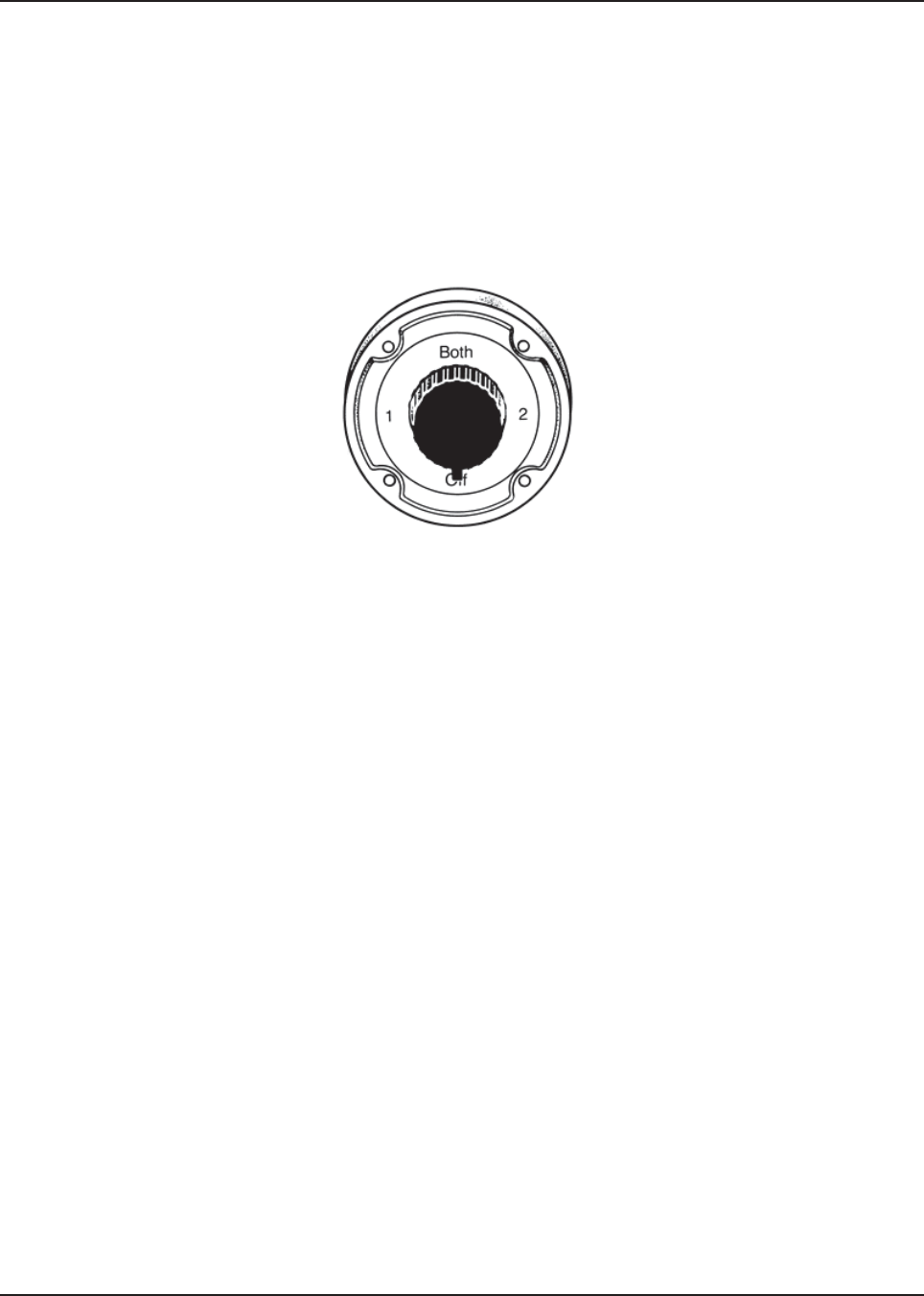
6878215A01
Standard Configurations Power Cables (Transceiver and Control Head) 2-37
2.3.3 Battery Selector Switch
In vehicles which have installed a Battery Selector Switch, the ignition sense (yellow) wire should be
the only wire connected to the battery selector switch (see Figure 2-48). Radio transceiver and
control head power wires (red) must be connected directly to the vehicle battery. If the control head
power wire and the control head ignition sense wire are both connected to a battery selector switch,
but the radio transceiver power lead is not, improper power-cycling and off-state battery drainage
may occur. If the desired state of the radio is a total battery drain elimination, then all power and
ignition sense wires must be routed through the battery selector switch, so that the control head and
radio transceiver both see the loss of battery power at the same time.
Figure 2-48. Battery Selector Switch

6878215A01
2-38 Standard Configurations Antenna Installation
2.4 Antenna Installation
IMPORTANT: To assure optimum performance and compliance with RF Energy Safety
standards, these antenna installation guidelines and instructions are
limited to metal-body vehicles with appropriate ground planes and take
into account the potential exposure of back seat passengers and
bystanders outside the vehicle.
NOTE: For mobile radios with rated power of 7 watts or less, the only installation restrictions are to
use only Motorola approved antennas and install the antenna externally on metal body
vehicles. For mobile radios with tuned power greater than 7 watts, always adhere to all the
guidelines and restrictions in Section 2.4.1 below.
2.4.1 Selecting an Antenna Site/Location on a Metal Body Vehicle
1. External installation – Check the requirements of the antenna supplier and install the
vehicle antenna external to a metal body vehicle in accordance with those requirements.
2. Roof top – For optimum performance and compliance with RF Energy Safety standards,
mount the antenna in the center area of the roof.
3. Trunk lid – On some vehicles with clearly defined, flat trunk lids, the antennas of some radio
models (see restrictions below) can also be mounted on the center area of the trunk lid. For
vehicles without clearly defined, flat trunk lids (such as hatchback autos, sports utility
vehicles, and pick-up trucks), mount the antenna in the center area of the roof.
Before installing an antenna on the trunk lid,
- Be sure that the distance from the antenna location on the trunk lid will be at least 85 cm
(33 inches) from the front surface of the rear seat-back to assure compliance with RF
Energy Safety standards.
- Ensure that the trunk lid is grounded by connecting grounding straps between the trunk lid
and the vehicle chassis.
4. Mounting restrictions for certain radio models.
For all VHF and UHF models, the 1/4 wave antenna should be mounted only in the center
area of the roof, not on the trunk lid, to assure compliance with RF Energy Safety
standards.
5. Ensure that the antenna cable can be easily routed to the radio. Route the antenna cable as
far away as possible from any vehicle electronic control units and associated wiring.
6. Check the antenna location for any electrical interference.
If these conditions cannot be satisfied, then mount the antenna on the roof top.
!
C a u t i o n
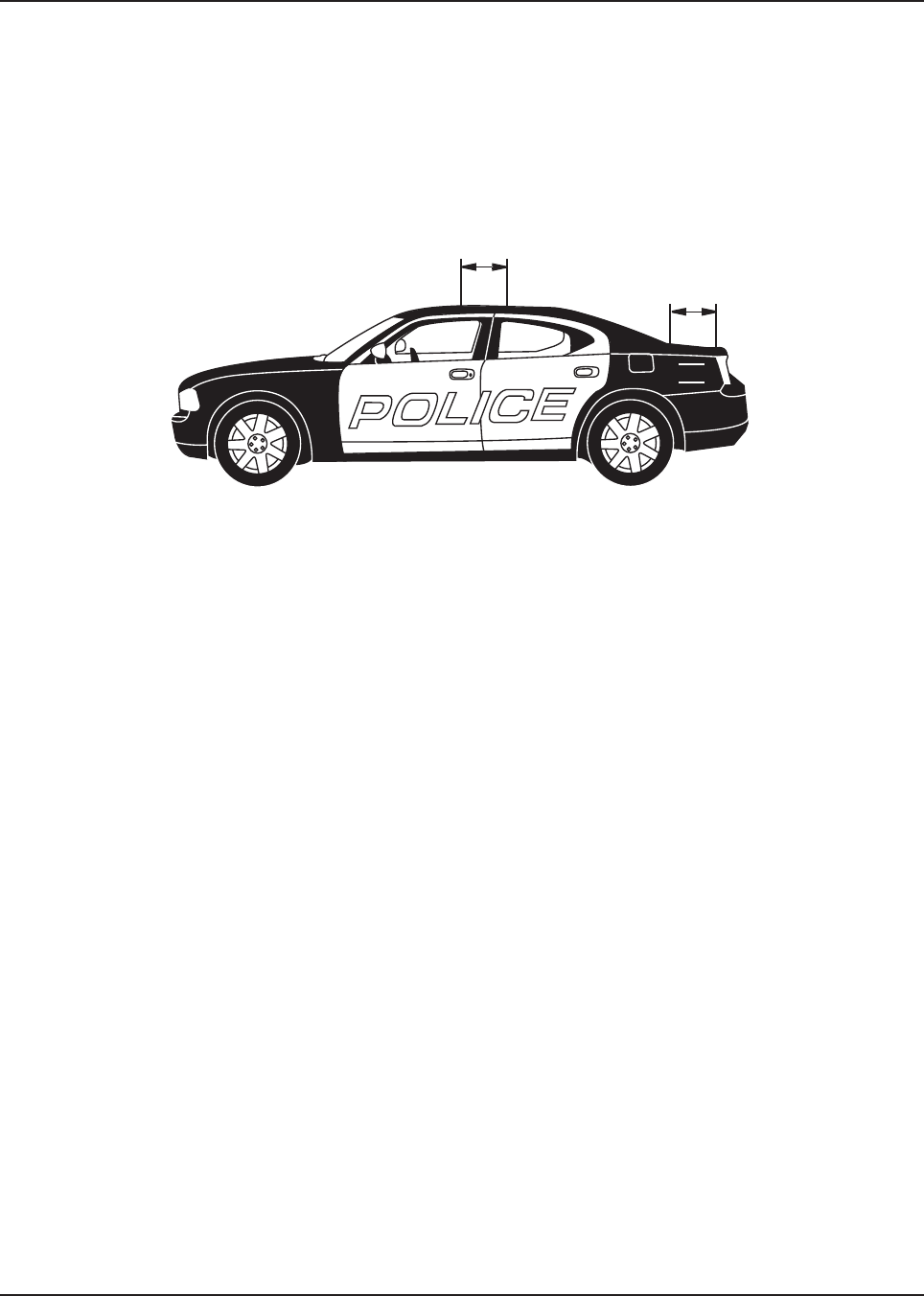
6878215A01
Standard Configurations Antenna Installation 2-39
7. Ensure that any transmitting radio antennas on this vehicle are separated from each other by
at least 3 feet (0.9 meter). See Figure 2-49.
8. The minimum distance between the antenna and the radio/accessories should be at least
3 feet (91.44 cm).
NOTE: Any two metal pieces rubbing against each other (such as seat springs, shift levers, trunk and
hood lids, exhaust pipes, etc.) in close proximity to the antenna can cause severe receiver
interference.
Figure 2-49. Multiple Antennas Separation
911
3 ft3 ft
3 ft
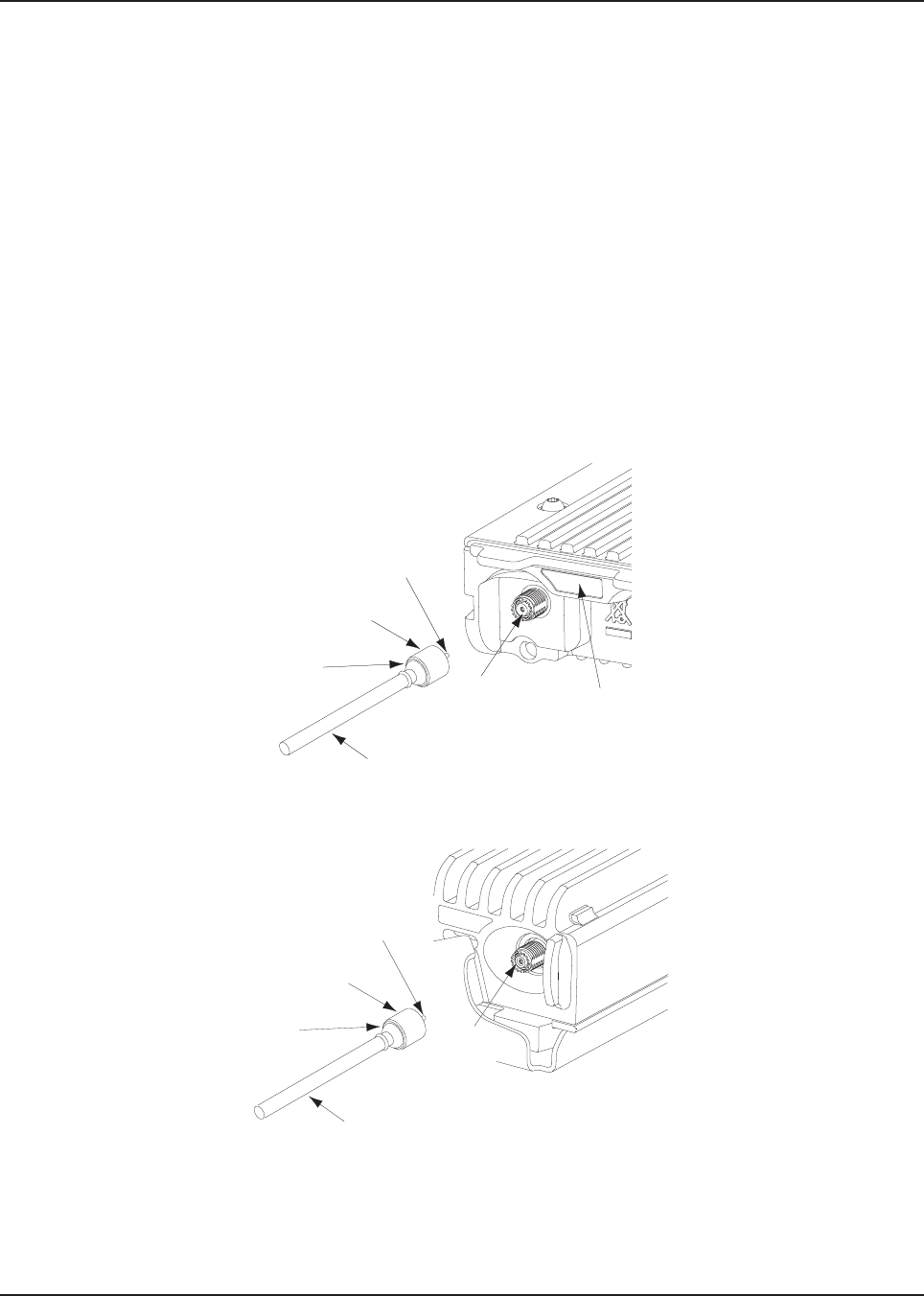
6878215A01
2-40 Standard Configurations Antenna Installation
2.4.2 Mini-UHF Connection
To help aid in the installation of the radio antenna(s), there are labels indicating the frequency. The
first is on the FCC label at the top of the radio which calls out the frequency and by using arrow
points, which side the RF connector of the frequency is located at the back of the radio. The second
is located at the back of the radio, next to the RF connector(s) (see Figure 2-50). To ensure a secure
connection of an antenna cable's mini-UHF plug to a radio's mini-UHF jack, their interlocking
features must be properly engaged. If they are not properly engaged, the system will loosen. Using a
tool (pliers or wrench) will not overcome a poor engagement, and is not recommended.
NOTE: Applying excessive force with a tool can cause damage to the antenna or the connector
(e.g., stripping threads, deforming the collar or connector, or causing the connector to twist in
the housing opening and break).
The mini-UHF connector tool (Motorola part number HLN6695_) is designed to securely tighten the
antenna plug–radio jack connection without damaging either the plug or the jack.
Motorola recommends the following sequence to ensure proper attachment of the system
(see Figure 2-50 and Figure 2-51):
Figure 2-50. Mini-UHF Connection (As Shown on Mid Power)
Figure 2-51. Mini-UHF Connection (100W Radios Only)
1. Make sure that there is sufficient slack in the antenna cable.
2. Make sure that the collar of the antenna cable plug is loose and does not bind.
3. Make sure that the mini-UHF jack is tight in the radio housing.
Coax Conductor
Plug (Pin)
Flange
Cable
Collar Pulled
Back to Flange
Mini UHF
Jack RF Antenna
Connector Label
Coax Conductor
Plug (Pin)
Flange
Cable
Collar Pulled
Back to Flange
Mini UHF
Jack
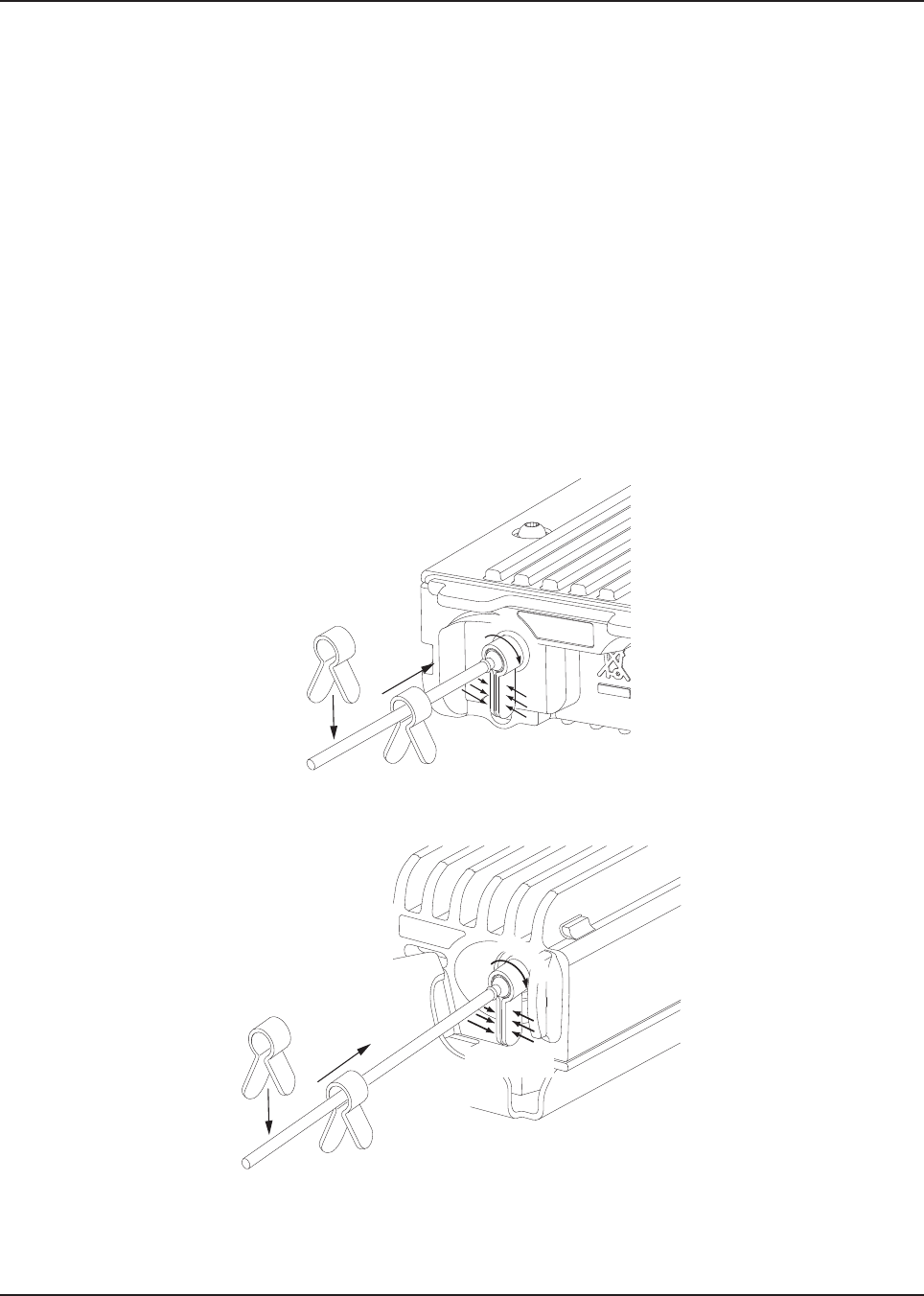
6878215A01
Standard Configurations Antenna Installation 2-41
4. Slide the collar back against the flange. Insert the antenna cable plug’s pin fully into the radio
jack, but do not engage the threads.
5. Ensure that the plug’s and jack’s interlocking features are fully seated. Check this by grasping
the crimp on the cable jack, rotating the cable, and noting any movement. If the features are
seated correctly, there should be NO movement.
6. Finger-tighten the antenna cable plug’s collar onto the radio’s jack.
7. Give a final tug, by hand, to the collar, and retighten by hand as firmly as possible.
8. Slip the mini-UHF connector tool over the coaxial cable, using the gap between the tool’s legs
(see Figure 2-52). Then, slide the tool up onto the plug’s knurled collar. Squeeze the two
straight legs of the tool firmly together between your thumb and index finger and turn
clockwise (as shown) to tighten the collar. It should take 1/4 turn or less. When you feel the
tool slipping on the collar, the connection has been properly tightened. The tool can also be
used to loosen a tight collar.
NOTE: DO NOT use pliers or any other device to grip the tightening tool. It has been designed to
allow you to achieve the proper torque on the collar without overtightening. Overtightening the
collar can damage the connector and the radio.
Figure 2-52. Mini-UHF Connector Tool (As Shown on Mid Power)
Figure 2-53. Mini-UHF Connector Tool (100W Radios Only)
(1) Squeeze
Firmly Together
HLN6695_
(
2
)
T
i
g
h
t
e
n
(1) Squeeze
Firmly Together
HLN6695_
(
2
)
T
i
g
h
t
e
n
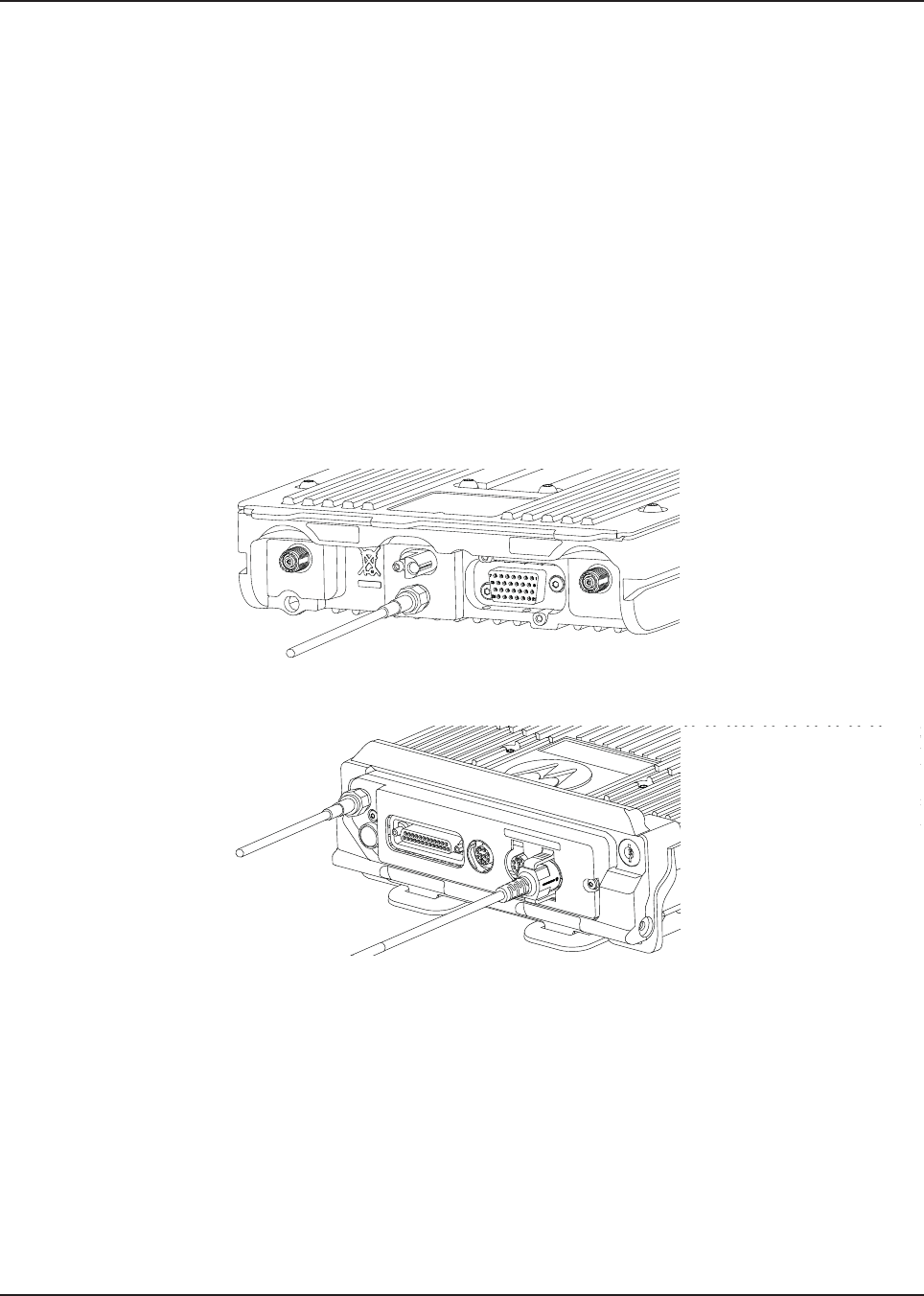
6878215A01
2-42 Standard Configurations Antenna Installation
2.4.3 GPS Antenna Placement
The GPS antenna (excluding the Motorcycle GPS antenna) must be placed at least, 3 feet
(0.9 meters) away from any transmitting antenna, and the antenna must have a clear, unobstructed
view of the sky for best performance. The length of the cabling must be taken into consideration
before the installation is started.
2.4.4 GPS Connection
To ensure a secure connection of the GPS antenna cable's SMA plug to a radio's SMA jack, the
connector must be fully seated. If the connectors are not fully seated, the system will loosen. This
should be done by hand to ensure excess force is not applied. GPS positions as shown in
Figure 2-54 and Figure 2-55 are located in different positions. The mid power radio has the GPS
antenna connector on the back of the radio while the 100W radio has the antenna connector on the
front of the radio.
NOTE: Applying excessive force with a tool can cause damage to the antenna or the connector
(e.g. stripping threads, deforming the collar or connector, or causing the connector to twist in
the housing opening and break).
Figure 2-54. GPS Antenna Connector on the Back of the Mid Power Radio
Figure 2-55. GPS Antenna Connector on the Front of the 100W Radio
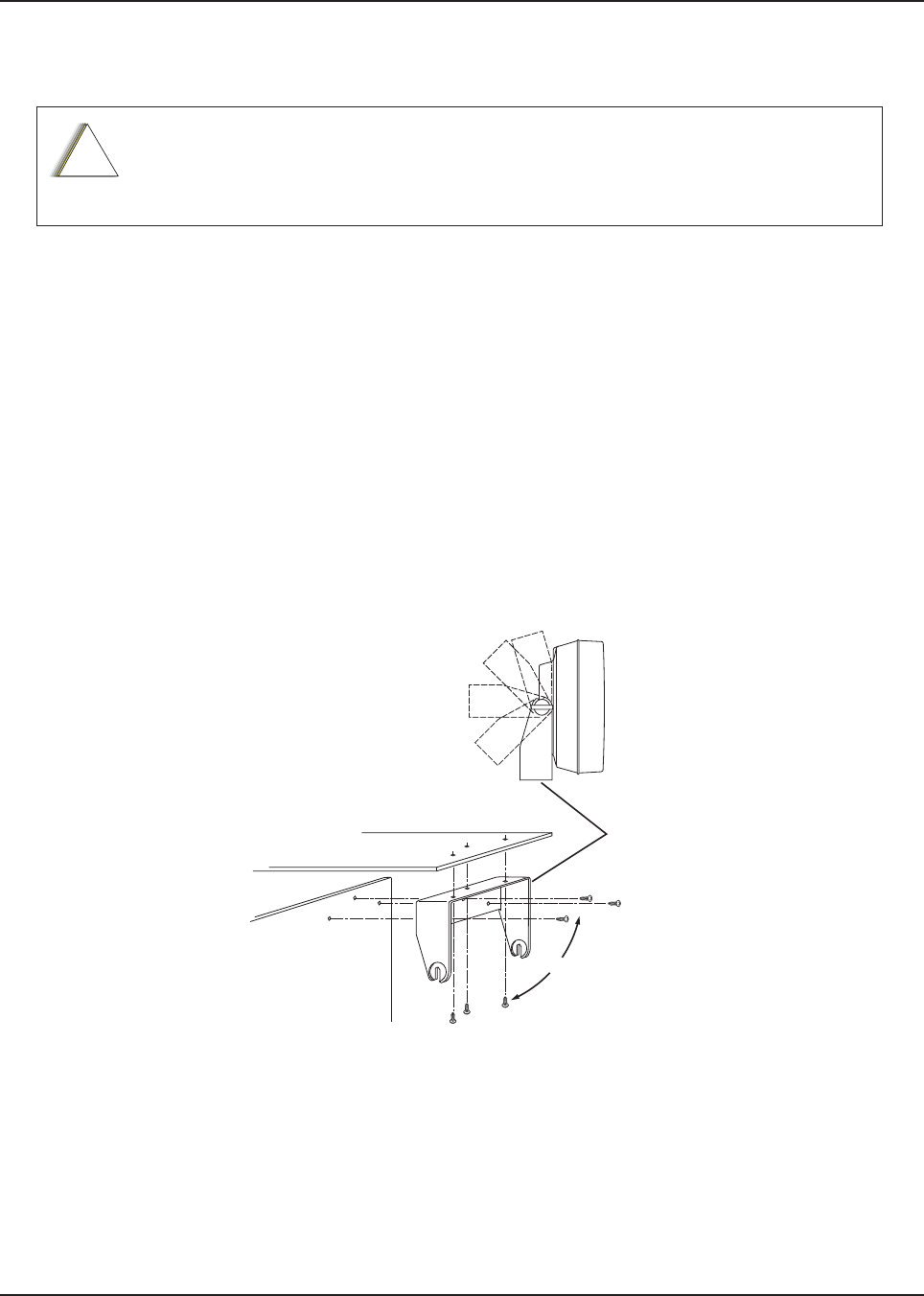
6878215A01
Standard Configurations Speaker 2-43
2.5 Speaker
The speaker kit includes a trunnion bracket that allows the speaker to be mounted in a variety of
ways. With the trunnion bracket, the speaker can mount permanently on the mounting surface or in
accessible firewall areas. The trunnion allows the speaker to tilt for best operation. Mount the
speaker out of the way so that it will not be kicked or knocked around by the vehicle occupants.
Mount the speaker as follows:
1. Use the speaker mounting bracket as a template to mark the mounting hole locations.
2. Use the self-drilling screws provided to fasten the trunnion.
3. Attach the speaker and fasten to the trunnion with two wing screws.
4. Route the speaker wires under the carpet or floor covering, or behind the kick panels. Be sure
the wires are out of the way and will not be snagged and broken by the occupants of the
vehicle.
5. Do not submerse the 2-pin speaker connector in water nor place this connector in an area
that could have standing water.
Figure 2-56. Speaker Mounting
DO NOT ground the radio's speaker leads. This system has a floating speaker output
(DC voltage on both leads); damage to the audio circuit will result if either lead is
grounded or if they are shorted together.
!
C a u t i o n
Dashboard
Firewall
Trunnion
Bracket
OR
MAEPF-25764-O